g
TM and copyright Wizards of the Coast
From www.artofmtg.com
Contents
-
1Introduction
-
2Part 1
-
3Degree of Success
-
3Stacking Advantage and Disadvantage
-
4Ability Checks
-
5Saving Throws
-
6Combat
-
8Damage and Healing
-
11Spellcasting
-
13Part 2
-
14Tactical Combat
All art is property of their respective artists and/or Wizards of the Coast and was sourced from www.artofmtg.com. Design, layout features & page graphics are copyright 2021 by GM Binder (We Write Code) and used under the Terms of Service. This is unofficial Fan Content permitted under the Fan Content Policy. Not approved/endorsed by Wizards of the Coast. Portions of the materials used are property of Wizards of the Coast. ©Wizards of the Coast LLC.
This work includes material taken from the System Reference Document 5.1 (“SRD 5.1”) by Wizards of the Coast LLC and available at dnd.wizards.com/resources/ systems-reference-document. The SRD 5.1 is licensed under the Creative Commons Attribution 4.0 International License available at creativecommons.org/licenses/by/4.0/legalcode.
DUNGEONS & DRAGONS, D&D, Wizards of the Coast, and all other Wizards of the Coast product names, and their respective logos are trademarks of Wizards of the Coast in the USA and other countries.
- 15Melee Reach and Space
- 16Ranged Attack Into Melee
- 16Called Shot
- 16Strength and Damage
-
17Magic Options
-
19Equipment
-
24Crafting Magic Items
-
25Feats
-
31Part 3
-
32Appendix A: Variant Sorcerer
-
33Appendix B: Blinkstep Rogue
-
35Appendix C: Bounded Accuracy
-
36Appendix D: Arcane Melee
-
38Appendix E: Character Options
-
40Part 4
-
41The Archive
All other original material, except where another source is cited, is copyright 2021 by Rules.Mechanic@gmail.com and is open licensed under Creative Commons CC BY 4.0.
You can find the latest version of this handbook free on GM Binder, along with previous versions (1.0, 2.0, 3.0, 3.5 & 5.0) and a Level Up: A5E edition (LU: A5E Tome of Variance). Size-optimized PDFs are available free on the Tome of Variance webpage. Nebelun's Pandect of Possibilities, free/PWYW on DMs Guild, is no longer being updated.
Version 5.2013, Dec 2023. 2013 updates include: conversion to CC BY 4.0 SRD license, streamlined casting roll option, opposed rolls (defense, casting), bonus actions, heroic reaction, initiative, armor, encumbrance, bounded accuracy, melee cantrips, ability scores, progression options, various versatility options, and multiple other clarifications and minor tweaks.
As always, feedback very welcome.
Introduction
Welcome to the Tome of Variance (ToV), an independent handbook of variant rules options for the fifth edition of Dungeons & Dragons®† (D&D®†, Wizards of the Coast). Within this tinkerer's tome, core game mechanics are buffed and built on, reconfigured and re-imagined, while keeping the distinctive feel (and compatibility) of fifth edition gameplay.
Adding Optional Depth
The handbook has been designed as a cohesive but modular set of options that add useful depth for both roleplayer and rollplayer, without disrupting compatibility or accessibility. Fairness and balance are central tenets, whilst allowing for different campaign styles: options with a (pseudo) realism approach may suit a grittier campaign; alternative versions may create a more heroic feel.
How to Use This Book
This rulebook is organized into four parts. The first contains core options and mechanics. The second contains additional options for specific circumstances, equipment, or feats. The third is an appendix for more experimental options and the fourth is an archive of useful alternate options from previous editions of the Tome.
If a chapter catches your interest, try it out in a playtest or even a regular session - either as a block, or by picking individual options. Even the more transformative options are designed to be friendly with game balance and involve minimal or no conversion. If they don't catch your interest, or
fail to shine in the playtest, you can leave them and still try some of the other options. Although everything in this ruleset is designed to play well together, each option also stands alone and you can simply select the options that suit your group's taste and style.
Notes on the Tome
My thanks to all the curious experimentalists who pulled this Tome of Variance off the shelf of possibilities, dusted off their shiny click clack maths rocks, and tried out some new twists on the classic rules. I'm stunned that some very big names have picked this up and I've been very proud to see some ToV originals appear in the playtests and rules for some upcoming big name publications.
Thanks to GM Binder for fantastic design tools, and to Wizards of the Coast for their really supportive SRD creative commons release and Fan Content Policy, including stunning artwork.
This project took flight as a by-product of the pandemic, a side-quest during the long campaign against that microscopic BBEG. I hope you enjoy exploring these new options as much as I have enjoyed giving them a home between these pages.
The rules here have been extensively playtested through multiple iterations, but I'll always remain keen to hear about any issues or suggestions; please let me know at Rules.Mechanic@gmail.com (or on "X" @Rules_Mechanic).
If you found this handbook useful, please spread the word. And if you would like to do more, consider a donation to your favorite charity. Charity income has been hit very hard since the pandemic and every bit helps.
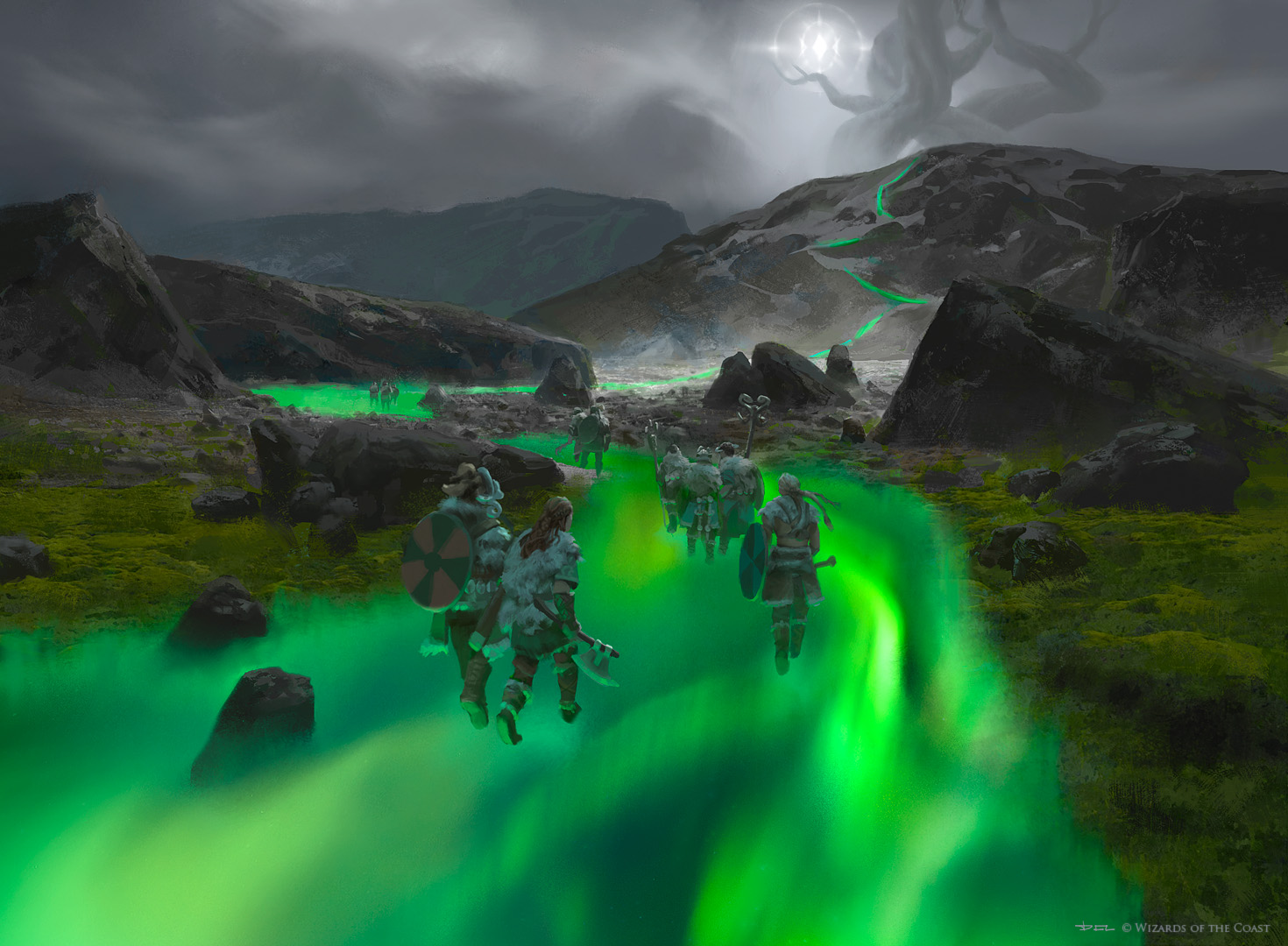

TM and copyright Wizards of the Coast
From www.artofmtg.com
Part 1
Core Options
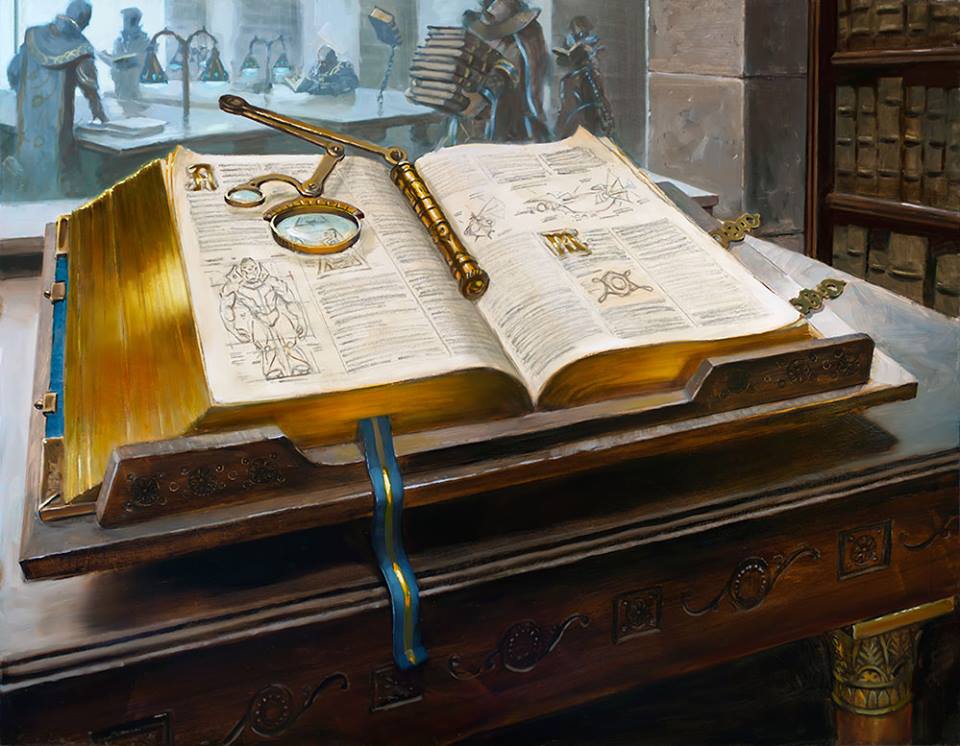

TM and copyright Wizards of the Coast
From www.artofmtg.com
Degree of Success
Degree of success (or failure) is a shared feature of many of the main variant options in this handbook. It's a simple way to add depth by expanding “pass or fail” into a spectrum of outcomes, while also linking skill to the likelihood of achieving the best results. It rewards players for doing what they can to achieve the very best roll, while giving them reason to think twice about risking a botched effort.
This variant builds on the "Degrees of Failure" option in Wizards of the Coast's Dungeon Master's Guide† to provide a standard system for both success and failure across different types of rolls, while preserving the familiar fifth edition mechanic of Difficulty Class (DC) being in tiers of +/- 5. It’s a very intuitive system: rolling much higher than the target results in a much better outcome, rolling much lower results in a much worse outcome. And using steps of +/- 5 keeps the system fast and undemanding.
| Roll | Margin | Outcome |
|---|---|---|
| Fail by 10 or more | 10- | Critical Failure |
| Fail by 5 (5-9) | 5- | Heavy Failure |
| Fail by 1 (1-4) | 1- | Failure |
| Exact roll | 0 | Marginal |
| Succeed by 1 (1-4) | 1+ | Success |
| Succeed by 5 (5-9) | 5+ | Strong Success |
| Succeed by 10 or more | 10+ | Critical Success |
For example, the next table shows the rolls that would lead to each outcome when making a DC 10 or a DC 15 roll. For a
DC 10 roll, after adjusting for any modifiers: a 10 is marginal; above that's a success; from 15 it's a strong success; and from 20 it's a critical success. Similarly, below 10 is a failure; from 5 it's a heavy failure; and from 0 it's a critical failure.
| Adjusted Roll | DC 10 | Adjusted Roll | DC 15 |
|---|---|---|---|
| 0 or less | Critical Failure | 5 or less | Critical Failure |
| 1-5 | Heavy Failure | 6-10 | Heavy Failure |
| 4-9 | Failure | 11-14 | Failure |
| 10 | Marginal | 15 | Marginal |
| 11-14 | Success | 16-19 | Success |
| 15-19 | Strong Success | 20-24 | Strong Success |
| 20 or more | Critical Success | 25 or more | Critical Success |
In playtesting, these tiered outcomes have been immensely popular, both the descriptive flavor and the mechanics. Some outcomes, like heavy failure on an attack roll, don't need a mechanical effect (it's more exciting to move on to the next attack) but even there, a narrative effect was very popular.
Rolling a Natural 1 or 20
Rolling a critical success or critical failure when using degree of success is the equivalent of rolling a natural 20 or a natural 1 with the standard system. In playtesting, the preferred option was to combine the two by keeping the effect of a natural 20 or 1: simply count a roll of 20 as always being a critical success and a 1 as always being a critical failure.
Stacking Advantage and Disadvantage
In the core rules, advantage and disadvantage don’t stack. So advantage from multiple sources is no greater than a single source of advantage. Similarly, if there are multiple sources imposing advantage and disadvantage, then neither apply, even if there are more sources of one than the other.
To stack, you can simply allow multiple sources of advantage and disadvantage to cancel one-for-one. If there are more sources of advantage than disadvantage, then advantage applies, and visa versa. As an additional option, if you are left with multiple advantage (or disadvantage), you may choose to allow additional dice for each.
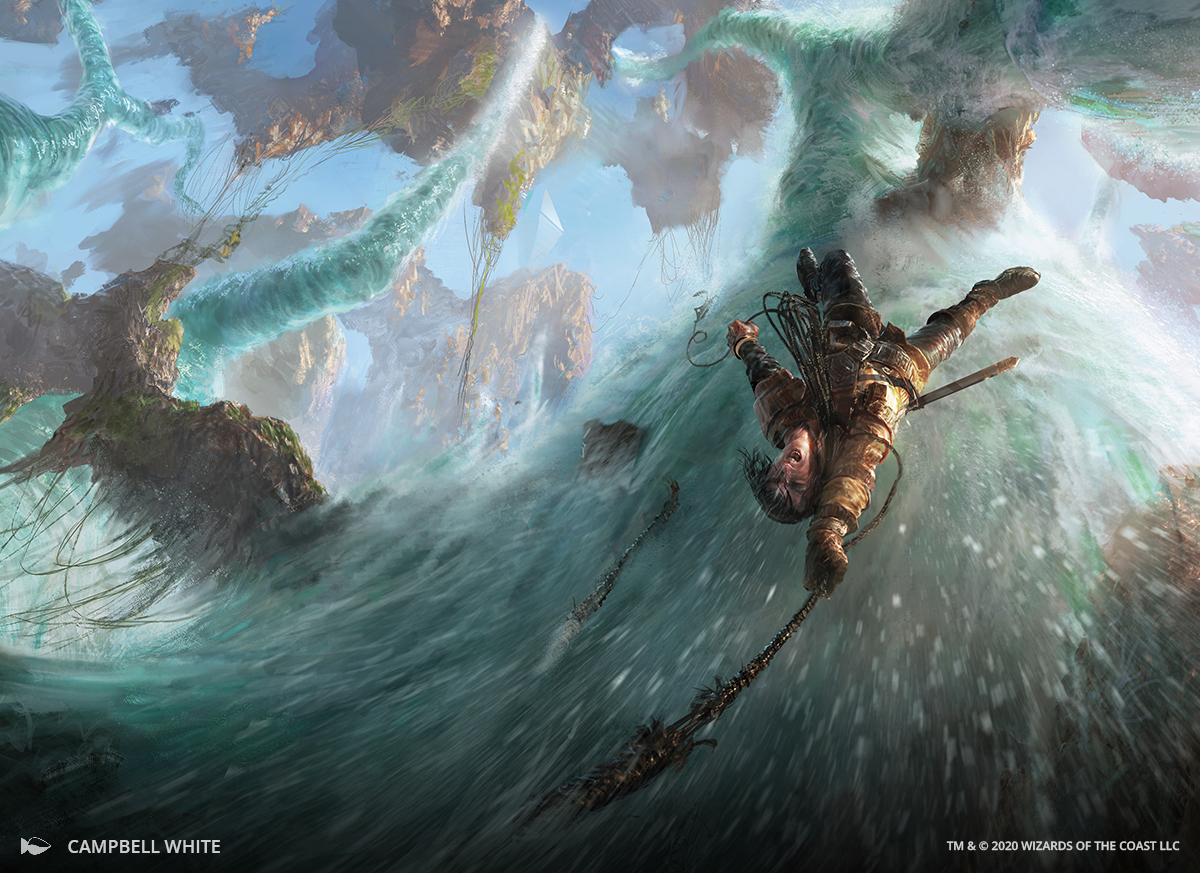

TM and copyright Wizards of the Coast
From www.artofmtg.com
Ability Checks
Many adventure modules include a range of outcomes for key ability checks by providing a spectrum of DCs for each check, across the common tiers of DC 10 (easy), 15 (medium), 20 (hard), etc.
The degree of success rules presented here extend that depth to all ability checks by giving a spectrum of outcomes according to the degree of success (or failure) against a single DC.
Perhaps you are attempting a Charisma (Persuasion) check to ask for a queen’s help. A critical failure might mean that she throws you in the dungeon for your impudence; a heavy failure that she sends you away; simple failure has no additional consequence so you can try again with the High Vizier; marginal could get her support but with a bribe; simple success results in her support as intended; strong success gets some extra aid from the High Vizier who was listening in; and critical success could inspire the Queen to put on her armor and lead the way!
Perhaps you are listening in a door, or trying to recall some information. Degree of success can determine how much you hear or remember beyond the basic facts. While degree of failure can determine how badly you misinterpret things.
The descriptions in the table below aim to be fluid enough to adapt to any ability check and fit within your story, while giving a consistent framework to guide the outcome.
Marginal can often be the most interesting result and the outcome here is similar to the "Success at a Cost" option (Dungeon Master’s Guide†, Wizards of the Coast). The ability check succeeded …but only just, so there is only a partial success or some negative consequence.
| Result | Description |
|---|---|
| Critical Failure (10-) | Now in a worse situation than started (if using a tool, damaged; if social interaction, opposite effect; etc) |
| Heavy Failure (5-) | A small negative consequence |
| Failure (1-) | No additional consequences |
| Marginal (0) | Partial success (succeeds but only partially or with a small negative consequence) |
| Success (1+) | Core aim achieved, no additional gain |
| Strong Success (5+) | Enhanced effect, or a small additional gain |
| Critical Success (10+) | Maximum effect, or an additional gain as big as the original aim |
Help with Ability Checks
This variant of "Working Together" is based on Optional Rule's Friends with Advantage. If you can reasonably receive help from one or more others, then both you and one helper (your choice) roll. If the helper's bonus would be greater than yours, then they use your bonus. Use the highest result.
TM and copyright Wizards of the Coast
From www.artofmtg.com
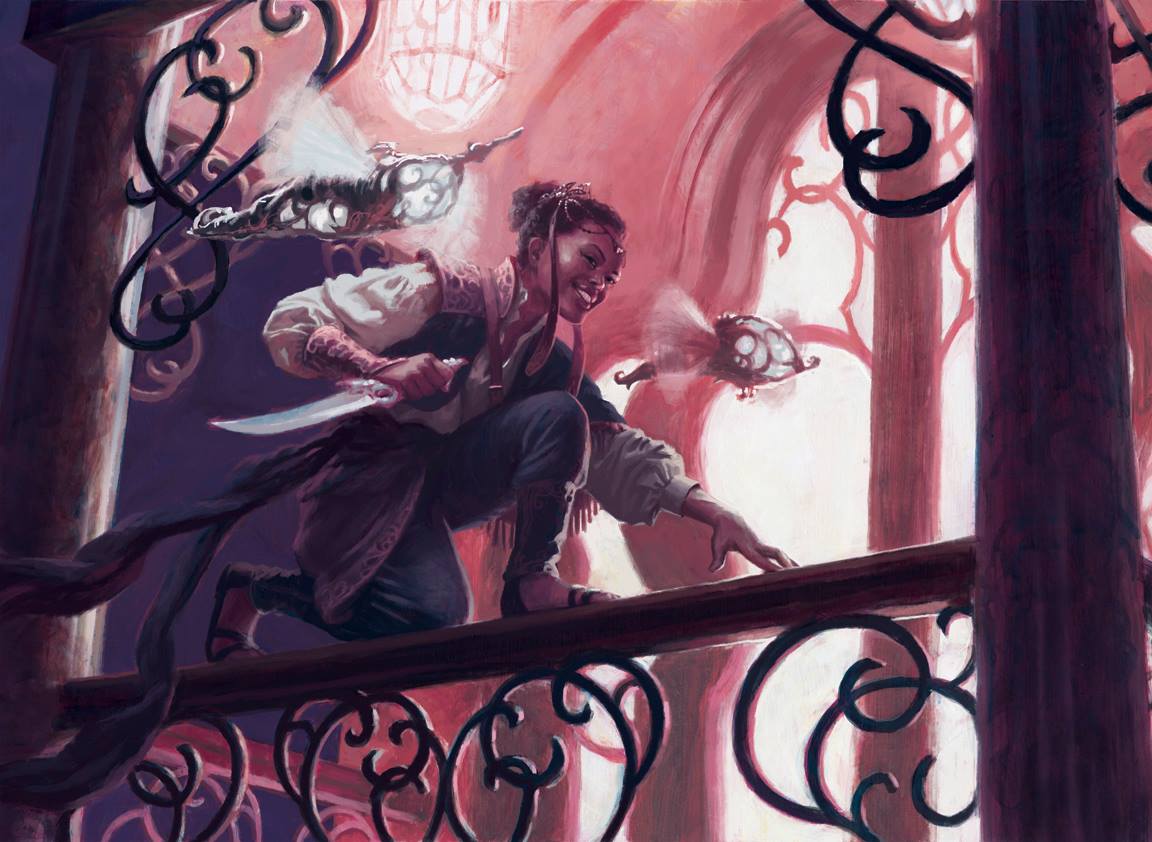
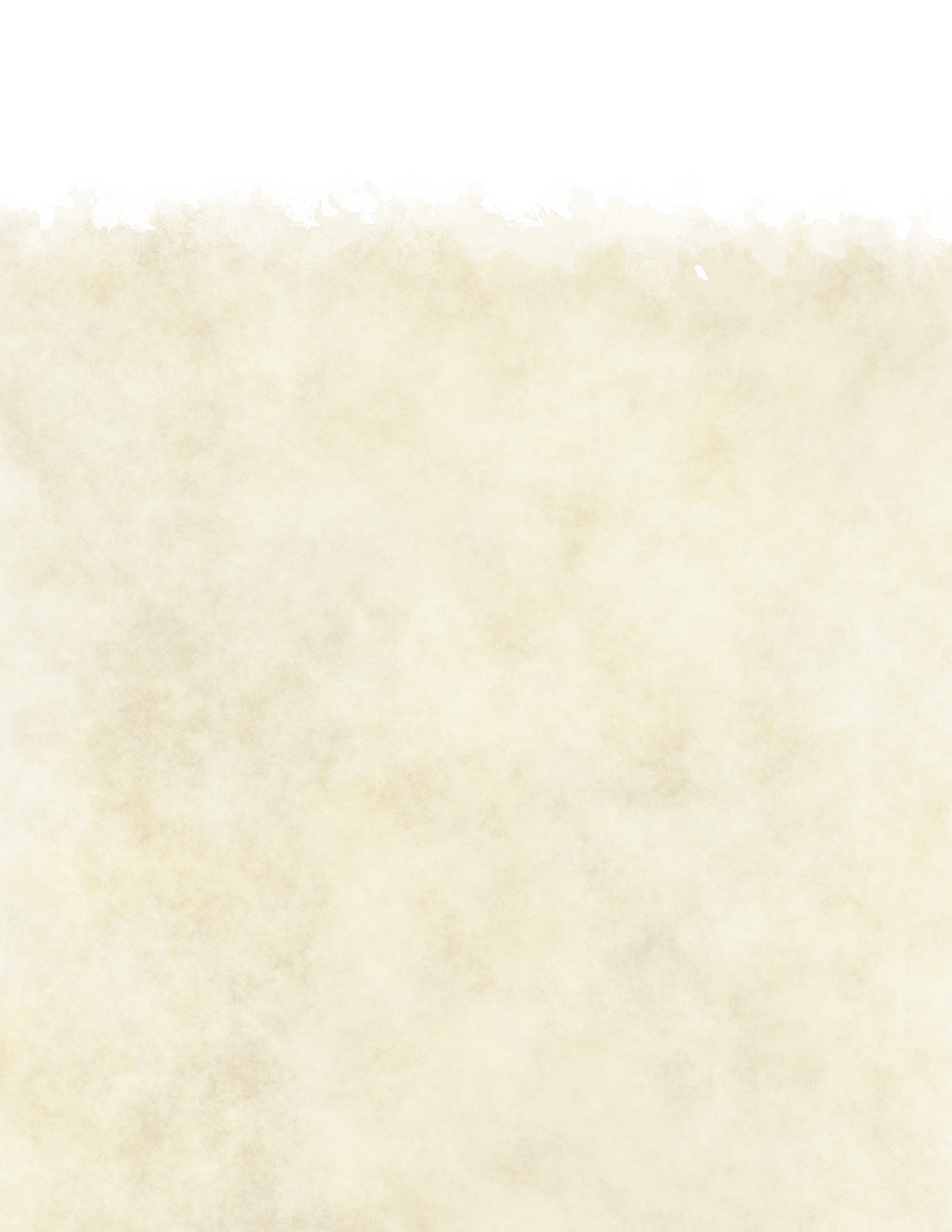

Sequential Checks
Sequential checks are a simple and effective option to determine a multi-stage or multi-skill challenge. The rogue who creeps along the rooftops (Sneak) before leaping down (Acrobatics) to surprise their mark. The wizard hunting through the library of the ancients for the cure to the bard's curse (Arcana and Investigation). However, note that each cumulative check adds difficulty in a similar way to rolling with disadvantage, so consider dropping a difficulty level (5 DC) for each additional ability check to maintain a similar chance of overall success.
If you are using the Degree of Success option, consider only using degree of success for the final ability check, unless each check is a distinct stage with a distinct outcome. However, if you want a cumulative degree of success, a marginal (exact roll) could confer disadvantage on the next roll (so that you may even wish to abandon and restart the attempt), a strong success (5+) could allow a reroll on the next roll, and a critical success (10+) could confer advantage on the next roll (see table below).
| Result | Description |
|---|---|
| Critical Failure (10-) | Now in a worse situation than started, due to this stage |
| Heavy Failure (5-) | A small negative consequence, due to this stage failing |
| Failure (1-) | Fails without additional consequences |
| Marginal (0) | Disadvantage on next stage's roll |
| Success (1+) | Next stage as normal |
| Strong Success (5+) | You may reroll the next check, but must keep the reroll |
| Critical Success (10+) | Advantage on next stage's roll |
Ability Checks in Combat
Using abilities during combat can add another dimension to the action, while also bringing in skills that otherwise get side-lined once initiative is rolled. Identifying the monstrosity (Nature), celestial (Religion) or elemental (Arcana) that has attacked the party; determining (Investigation) the construct's weaknesses; disguising the somatic (Sleight of Hand) or verbal (Deception) component of a spell; scaring (Intimidate) or distracting (Performance) an opponent; persuading
(Persuasion) onlookers to join the fight; tumbling (Acrobatics) or barging (Athletics) past an opponent to retrieve your fallen sword without Leaving Yourself Open (page 14).
To enable this, you may allow these improvised actions to use a bonus action instead of a main action, if the check is then rolled with disadvantage. If the ability check requires an interaction with an object, it still requires the time associated with that interaction (and you can, as usual, interact with one object or feature of the environment for free on your turn).
Saving Throws
Much like ability checks, saving throws really lend themselves to degrees of success or failure, both in narrative and in mechanics.
The two tables here cover both main types of saving throws: saves to entirely avoid an effect, damage, or a condition; and saves to halve damage from an effect.
For compatibility with saving throw outcomes presented in monster stat blocks etc, follow the system of "Specific Beats General" so that any specific outcomes described elsewhere take precedence over the general outcomes described here.
Saving Throw to Avoid Effect
| Roll | Effect | Damage | Conditions |
|---|---|---|---|
| Critical Failure (10-) | Maximum effect | Take maximum damage | Double duration. Disadvantage on first save to end condition |
| Heavy Failure (5-) | Enhanced effect | Roll damage dice with advantage* | Double duration |
| Failure (1-) | Usual effect | Usual damage | Usual effect |
| Marginal (0) | Partial effect | Half damage | Half duration. Advantage on first save to end condition |
| Success (1+) | Negates | Negates | Negates |
| Strong Success (5+) | Negates. Automatic success for rest of day if same effect from same source | Negates. Automatic success for rest of day if same effect from same source | Negates. Automatic success for rest of day if same effect from same source |
| Critical Success (10+) | Negates. Automatic success for rest of day if same source | Negates. Automatic success for rest of day if same source | Negates. Automatic success for rest of day if same source |
Saving Throw to Halve Damage
| Roll | Damage |
|---|---|
| Critical Failure (10-) | Take maximum damage (damage dice count as their highest possible roll) |
| Heavy Failure (5-) | Roll damage dice with advantage* |
| Failure (1-) | Usual damage |
| Marginal (0) | You may use your reaction to take half damage |
| Success (1+) | Half damage |
| Strong Success (5+) | Quarter damage |
| Critical Success (10+) | No damage |
*To roll damage dice with advantage, roll double the number of dice and use the higher roll(s).
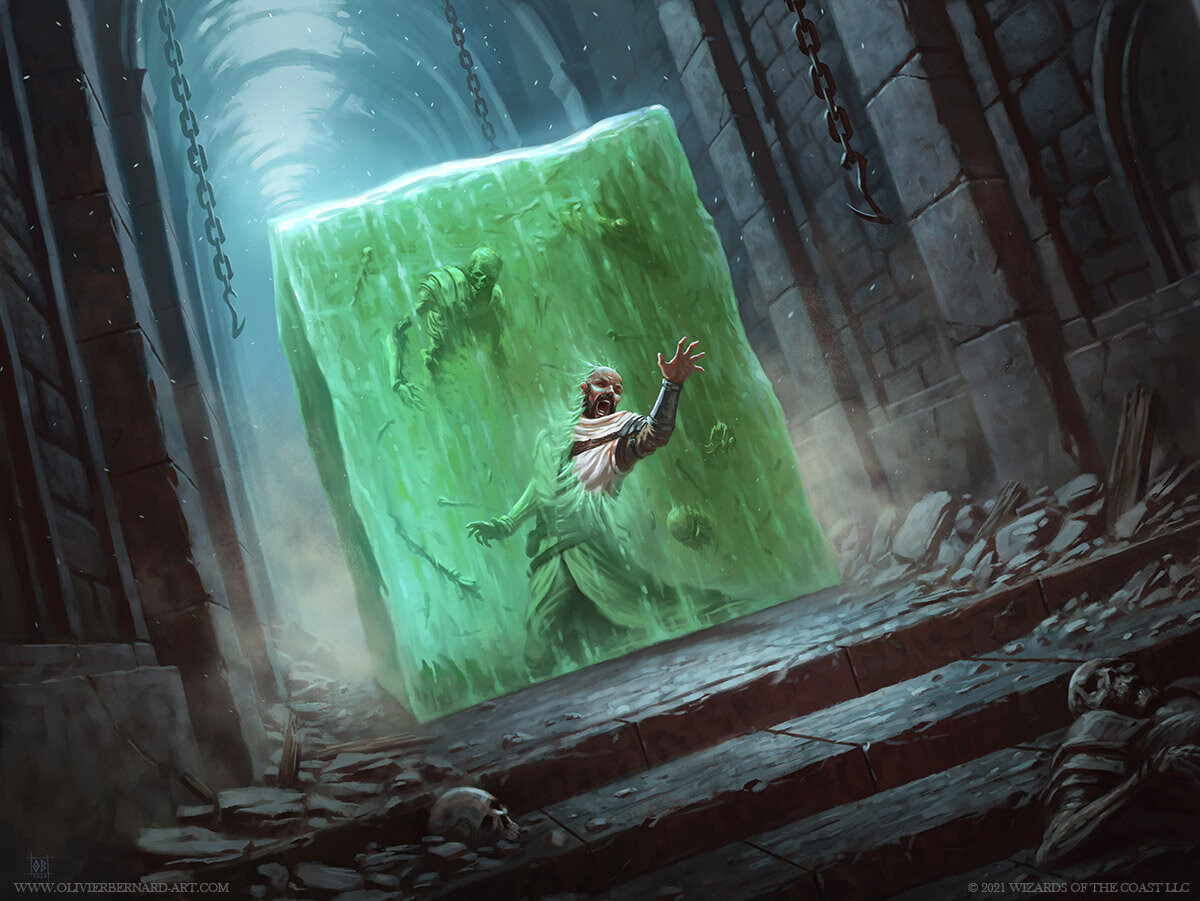

TM and copyright Wizards of the Coast
From www.artofmtg.com
Combat
Combat is perhaps the most visible and iconic of the three pillars of adventuring in fifth edition. The core options here, degree of success and defense rolls, can add depth, telling you a bit more about the quality of an attack or how you evaded it. It lends itself to a more descriptive outcome and can provide handy prompts that flesh out more of the flavor of the fight. As always, options here may be used separately or together. Additional options for specific combat situations and tactics are described in Part 2.
Degree of Success: Combat
Degree of success can also be used for combat and is similarly intuitive in describing the quality of an attack. A better attack bonus increases the chance of hitting and of hitting well, increasing damage by shifting the degree of success towards strong and critical hits. Equally, armor not only reduces the chance of being hit but also the success margin, reducing the damage being dealt by that strike.
On average, degree of success will slightly increase the damage being done per attack (whether melee, ranged, or spell), as additional strong and critical hits will usually more than balance the glancing blows. The same will be seen with heavy and critical failures from saving throws, so the effect is largely similar across different sources of damage.
| Roll | Outcome |
|---|---|
| Natural 1 (or Critical Failure, 10-) | Critical Fumble - dramatically / comically bad attempt that provokes an opportunity attack in melee, or misfire if ranged |
| Heavy Failure (5-) | Bad Miss - poor attack |
| Failure (1-) | Near Miss - dodged / deflected by armor |
| Marginal (0) | Glancing Blow - half damage |
| Success (1+) | Hit - usual damage |
| Strong Success (5+) | Strong Hit - a clean strike, roll damage dice with advantage (roll double the dice and use the higher rolls) |
| Critical Success (10+) | Critical Hit - maximum damage (damage dice count as their highest possible roll) |
Using Average Damage
If you're using average damage for monsters, just add 50% when rolling damage with advantage, or double on a critical hit. In playtesting, this made average damage very popular: saving the GM time but still having appropriate variability.
Extended Glancing Blow Variant
If you want to emphasize the visible role of armor as damage reduction, you can extend the glancing blow range: none if unarmored; only on a marginal roll for light armor; marginal +1 for medium armor; and marginal +2 for heavy armor.
However, this slows play and the effect of armor already becomes very distinct if you use the Defense option (page 7).
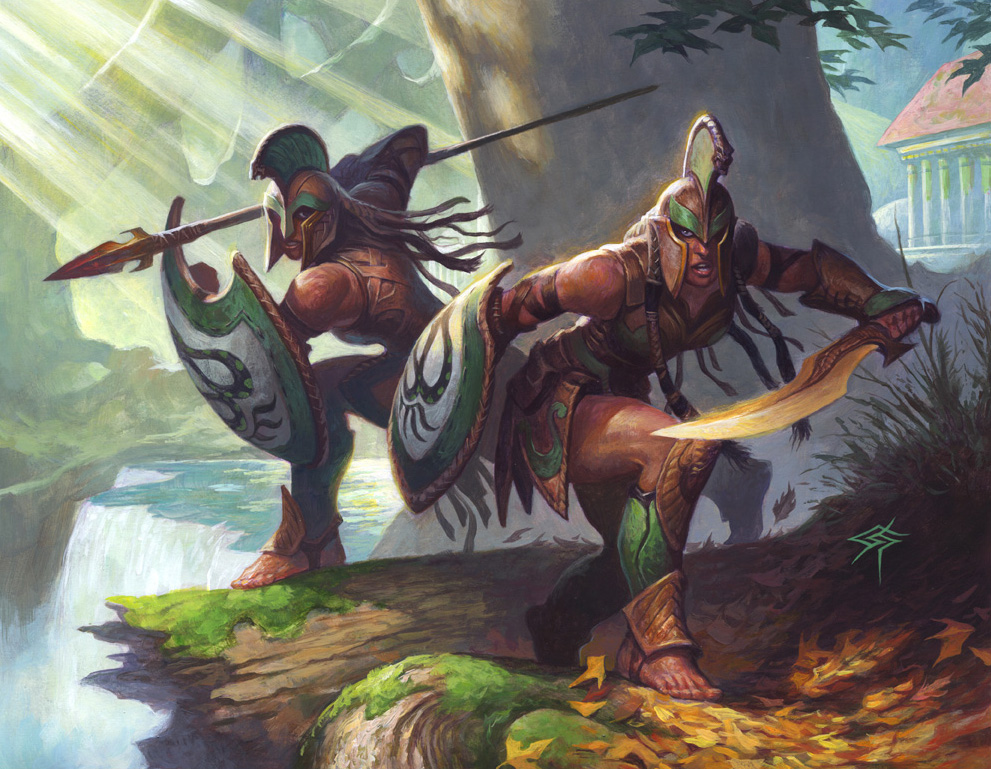

TM and copyright Wizards of the Coast
From www.artofmtg.com
Critical Hits and Fumbles
Critical Hits as Maximum Damage
A variant for critical hit damage. Instead of doubling damage dice, use the maximum of the regular damage dice (so each die counts as its highest possible roll). This has a similar average effect, but never does less damage than a normal hit (or strong hit) and also avoids chance extremes from high rolls on doubled dice. Essentially a critical hit becomes the highest possible damage that a hit might normally achieve.
Effects That Increase Damage Dice
A number of effects add extra damage dice, either on any roll (e.g. Divine Smites, Sneak Attacks, Martial Advantage, etc) or only on a critical hit (e.g. Brutal Criticals, Savage Attacks, etc). With the standard rules, the first group are doubled (or, in this case, counted as maximum) on a critical hit and the second are not. You may wish to keep this.
An alternative that works well with degree of success (where critical hits can be more common), is for this to depend on declaring intent before the attack roll. So if you declare a Sneak Attack or a Smite before your attack roll, it will occur on any hit and be affected by the degree of success outcome (half damage with a glancing blow, maximum damage with a critical hit, etc). If you declare a Sneak Attack after the attack roll, or your Brutal Critical is triggered by a critical, then it is not affected by the degree of success (so you just roll the standard extra dice, not doubled or maxed).
Misses & Critical Fumbles
In playtesting, miss mechanics could slow combat at a time when it's better to keep things moving, so it's best if only a natural 1 is a critical fumble. However, a narrative effect was very popular: the bigger the miss, the worse the attack.
Melee
A critical fumble on a melee attack (or melee spell attack), provokes an opportunity attack from (just) the target. You can avoid the opportunity attack if you have another attack that turn and choose to use it to rescue the fumble instead, preventing the opportunity attack from being triggered.
Ranged
A critical fumble on a ranged attack (or ranged spell attack), results in a misfire. The attack is then rerolled against a random ally within range, including yourself. You can avoid the misfire if you have another attack that turn and choose to use it to rescue the fumble instead, preventing the misfire.
Defense
Defense rolls are an intuitive way to represent defensive skill, allowing a player to roll to oppose an attack being made against them. This builds on the system used for opposed ability checks, as a true contest of skill that scales with combat ability, while also providing more martial options on- and off- turn.
Their use is linked to your bonus action, which maintains balance, "action economy" and realtime impact, while providing a helpful new use of your bonus action if you didn't have one, and a strategic choice if you did. A limited number of defense rolls reflects the limitations of defending against multiple attacks and leads to further strategic choices about which attacks to focus on.
Another advantage of bringing defensive ability into the attack, is that it doesn't then need to be reflected in hit points, which can then become more specifically health and toughness ("Damage and Healing", page 8).
Finally, the defense roll allows a visible difference between armor and defense, aiding cinematic description but also allowing players to develop their style.
Note that defense rolls are intended for player characters and nonplayer characters who have levels, as opposed to monsters who don't. Which works well - a gelatinous cube really is more about absorbing hp than parrying blows with its pseudopodia.
This option has been enormously popular in playtesting and has become the new core defense variant for this Tome.
Bonus Action: Defend
When you take the Defend bonus action, you gain a defense roll that you may use until the start of you next turn to oppose one melee attack made against you, or against an ally within 5’. If you have the Extra Attack feature, you gain an additional defense roll for each extra attack it gives you.
During the first round of each combat, before the start of your turn, you may gain your defense dice as a reaction.
Defense Rolls
When a creature attacks you, you may choose to use one of your defense rolls but must do so before you see the attack roll. You must be wielding a martial melee weapon, a shield, or have the Martial Arts feature, to make defense rolls.
A defense roll is essentially a contested attack roll. You roll a d20 and add your attack bonus and any other modifiers, as if you were making an attack roll yourself. If your defense roll exceeds your opponent’s attack roll, then their attack fails. Otherwise, their attack overcomes your defense and their roll is then compared against your AC in the usual way (this AC comparison is also used for their degree of success).
- If you roll a natural 20, or if your defense roll exceeds the attack roll by 10 or more, you have advantage on your next attack or defense roll against that creature before the end of your next turn.
- If the attacker rolls a natural 1, you may use your reaction to make an opportunity attack against that creature, using your defense roll for the attack.
Gaining Additional Defense Rolls
You may forgo any number of melee attacks from your Attack action to gain an additional defense roll for each.
Reactive Fighting Style
You may use your reaction to make a defense roll.
Arrowcutter Fighting Style
You may also use your defense rolls when attacked with a ranged attack (including ranged spell attacks).
Bonus Action: Fend
When you take the Fend bonus action, your actions (such as ranged attacks and casting, see Leaving Yourself Open page 14) don’t provoke opportunity attacks for the rest of the turn.
Bonus Action Versatility
The various bonus action options in this Tome aim to ensure that there is always a choice to be made with your bonus action, to help define your current combat priorities: raging, defending, additional weapon attack / unarmed strike, second breath, cunning action, ability checks, spending ki, reacting, marking, casting, fending, healing, inspiring, wildshaping, commanding companion or summoned entity, etc.
Additional Versatility Options:
- During your turn, you may exchange your action for a bonus action (but not visa versa).
- During your turn, you may exchange your bonus action to gain an extra reaction until the start of your next turn (but not visa versa). You can still only use one reaction during a single turn.
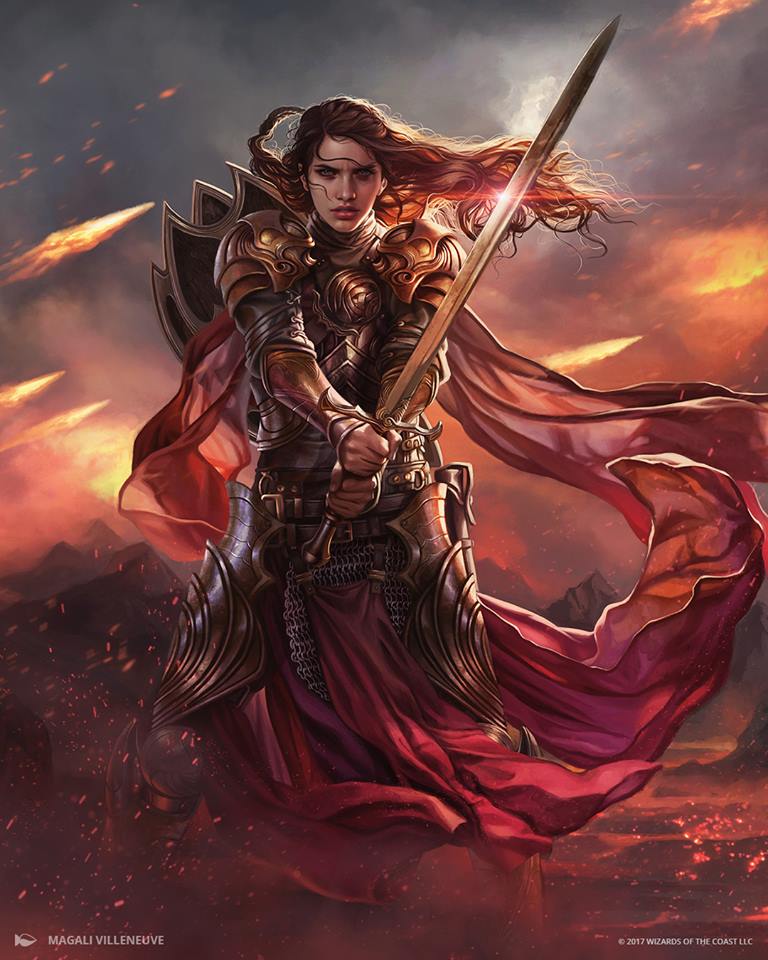


TM and copyright Wizards of the Coast
From www.artofmtg.com
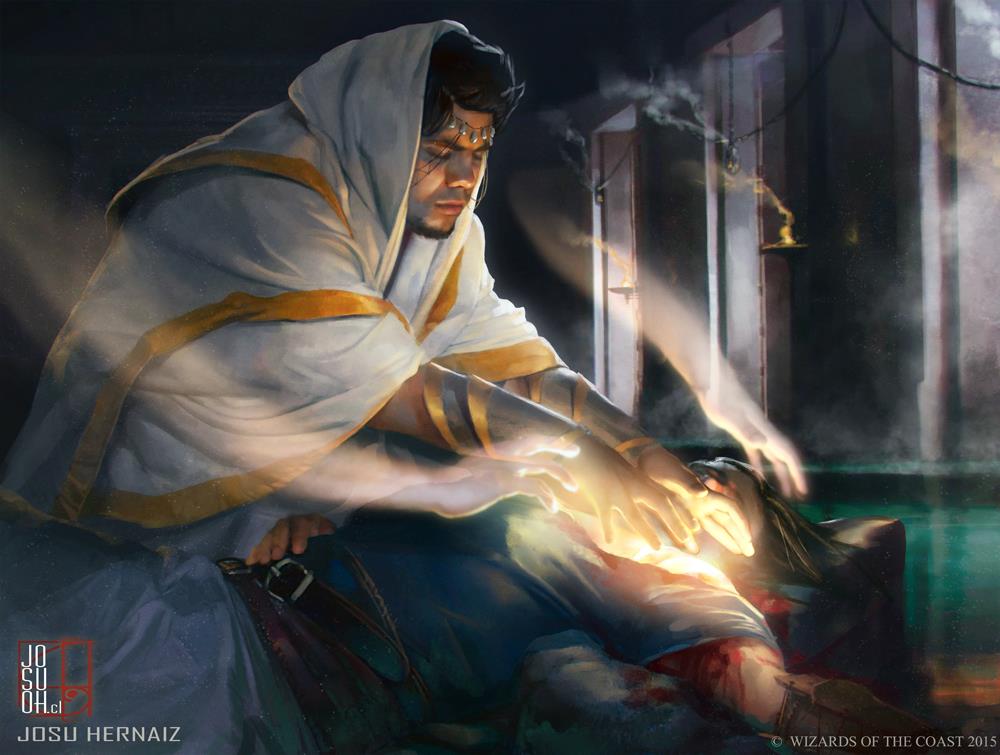


TM and copyright Wizards of the Coast
From www.artofmtg.com
Damage and Healing
The variant options throughout this tome can support a stricter interpretation of hit points (hp) as a precious and exhaustible resource of health and resilience. This can create a more tangible sense of peril and also allows meaningful trade-offs between short term gains from overexertion and longer term implications from depleting a resource that recovers slowly.
Hit Points
Direct scaling of hp with level results in a steep rise from a very low start at level 1. Although a sense of peril is important, a single unlucky injury can be fatal at this level. For variant rules where hp is more specifically health and toughness, this rapid scaling is harder to explain, as is rapid recovery after injury. In the options here, hp start higher so that the increase with level is less exponential (roughly doubling only with each tier of play). This change in scaling, along with grittier healing and the increased damage from Degree of Success, can rebalance peril through the tiers of play. It also balances the effects of defense options where you may take less hits or damage at higher levels.
These optional changes apply only to PCs (and NPCs that have levels). There is no need to make changes to monster hp. At low levels the PCs will have higher base hp than their opponents but the opponents will be coming into the fight uninjured - unlike the PCs.
Constitution In Starting HP
To give characters more baseline fortitude, calculate level 1 hp by taking the maximum of the class Hit Die as usual, but then add your Constitution score (the ability score itself) rather than the Constitution modifier. Essentially this is your Constitution contributing your baseline health and your class contributing the benefits of training.
Gritty Progression
The better progression option for a more tangible sense of peril and especially suited to games using defense options. You gain a Hit Die (and add the usual Constitution modifier) only every odd level (so level 3, 5, 7, etc). To convert hp for a character created with the standard rules, simply half and then add your Constitution score. This can also be applied to NPCs that have levels (same conversion) but monster hp is best left unadjusted.
Heroic Progression
An alternative option for a game with more epic characters that can shrug off more injuries, especially at higher levels. You gain a Hit Die (and add the usual Constitution modifier) every level. To convert hp for a character created with the standard rules, simply add your Constitution score.
Implications for Other Uses of HP
HP totals are used for all-or-nothing effects such as Sleep or the Power Word spells. You may wish to adapt these by adding the caster's spellcasting ability score to the hp total.
Rest and Recovery
Slower hp recovery better reflects physical injury and a Natural Recovery variant of hp recovery is described below.
Natural Recovery
Short Rest
Although very little actual healing happens in just 1 hour, important stabilization is possible: stopping blood loss, replacing fluids, cleaning / covering / stitching wounds, strapping joints, splinting bones, etc. A single Hit Die (plus Constitution modifier) may be spent when you finish a short rest if there has been hp loss since the last short rest.
A successful Medicine check (DC 15) allows the maximum value of the Hit Die to be used.
You can only have up to 3 short rests per day (2 for a grittier option).
Long Rest
More healing can occur with a long rest but a number of days may be required to heal fully.
You may only benefit from a long rest if you've had some food and drink, and have somewhere to rest that is sheltered from the elements, with something like a bedroll to rest on.
When you finish a long rest, you may spend Hit Dice up to half your maximum Hit Dice (rounded up) and your Constitution modifier is added to each. Similarly, you regain Hit Dice up to half your maximum Hit Dice. Hit Dice may be spent or regained in any order. Note that the number of Hit Dice will differ if you are using Gritty or Heroic Progression.
A successful Medicine check (DC 15) allows the maximum value of the Hit Dice to be used and an injury to be healed.
A level of exhaustion is also recovered. If other effects or abilities restore exhaustion, then all effects together can only restore one further level between long rests.
If you've gained a level during a day, the benefits of your new level begin after you next finish a long rest.
You can only have 1 long rest per day.
Negative Hit Points
With this variant, damage can take you below 0 hp and this determines your death saving throw DC. This is a dangerous situation to be in and takes its toll. If you do recover, you initially only recover to 0 hp, where you remain unconscious but stable.
Dropping Below 0 HP
When you drop below 0 hp, you take a level of exhaustion.
While You Have Less Than 0 HP:
- During your turn, you are unconscious and can't take any actions but you can spend a Hit Die (or take a level of exhaustion to spend a Hit Die if no Hit Dice left) to heal that roll (plus Constitution modifier).
- Another creature can attempt to stabilize you by performing a Medicine check (DC 10 or half your hp below 0, whichever is higher), to bring your hp back to 0.
- You don't heal past 0 hp in a single turn. Healing that would take you above 0 hp, instead heals you to 0 hp.
- At the end of your turn, you must succeed on a death saving throw (Constitution saving throw with a DC of 10 or half your hp below 0, whichever is higher) or take another level of exhaustion. If using Degree of Success, see optional table below. Reaching level 6 exhaustion results in death.
At 0 HP (Unconscious but Stable):
- You recover consciousness when you heal to 1 hp or more.
- After you finish a short or long rest, you naturally recover consciousness and 1 hp (plus any hp from spending a Hit Die).
TM and copyright Wizards of the Coast
From www.artofmtg.com
Death Saving Throw - Degree of Success
| Roll | Effect |
|---|---|
| Critical Failure (10-) | Take 1 level of exhaustion. Then make an additional death saving throw this turn |
| Heavy Failure (5-) | Take 1 level of exhaustion. Death saving throw next turn is with disadvantage |
| Failure (1-) | Take 1 level of exhaustion |
| Marginal (0) | Death saving throw next turn is with disadvantage |
| Success (1+) | No effects |
| Strong Success (5+) | Death saving throw next turn is with advantage |
| Critical Success (10+) | Stabilized (hp recover to 0) |
Gritty Injury Variants
For a more gritty campaign, you may chose a grittier variant with additional effects from dropping below 0 hp:
- Hit point maximum permanently reduced by 1
- Injury: acquire a debilitating injury ("Recuperating" SRD 5.1†, or "Lingering Injuries" Dungeon Master's Guide†, both Wizards of the Coast)
- Any healing is reduced by half when at 0 or negative hp
- and/or Stunned for a round when recover consciousness.
Knocking a Creature Out
You can avoid taking a creature below 0 hp in melee by intentionally pulling your blow. You must decide to do this before you roll damage. This halves the damage but if that takes them below 0 hp, reduce their hp to 0 instead.


Overexertion
The following overexertion options allow alternative uses of Hit Dice or exhaustion in desperate circumstances.
Heroic Effort
You may spend one Hit Die (or take a level of exhaustion if no Hit Dice left) to:
- Add to any roll: ability checks (including initiative), saves (including death saving throws), casting rolls (page 11), attack rolls, damage rolls, etc
- Add to the save DC for a spell you're casting.
- Add to your AC until the start of your next turn.
- Gain temporary hit points for a duration of 1 minute.
- Recover other temporary points up to your proficiency bonus (sorcery points, ki points, etc).
- Recover a temporary spell slot up to your proficiency bonus (or spell points if using the variant from the Dungeon Master's Guide) for a duration of 1 minute.
- Or in place of spending a special die (e.g. superiority die, Bardic Inspiration die, Psionic Energy die, defense die).
You must then finish a short or long rest before you can do this again. For a grittier version, if you recover your Heroic Effort with a short rest then you can't spend any Hit Dice during that rest.
Heroic Exertion
You may spend a level of exhaustion to reroll any roll you make, any attack against you, or any damage rolls from a single attack (by you or against you). You must then finish a short or long rest before you can do this again.
Heroic Reaction
You may spend a level of exhaustion to take an additional reaction this round (although you can't take more than one reaction during the same turn). You must then finish a short or long rest before you can do this again.
Variant Exhaustion
Ordinarily, the six levels of exhaustion each introduce a distinct effect (disadvantage on ability checks; speed halved; disadvantage on attack rolls and saving throws; hit point maximum halved; speed reduced to 0; death).
In this variant to exhaustion (derived from a post by Horwath), those effects instead all gradually accumulate over the six levels. So you gain a cumulative -1 penalty on all ability checks, attack rolls, saving throws and casting rolls (page 11); a cumulative -1 to AC and to your spellcasting DC; a cumulative -1 to your damage rolls; and a cumulative -5 to speed (to a minimum of 5 ft). Essentially a -1 penalty to all rolls, plus the reduction in speed, per level of exhaustion. 6th level remains death.
With the overexertion options above, you may well accumulate exhaustion during combat. The gradual accumulation of effects with variant exhaustion limits the immediate impact of these. For a heroic setting, you may wish to limit this further by having new exhaustion levels only
come into effect at the end of combat, as the players push through with a heroic last stand. This can even be extended to death (i.e. irreversibly dying, rather than dead), allowing you to roleplay a fitting end outside the heat of battle.
Exhaustion Effects
| Level | Cumulative Effect |
|---|---|
| 1 | -1 to ability checks, attack rolls, saving throws, AC, DCs, & damage rolls; speed reduced by 5 ft |
| 2 | -2 to ability checks, attack rolls, saving throws, AC, DCs, & damage rolls; speed reduced by up to 10 ft |
| 3 | -3 to ability checks, attack rolls, saving throws, AC, DCs, & damage rolls; speed reduced by up to 15 ft |
| 4 | -4 to ability checks, attack rolls, saving throws, AC, DCs, & damage rolls; speed reduced by up to 20 ft |
| 5 | -5 to ability checks, attack rolls, saving throws, AC, DCs, & damage rolls; speed reduced by up to 25 ft |
| 6 | Death |
TM and copyright Wizards of the Coast
From www.artofmtg.com
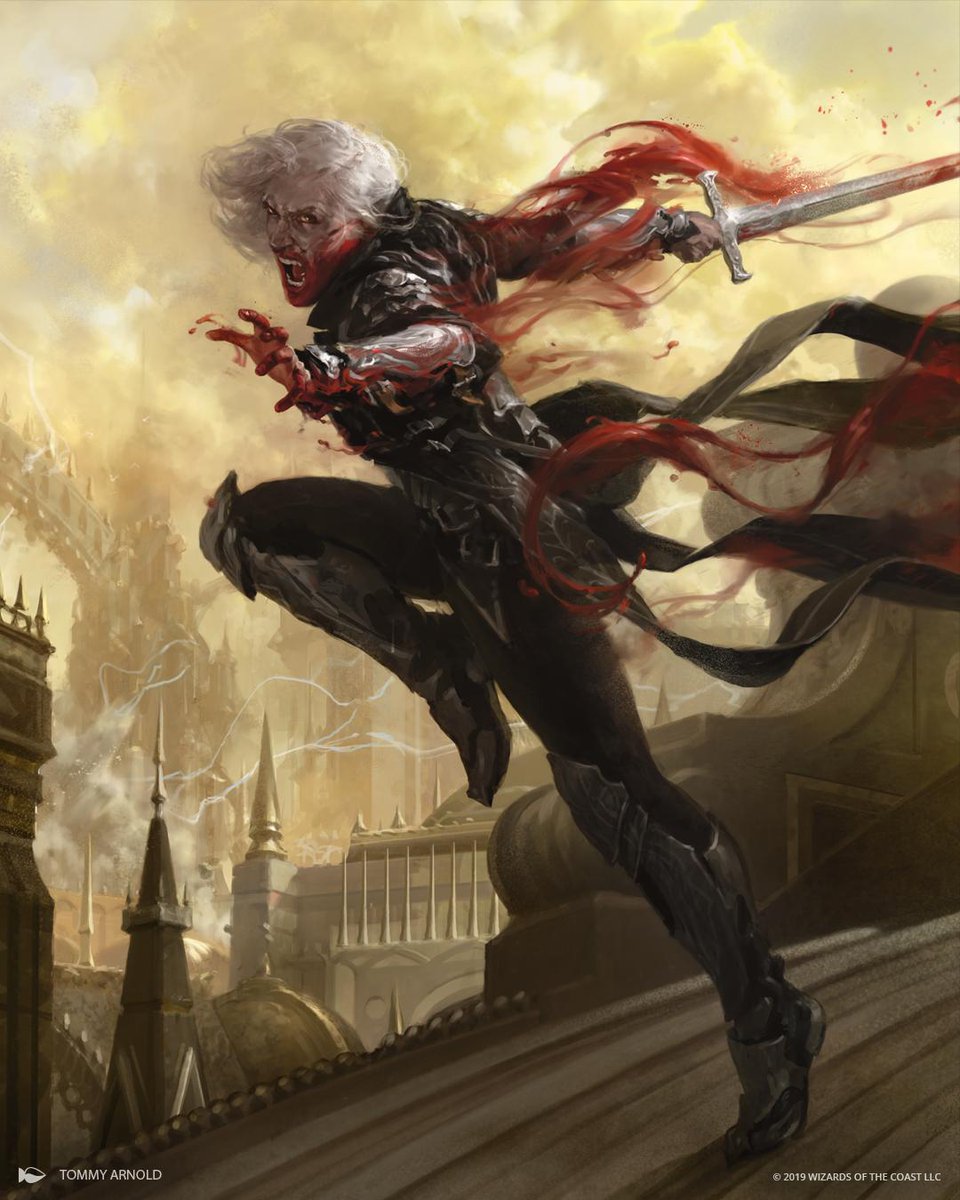

Spellcasting
With this variant, a single casting roll replaces spell attack rolls and spell DCs, and can now be applied to all spells. This is a little simpler and more intuitive for new players, but also has the advantage of linking all magic to the caster's skill and making more of a story of each spell.
Casting Roll
A casting roll is simply a d20 plus your spell attack bonus (which remains your spellcasting ability modifier plus your proficiency bonus).
- Spell attack: roll against target's AC
- Saves: use the roll as the DC for any saves
- Other spells: to successfully cast the spell, roll against a casting DC of 10 plus the spell level it was cast (or upcast) at. Cantrips have a DC of 10.
Additional Options
A few additional options can build on this simple core system.
Spell-like Abilities
Some PCs have spells or spell-like abilities that represent an innate ability and don't use spell slots. These spells or effects are generally limited in choice and in number of uses. These can be considered as being more innately reliable and any d20 roll of less than 10 can be treated as a 10.
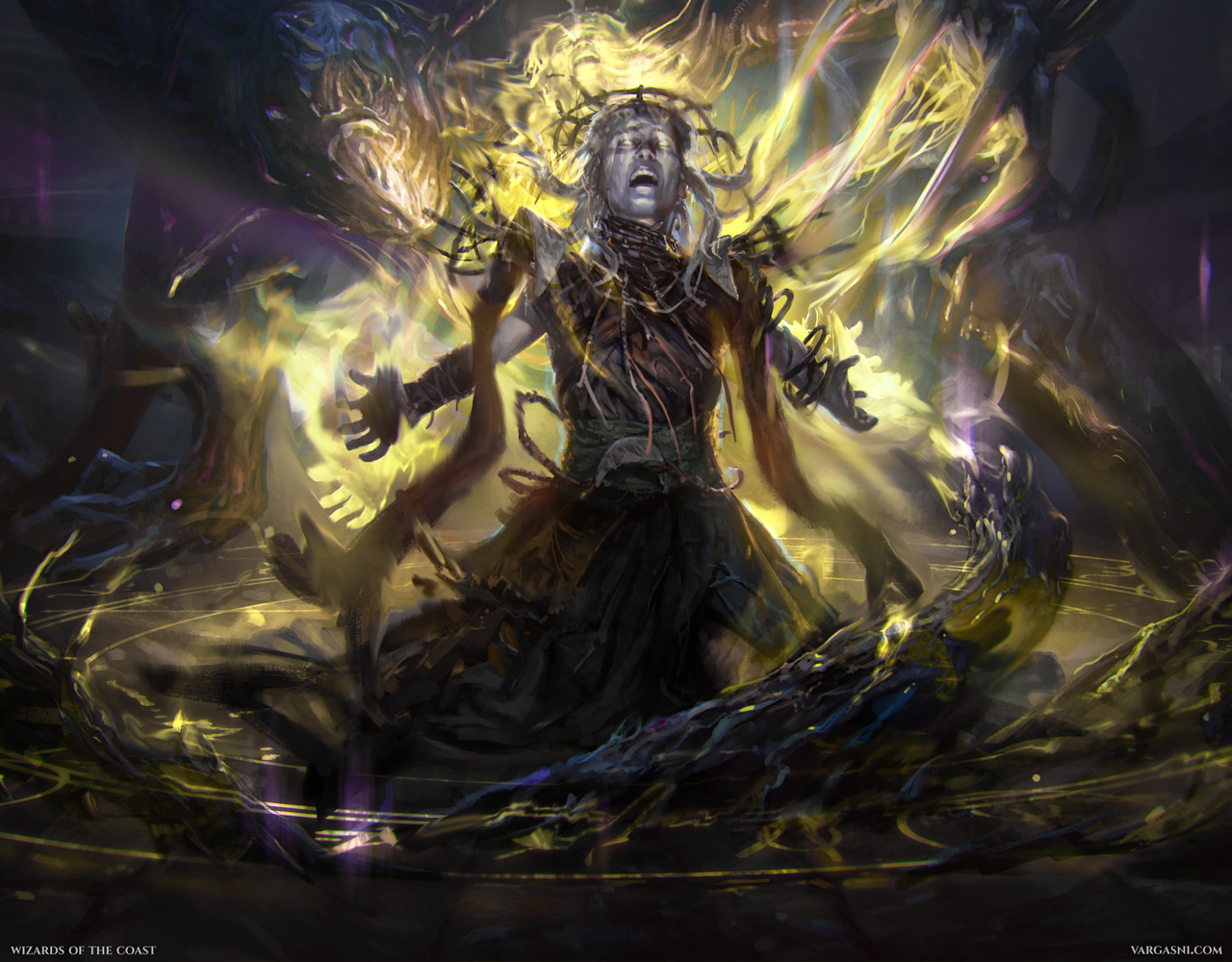


Monsters
Similarly, monsters have reliable innate casting and you can simply use a 10 as their d20 roll, instead of rolling (or simply use the fixed spell save DC in their stat block if relevant).
If you wish to save time on monsters attempting saving rolls, you can instead use a 10 as their average d20 roll and add the usual modifiers. Or, even faster, avoid both roll and modifiers, and just use the actual value of their relevant ability score instead (which is usually very similar).
Saves
The rolled spell save DC is likely to be higher than your fixed spell save DC would have been (since these were effectively 8 + spell attack bonus). That's fine in a heroic magic setting and has other trade-offs in a gritty magic setting (see below).
Heroic Magic Settings
For a heroic magic setting, you don't lose the spell slot if a spell fails due to the casting DC, and spells that have attack rolls or saves don't also need to succeed against the casting DC.
Gritty Magic Settings
For a gritty magic setting, you lose the spell slot if a casting fails and you must succeed against the casting DC for all spells, even those attack rolls or saves. So Fireball, a 3rd level spell with casting DC 13, would fail on a roll of 12, and targets wouldn't take any damage (instead of taking half or full damage depending on their save).
Casting Advantage & Disadvantage
Another spellcaster who is able to cast the same spell may use the Help action to aid you in casting the spell, allowing you to roll the casting roll with advantage (or a helping roll, page 4). Conversely, conditions that cause you to make all ability checks with disadvantage (for example, the frightened or poisoned conditions) also impose disadvantage on casting rolls. If you are casting with disadvantage, it may be safer to stick to lower level spells.
Disrupting a Spell
If another creature can detect that you are in the process of casting a spell (for example, can see the somatic component or hear the verbal component), the act of casting can be used to trigger a reaction before the spell completes (for example, if the creature has Readied an Attack or movement).
If you take damage while casting a spell with a casting time of 1 action or longer, it could disrupt your concentration and cause the spell to fail. You must make the usual Constitution saving throw (DC 10 or half the damage you take, whichever number is higher) to allow the spell to proceed.
Counterspell
Another way to disrupt a spell is with Counterspell. The spell variant below resolves this as a contested casting roll.
TM and copyright Wizards of the Coast
From www.artofmtg.com
TM and copyright Wizards of the Coast
From www.artofmtg.com
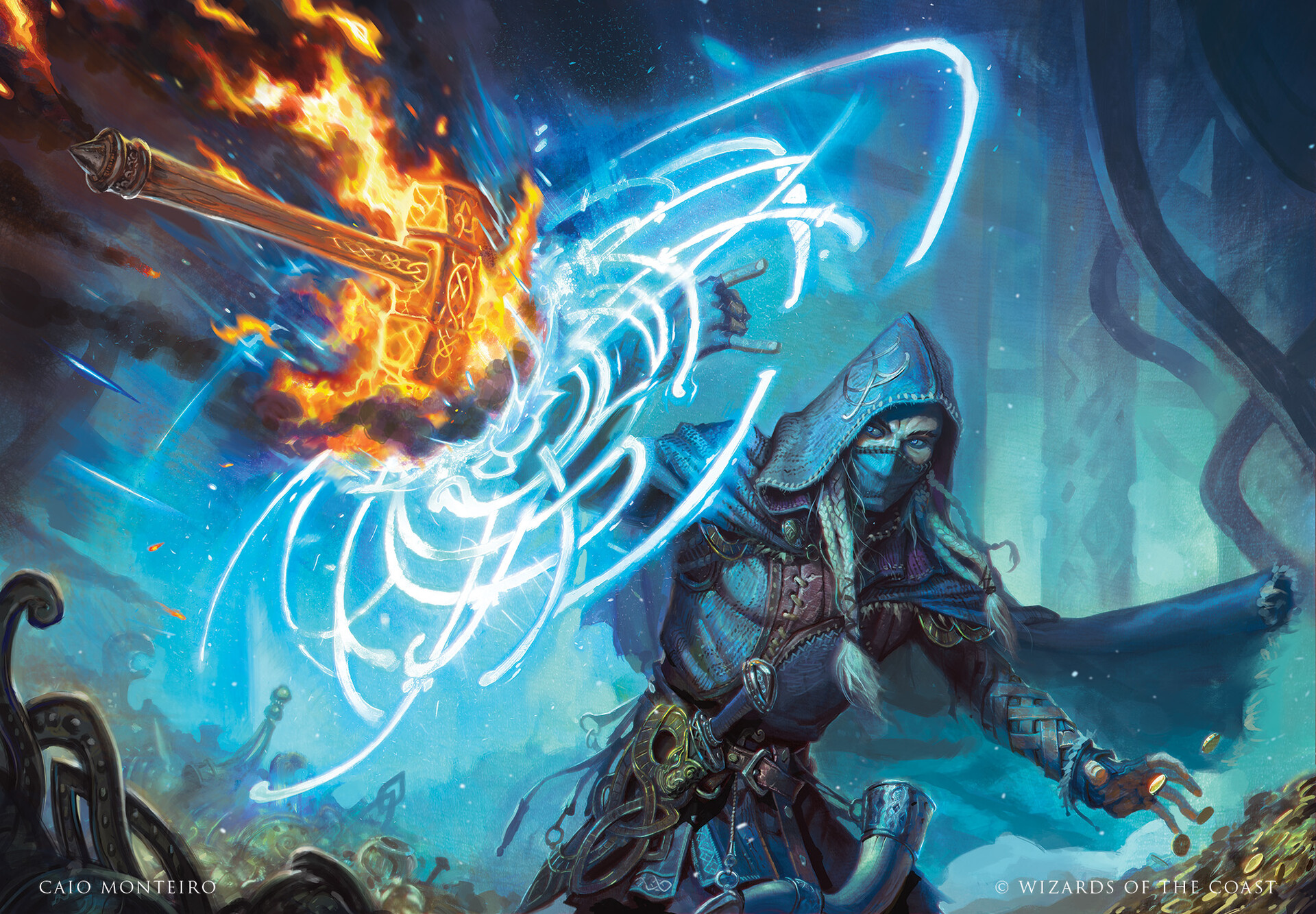

Counterspell
3rd‑level abjuration
- Casting Time: 1 reaction, which you take when you see a creature within 60 feet of you casting a spell
- Range: 60 feet
- Components: S
- Duration: Instantaneous
You attempt to interrupt a creature in the process of casting a spell. You do this by contesting their casting roll with your Counterspell casting roll. If the spell slot you use is higher than the creature's spell, add the difference to your roll. If the slot you use is a lower level than their spell, subtract the difference from your roll.
- If your casting roll is higher than theirs, the creature’s spell fails and has no effect.
- If your casting roll is lower than theirs, your Counterspell fails and their spell proceeds (it may still fail to work if their casting roll was low).
- If your casting roll matches theirs, both spells fizzle, and neither spell slot is expended.
At Higher Levels. When you cast this spell using a spell slot of 4th level or higher, that level is used in the comparisons with the creature's spell.
Degree of Success: Spells
Degree of success can also be applied to casting rolls. The higher the roll, the closer it looks to how it should do and players may enjoy describing how a spell differs from its intent.
There are suggested mechanical effects for criticals, but use the Combat (page 6) or Saving Throws (page 5) tables and outcome tiers instead if it was a spell attack or save.
A grittier version of this table, for campaign settings with rarer magic, is in the Archive (page 43)
Wild Magic Variant
Instead of using the suggested critical failure effect, you may wish to have a random magical effect by casting a random cantrip, with a random target, from your class spell list. Rolling on a "wild magic" table is an alternative option.
| Roll | Effect |
|---|---|
| Critical Failure (10-) | Fails dramatically / comically. You can’t cast that spell again until you finish a short or long rest |
| Heavy Failure (5-) | Starts then fizzles |
| Failure (1-) | Fails |
| Marginal (0) | Very odd appearance but succeeds |
| Success (1+) | Acceptable appearance |
| Strong Success (5+) | Appears exactly as described |
| Critical Success (10+) | Perfect. Double the usual effect |
Concentration
Finally, the degree of success table for casting also fits well with Constitution saving throws when trying to maintain concentration on a spell (either an active spell or, if using the Disrupting a Spell option, one being cast).
Part 2
Additional Options
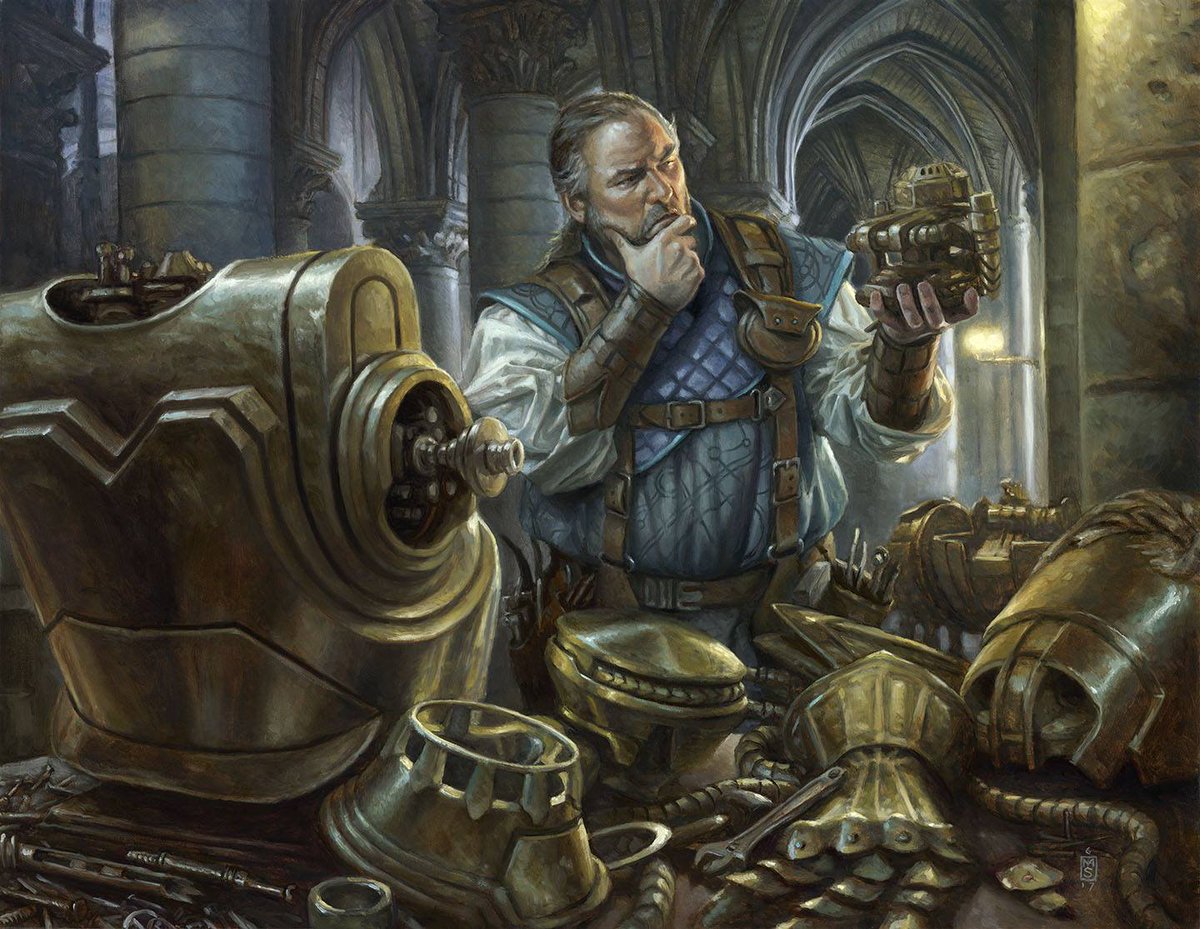

TM and copyright Wizards of the Coast
From www.artofmtg.com
Tactical Combat
As with the core options in Part 1, the additional options here in Part 2 may be used individually or together. These additional options have a narrower focus, with less effect on core mechanics, so are easily swapped in or out. This first section focuses on combat and tactics, with options that can add a layer of situational depth to combat.
Variant Initiative
With this variant, initiative is determined by a single lead creature on each side. The DM chooses which player (and which opponent) would have to react. This will usually be the ones who are closest or who are already interacting (e.g. the lead player as the party enter the throne room, or the player who had been negotiating with the bandits when things got nasty). If there are several equally involved players, then let the players choose amongst themselves.
Group Check
If others would be able to help, e.g. other creatures keeping a lookout, you can use the Help with Ability Checks option (page 4)
Monster Initiative
Monsters' initiative can simply be 10 + their Dexterity bonus.
Player Order
Players choose the order they'll go in (and decide any tactics, with no further discussion between different players' turns), although the player who rolled initiative must go first that round. The DM chooses the order monsters go in when it's their side's turn.
Alternating Initiative
The simplest system is to have each side take all of its turns before the other side takes theirs. However, combat can be
more balanced, and more exciting, if individual players and monsters alternate turns, as suggested by Cody Lewis.
You may even want to split out multiple attacks/actions from a single powerful creature when fighting multiple opponents, but this becomes rapidly complex if applies to more than one creature.
Surprise Variant
A simple variant for determining surprise is for it to occur when your opponents beat your initiative roll by 10 or more. You add +5 to your roll if you're hidden from your opponents.
Pre-empting an Attack
When you roll initiative, so long as you're not surprised, you may use your reaction to say or do something quick that might interrupt the start of combat (e.g. shouting "Stop, we're on your side!"). You can't then take another reaction during the first round of combat.
Leaving Yourself Open
In a fight, a creature’s actions can create an opening for an opportunity attack. With this variant, some additional situations provoke attacks from opponents in melee range.
Movement:
- Moving out of your opponent’s range
- Standing from prone
- Picking up an item from the ground (e.g. recovering a weapon after being disarmed)
Actions:
- Making a ranged attack
- Casting a spell with a casting time of more than 1 action, or a casting time of 1 action if the range is more than 15 ft
- Any action that actively ignores your opponent
You don’t provoke an opportunity attack when you teleport or when someone or something moves you without using your movement, action, or reaction.
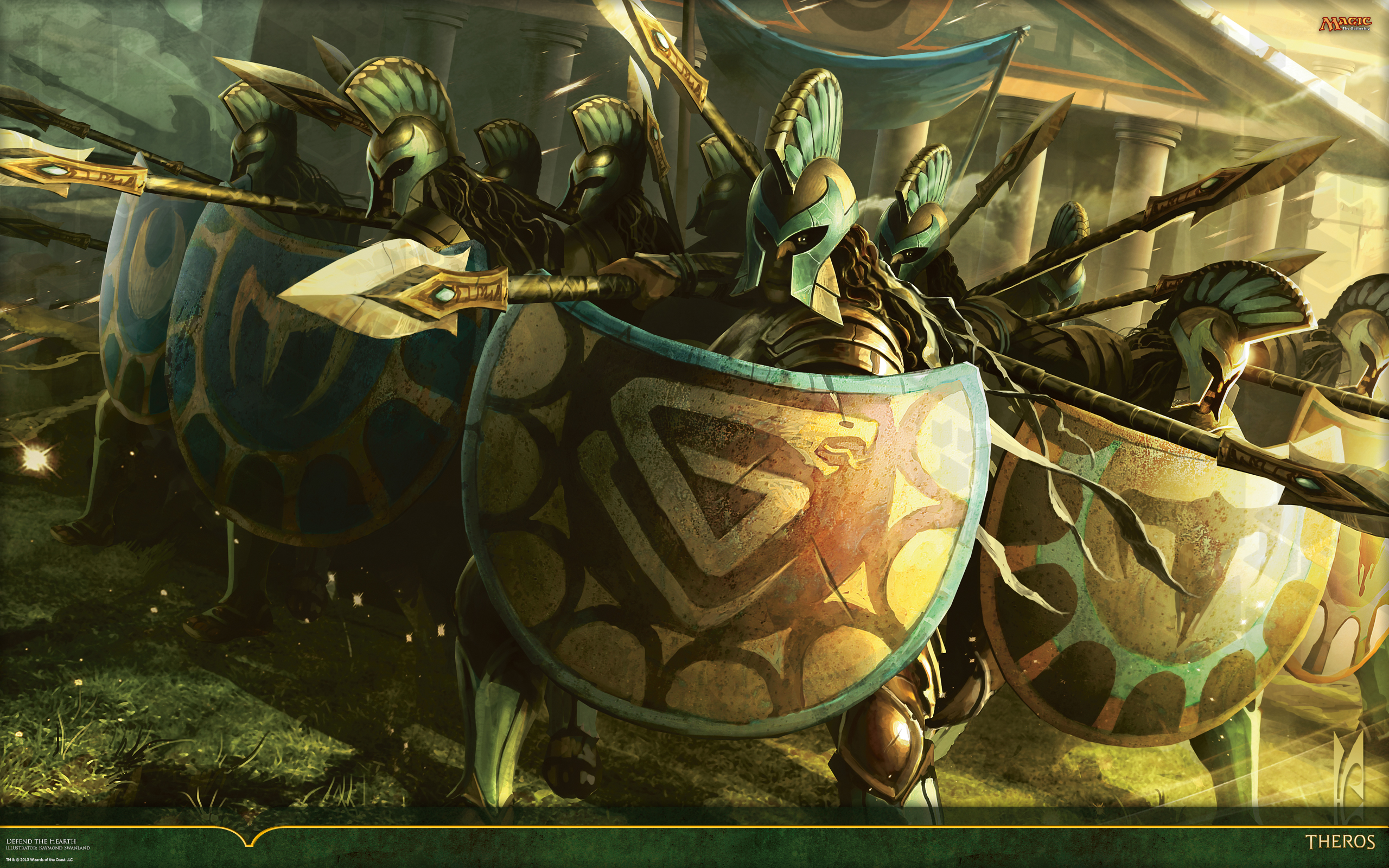

TM and copyright Wizards of the Coast
From www.artofmtg.com
TM and copyright Wizards of the Coast
From www.artofmtg.com
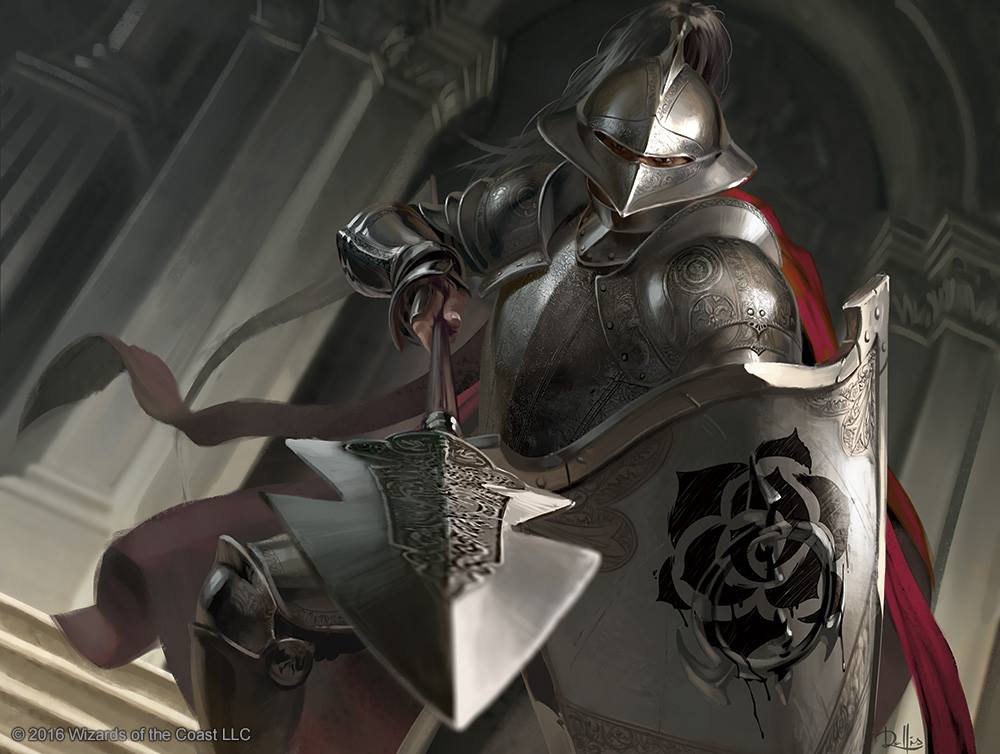

You can avoid provoking an opportunity attack by taking the Disengage or Fend actions (see below). The opportunity attack provoked by casting a spell triggers after the spell is complete, unless it has a casting time of more than 1 round, or the creature Readied an attack for the act of casting itself.
Disengage
This option expands on the Disengage action. Your movement doesn’t provoke opportunity attacks for the rest of the turn, and neither do your actions. In addition:
- If you take the Disengage action and have the Extra Attack feature, you may use your bonus action to make an attack.
Fend
Fend is a more limited Disengage that uses a bonus action. When you take the Fend bonus action, your actions don’t provoke opportunity attacks for the rest of the turn (but your movements may).
Melee Reach and Space
Closing Range
This optional rule applies when you move within reach of an opponent whose melee weapon has a longer reach. Similar to the "Polearm Master" feat (Player's Handbook†, Wizards of the Coast), this provokes an opportunity attack. To determine reach, weapons with the reach property have the longest reach, followed by those that are two-handed (or versatile), followed by all other weapons, except those with the light property (or unarmed attacks) which have the shortest reach.
There are number of circumstances where closing range doesn’t provoke an opportunity attack (unless of course the defender has a polearm and the "Polearm Master"† feat):
- If the opponent is surprised
- If the attacker is hidden from the opponent
- If the opponent is already engaged in combat with another attacker
- If the attacker is wielding a shield
- Or if the attacker teleports (or equivalent) directly within reach
Note that if the attacker does close, the opponent may retreat on their turn to re-establish their range. However, unless they take the Disengage action, that retreat may itself provoke an opportunity attack.
When an attacker successfully closes range, opponents with longer reach weapons may also find their weapons less effective if then affected by Restricted Space or if held in Grappling Range (see following).
Restricted Space
In a restricted space where 5 ft range can’t be maintained (such as a tight dungeon corridor, thick forest, or the crush of a large melee), attackers with more than 5 ft reach (for example, wielding weapons with the reach property) have disadvantage on attack rolls, unless used in a close reach mode (such as the butt of the weapon: an improvised weapon dealing 1d4 damage).
This is when the attacker with the short reach weapon can turn the tables on their longer reach opponent: intentionally pinning their target into a corner, or against another attacker, to level the playing field. A greatsword isn’t as effective when you can only punch out with the butt of it.
Grappling Range
In extreme restricted space (or during a grapple), weapons with more than 5 ft reach can’t be used at all to attack, unless used in a close reach mode as an improvised weapon. Even in close reach mode, they have disadvantage on attack rolls and it may be wiser to drop the weapon and fight unarmed or with a knife. Even mid-range weapons (any weapon without the light property) have disadvantage on attack rolls unless using the pommel etc (for 1d4 damage). This is when the dagger finds its true calling and creates space for the close combat / grappling specialist. Note the Grappler feat gives advantage on attacks while grappling, which may be particularly relevant for rogues.
If the attacker wants to get within grappling range and stay there, play this as an attempted grapple, using one of the attacker's attacks. If not already within reach, the attacker would need to close range first, provoking an opportunity attack. If the opportunity attack lands, then the grapple check is with disadvantage.
Ranged Attack Into Melee
This is a common situation for ranged weapons and spell attacks but hitting the right target is more difficult and comes with some risk. The following option formalizes the use of cover with a simple guide for how much cover to apply.
Cover
Apply cover when your target is in melee. If your opponents are larger in size or in number than your allies, apply half cover (+2 to target’s AC). Otherwise apply three-quarters cover (+5 to target’s AC).
Friendly Fire
If a you miss with a ranged attack into melee (including a ranged spell attack), reroll (once) as an attack on a second creature in that melee (the nearest opponent of the target, or select any creature at random in the melee). If you're using Degree of Success, the misfire of a critical fumble could also target allies outside of the melee, including yourself.
Called Shot
This is a general flexible option for when an attacker wants to target a specific part of their opponent’s body, or wants to have a specific effect such as a trip, or to lock blades, pin a weapon, disarm, or anything else. The attacker must declare their intention before making the attack roll. Simply apply a -1 to -10 modifier on the attack roll, depending on the difficulty (see Called Shot Difficulty table, where assumed chance is the typical chance for matched opponents).
A called shot can’t be attempted if it takes the die roll needed to hit above 20, nor can limited-use attack bonuses or automatic hits be used for these actions.
The default modifier can be considered -5 (note that this parallels degree of success). Or refer to this difficulty table:
Called Shot Difficulty
| Modifier | Difficulty | Assumed Chance |
|---|---|---|
| -2 | Relatively simple | about a 50% chance |
| -4 | Doable with a good hit | about a 40% chance |
| -6 | Also requires luck | about a 30% chance |
| -8 | Unlikely | about a 20% chance |
| -10 | Possible but improbable | about a 10% chance |
If using stacked advantage, an alternative is that a relatively simple called shot applies one level of disadvantage to the roll, while a complex called shot applies two levels.
Strength and Damage
Although your Strength modifier is commonly used for attack and damage rolls, Dexterity (ranged weapons or weapons with the finesse property) and Charisma (some warlocks) are also used.
With degree of success, an attack modifier also translates into increased damage by increasing the success margin, resulting in more strong and critical hits. Since this captures the impact of ability (Strength, Dexterity, Charisma, etc), the damage roll bonus can more specifically reflect power. This is also relevant for ranged attacks, where draw strength (or throwing strength) would be expected to influence damage (except for spells and firearms).
If you want to reflect this in the damage bonus, then use half the non-Strength ability modifier (round up), and add half you Strength modifier (also round up). This means Strength always contributes, while keeping all options viable.
If you do use this option, it rebalances Dexterity well and provides space to broaden options for fighters by allowing them to treat any weapon without the heavy property as having the finesse property.
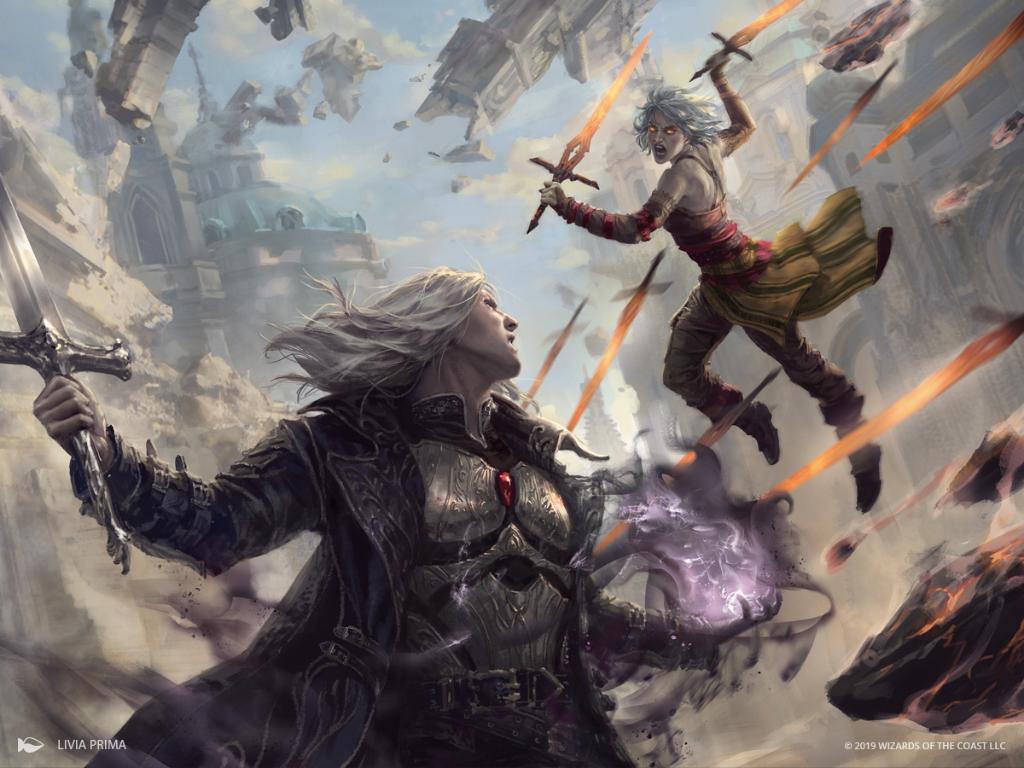

TM and copyright Wizards of the Coast
From www.artofmtg.com
Magic Options
This section includes additional options for spells, with personalization, increased spell slot flexibility, and an option to handle teleporting into melee. Each option can be used with any (or none) of the others, including Casting Roll, Disrupting a Spell, Degree of Success, and Overexertion.
Developing Spells
Players can have their own versions of spells that are mechanically identical but add flavor, and interest, by having a personalized appearance. Tasha's Cauldron of Everything† (Wizards of the Coast) formalizes this with excellent guidance on how to personalize a character's spells to fit a theme that is meaningful for them. If you are using the degree of success and casting roll options from this tome, the success margin also determines if the spell ends up looking the way it was intended.
This may inspire players to want to develop spells that are also mechanically different. This is a bigger undertaking, requiring a consideration of game balance, and in-game resources (time and cost). Balance is easier with variant spells than new ones and there is guidance under "Creating a Spell" (Dungeon Master's Guide†, Wizards of the Coast). One simple way to create variant spells is to add a metamagic-like enhancement to an existing spell, increasing its spell level by one. There are also many homebrew collections that may provide inspiration, although balance can be variable, depending on the source.
The option described below provides the in-game mechanics for developing that new spell, using a three stage
process: research, development, and testing. Each stage has a requirement in terms of time and cost that will need repeated if that stage is unsuccessful.
Level. The maximum level of spell a PC can develop should be one level below their own spell level in that class.
Time. It takes significant downtime to develop a new spell: 1 week per level, for each of the three stages.
Cost. Developing a new spell is also expensive. 100 gp per level per week is reasonable.
Stage 1 - Research. This stage reflects the study required to develop the theory underlying the spell. To successfully complete the research stage, you must succeed in an Arcana skill check (using your spellcasting ability) with a DC of 15 plus twice the spell level.
Stage 2 - Development. This stage represents the practical development of the spell from the research theory. It requires a successful Investigation skill check (using your spellcastingability) with a DC of 15 plus twice the spell level.
Stage 3 - Testing. This last stage reflects mastery of the spell to the point where it can be finalized and reliably cast. If using the casting roll option, the character must succeed in a casting roll with an additional penalty on the DC equal to the spell's level (so the DC is now 10 plus three times the spell level). If not using the casting roll option, you may substitute a successful Performance skill check (using your spellcasting ability), with a DC of 15 plus twice the spell level.
You may want to use the degree of success option for these sequential checks (page 4). Any critical failure means the spell can’t be attempted again, heavy failure that you must restart from Stage 1. The Stage 3 result would apply to the first time you then cast the spell.
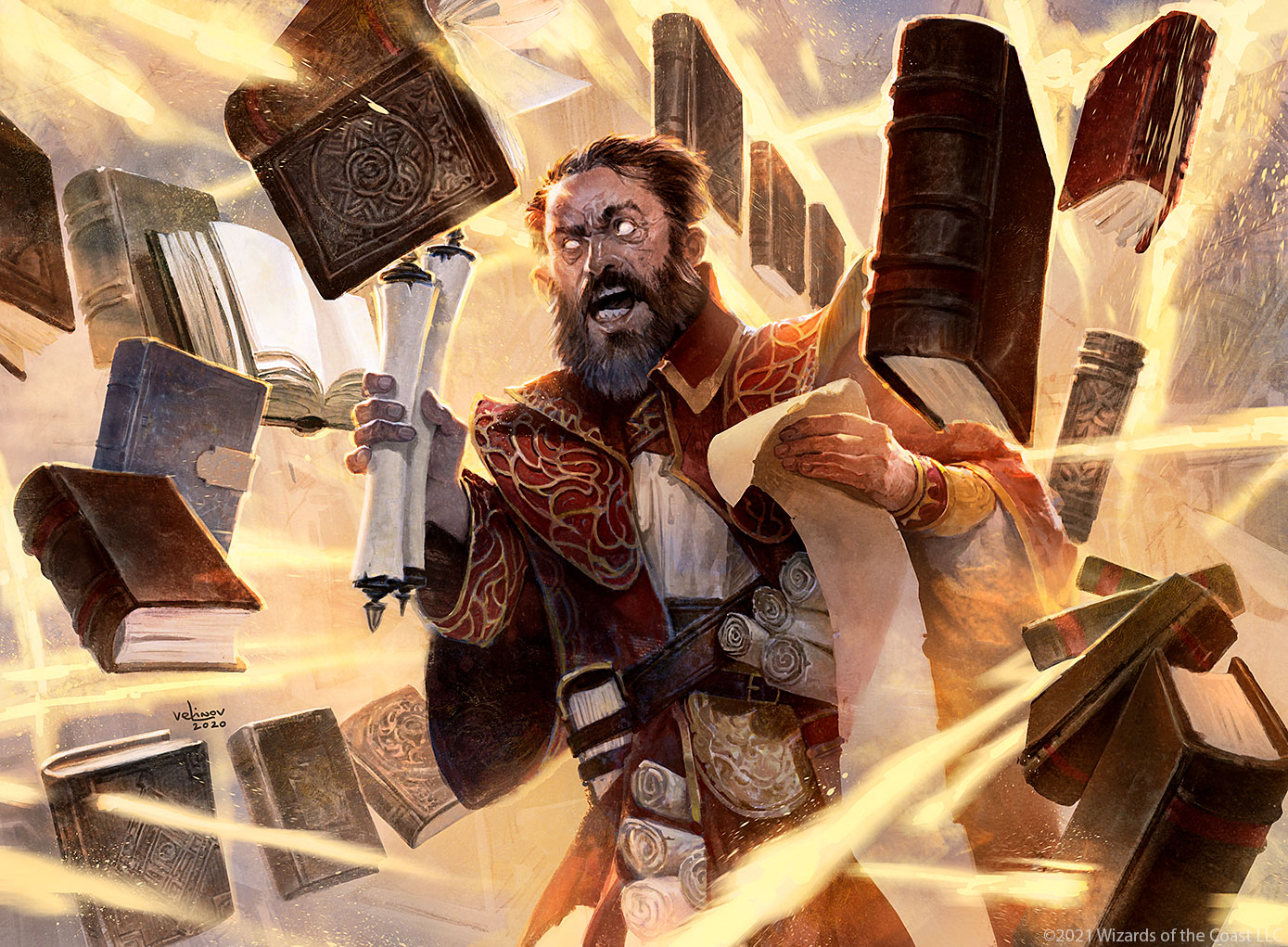

TM and copyright Wizards of the Coast
From www.artofmtg.com
TM and copyright Wizards of the Coast
From www.artofmtg.com
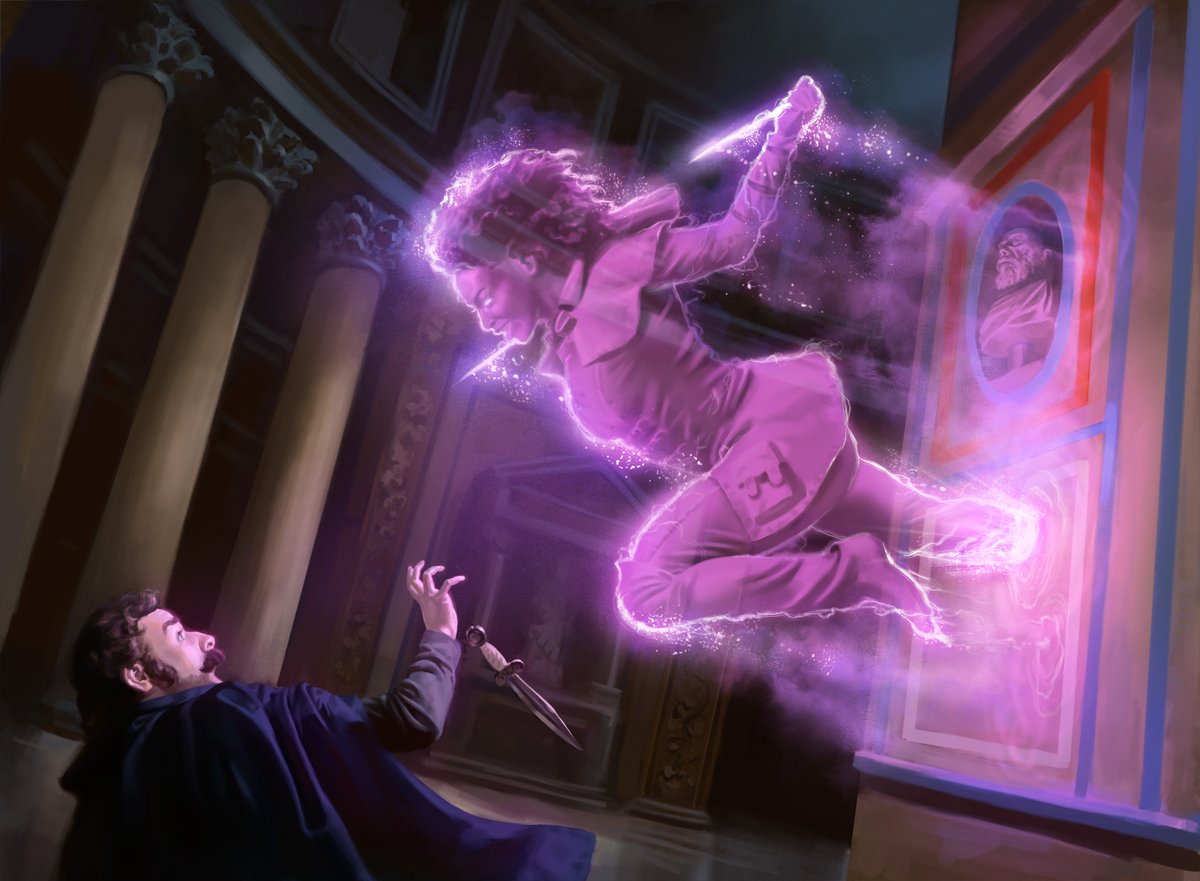

Teleporting Into Melee
Teleporting into combat is a classic scenario in fantasy literature. In fifth edition, this may cause Surprise when rolling initiative, and may give advantage on the attack roll if the teleporting creature was hidden. However, the effect during ongoing combat, or when the creature wasn't hidden, is less defined.
With this option, when you teleport to bring a creature within reach of your melee weapon and immediately attack, you gain advantage on that first attack roll. If you repeat this against the same creature, you only gain advantage if you're hidden and able to see your target before teleporting.
Casting Flexibility
These three options increase flexibility in which spells you can cast, and when.
Spell Flexibility
This option increases spell flexibility while also providing all casters with a tangible benefit from Intelligence. You know and can prepare a number of additional spells equal to your Intelligence modifier (this pool is shared if multi-classing) and can change those spells on a long rest. These spells must be from a spell list and level that you have access to and may include cantrip(s).
Improvised Spells
A related option for innate casters such as sorcerers is improvising a spell that they don't know, as suggested by Atsur. For this, a new metamagic option may be taken:
Spontaneous Spell
You can spend 3 sorcery points to try to cast a spell that you don't know. The spell must be from the sorcerer spell list and 5th level or lower. Expend a spell slot of that level or higher and when the casting duration is complete, make a spellcasting check (DC of 10 plus the spell’s level; adding your spell attack bonus to the roll). If you succeed, you then cast the spell as normal (you may not combine this with another metamagic option). If you fail, the spell is not cast and you instead cast a random cantrip, with a random target, from your class spell list. Alternatively, you may wish to use a "wild magic" table for failed attempts.
Spell Slot Flexibility
A simple option to increase spell slot flexibility at a cost is to allow a higher slot to be used for a lower level spell as usual, but to also allow two lower level slots to be sacrificed to recover a spent slot from the next level. So a player with two remaining level 3 slots and one remaining level 4 slot, could use the level 3 slots to recover an expended level 4 slot, and use the two level 4 slots they now have to recover an expended level 5 slot.
Equipment
Shields
These options apply uniformly to all typical shield shapes and sizes, since the trade-off between maneuverability versus cover of different designs is balanced by their effects on active versus passive defense. However, very small shields are a little different and are a separate option below.
Cover
Perhaps the most historically relevant role of shields. While outside of melee (i.e. not within reach of an opponent), you may take the Dodge action, or your reaction, to use your shield as three-quarters cover (+5 to AC and Dexterity saves) instead of its usual +2 to AC (from shield or from half cover).
Closing Range
If using the Closing Range option, a shield provides cover for the wielder when closing on an opponent with a longer reach weapon, so it doesn't provoke an opportunity attack.
Bucklers and Vambraces
Bucklers (very small shields) and vambraces (a form of forearm armor) can give a +1 bonus to AC when used in a free hand, so long as you have proficiency in shields. They don’t give the other benefits listed above but a buckler can be donned or doffed as an object interaction (doesn't use an action if it is the only object interacted with that turn) and vambraces allow the free hand(s) to perform other actions (e.g. sleight of hand or somatic components of a spell).
| Shield | Cost | Armor Class (AC) | Weight |
|---|---|---|---|
| Shield | 10 gp | +2 | 6 lb |
| Buckler | 10 gp | +1 | 2 lb |
| Vambraces (pair) | 15 gp | +1 | 3 lb |
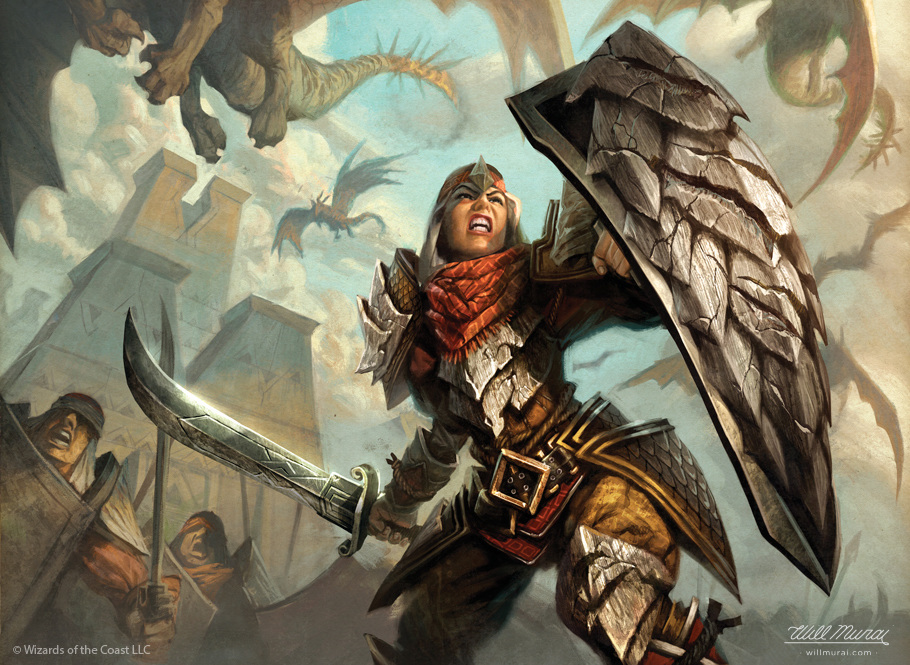


Quality, Repair & Bonuses
Many campaign settings have a region with more (or less) advanced metalcraft, or with superior or exotic materials, and nobody’s weapons or armor work quite as well once they have picked up some major dents from a 40ft fall or a bruising battle with a stone golem.
A simple way to bring this into your game is to give an item a +1 if it is expertly made, or a -1 if it is poorly or primitively made, or damaged. If bought or sold, the cost of the item also changes (a minimum of double, or half price, respectively).
Superior or exotic materials may affect other properties: weight (and hence strength requirement for armor), bulk/sound (removing stealth disadvantage), resilience (increased integrity die size, e.g. d12, see below), or material (e.g. non-metal). Each increases cost by a minimum of double.
- Damaged or poor quality weapon: -1 to attack bonus and damage
- Damaged or poor quality armor: -1 to AC (inc shields)
- Expertly made weapon: +1 to damage and/or attack bonus
- Expertly made armor: +1 to AC (not shields)
- Superior or exotic materials: altered properties
A damaged item can be repaired for half its new cost. PCs with the relevant artisan’s tools and proficiency (smith’s tools for metal, leatherworker's for leather, etc) may also make their own repairs (DC 15). A 1 hour repair lasts until a complete repair can be performed during downtime.
A +1 from quality isn't magical for the purposes of resistance or immunity to nonmagical weapons and the maximum total bonus from quality and any magical bonus remains +3 (and +3 should be reserved for high level play).
In many settings, a damage bonus of +3 is fine but bonuses to AC and attack bonus are best limited to +1 to better match the maximum AC and attack bonuses seen for monsters.
Instead of a further attack bonus, magic weapons can have increased damage (e.g. a d4 bonus to all damage rolls, or proficiency bonus once per combat), or a unique feature (e.g. a once-per-combat cantrip, once-per-day 1st level spell, or a negation of disadvantage effects), or a bonus to your Strength score (while staying within the ability score cap).
Instead of a further AC bonus, magic armor and shields can provide damage reduction (e.g. a d4 damage reduction every turn, or proficiency bonus oncer per combat), or a unique feature (such as limited-use damage resistance, save proficiencies, or temporary hit points).
Acquiring Damage
Optional sources of damage are described below:
Situational. This can be thematic as part of the campaign narrative, such as the example of the 40ft fall.
Critical fumble. There can be a chance of weapon damage on a critical fumble. You can choose the frequency of this to match the mood of the campaign. For most campaigns, use a d6 integrity die after a critical fumble, with damage occurring when you roll a 1 on the integrity die. However, a heroic campaign could use a d20 integrity die and a gritty campaign could use a d4. A superior weapon (see above) might use a larger integrity die (e.g. a d12 instead of a d6).
TM and copyright Wizards of the Coast
From www.artofmtg.com
Extreme damage. There can be a chance of armor damage when you take slashing, piercing or bludgeoning damage equal to your AC or more, in a single go. Again, a d6 integrity die roll would be used. Superior armor may use a larger integrity die (e.g. a d12). If you're wielding a shield, you can choose whether damage occurs to your shield or your armor.
Deliberate. If using the Called Shot option, allow an attacker to target (-10 penalty or 2 levels of disadvantage) the weapon, armor, or shield. Or -5 penalty (1 level of disadvantage) and allow an integrity die roll.
Added Weapon Properties
With this option, weapons are given one of three new properties to allow a little more differentiation between otherwise similar items. Those three properties are:
Reliable. A weapon that is designed for dependability in dealing damage. If you roll a 1 or 2 on a damage die, you may reroll the die.
Defensive. A weapon that is designed to parry or guard. +1 to your defense rolls and AC. If a defensive weapon is in your off-hand, +1 to your defense rolls only.
Penetrating. A weapon that is designed to get through defenses and armor. +1 to its attack (but not defense) rolls.
If using this option, a shield also gives +1 to defense rolls.
For simplicity, all monsters’ attacks can be treated as having the penetrating property.
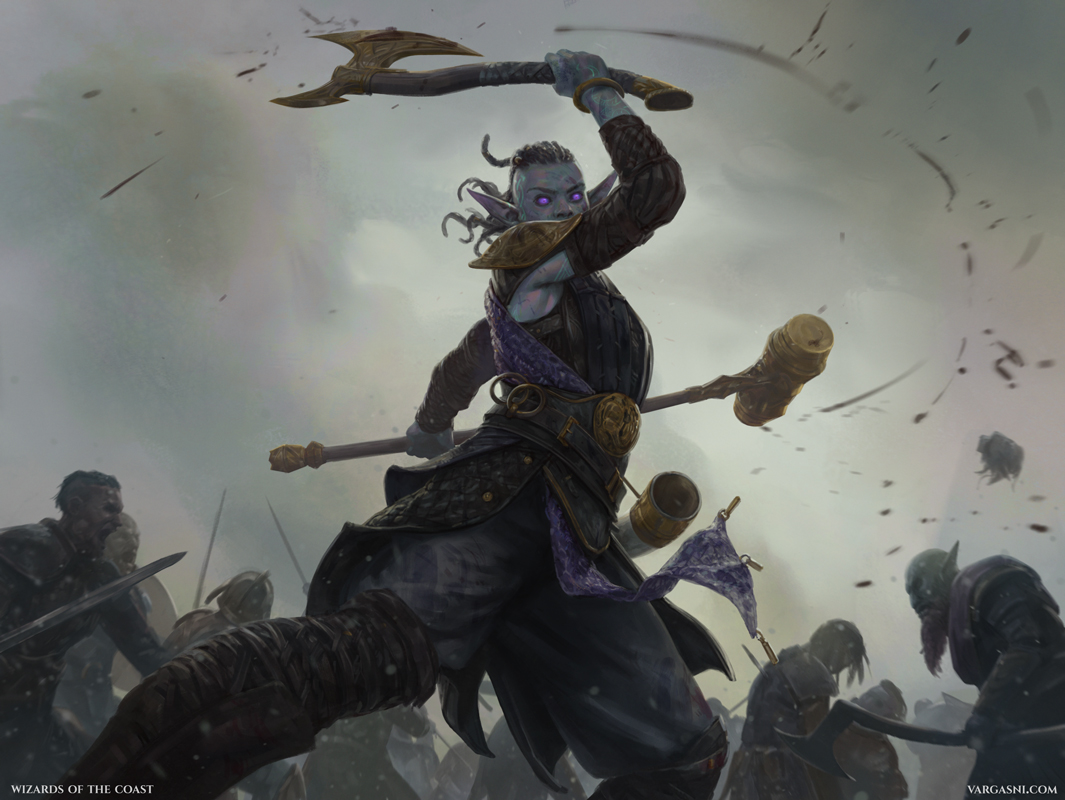


TM and copyright Wizards of the Coast
From www.artofmtg.com
Weapons (Part 1)
| Weapon | Cost | Damage | Weight | Properties |
|---|---|---|---|---|
| Simple Melee Weapons | ||||
| Club | 1 sp | 1d4 bludgeoning | 2 lb. | Light, reliable |
| Dagger / Dirk | 2 gp | 1d4 piercing | 1 lb. | Finesse, light, thrown (range 20/60), penetrating |
| Greatclub | 2 sp | 1d8 bludgeoning | 10 lb. | Two-handed, reliable |
| Handaxe | 5 gp | 1d6 slashing | 2 lb. | Light, thrown (range 20/60), penetrating |
| Javelin | 5 sp | 1d6 piercing | 2 lb. | Thrown (range 30/120), penetrating |
| Light Hammer | 2 gp | 1d4 bludgeoning | 2 lb. | Light, thrown (range 20/60), penetrating |
| Mace / Flail | 5 gp | 1d6 bludgeoning | 4 lb. | Reliable |
| (Quarter) Staff | 2 sp | 1d6 bludgeoning | 4 lb. | Versatile (1d8), defensive when two-handed |
| Sickle | 1 gp | 1d4 slashing | 2 lb. | Light, reliable |
| Spear | 1 gp | 1d6 piercing | 3 lb. | Thrown (range 20/60), versatile (1d8) |
| Simple Ranged Weapons | ||||
| Crossbow, light | 25 gp | 1d8 piercing | 5 lb. | Ammunition (range 80/320), loading, two-handed, penetrating |
| Dart | 5 cp | 1d4 piercing | 1/4 lb. | Finesse, thrown (range 20/60), penetrating |
| Shortbow | 25 gp | 1d6 piercing | 2 lb. | Ammunition (range 80/320), two-handed, penetrating |
| Sling | 1 sp | 1d4 bludgeoning | — | Ammunition (range 30/120), reliable |
Weapons (Part 2)
| Weapon | Cost | Damage | Weight | Properties |
|---|---|---|---|---|
| Martial Melee Weapons | ||||
| Arming Sword1 | 25 gp | 1d8 slashing | 3 lb. | Finesse, defensive |
| Battleaxe | 10 gp | 1d8 slashing | 4 lb. | Versatile (1d10), penetrating |
| Court Sword / Epee | 20 gp | 1d6 piercing | 2 lb. | Finesse, light, penetrating |
| Flail, long | 10 gp | 1d10 bludgeoning | 6 lb. | Heavy, two-handed, reliable |
| Glaive | 20 gp | 1d10 slashing | 6 lb. | Heavy, reach, two-handed, defensive |
| Greataxe | 30 gp | 1d12 slashing | 7 lb. | Heavy, two-handed, penetrating |
| Greatpick / Igorot | 10 gp | 2d6 piercing | 5 lb. | Heavy, two-handed, penetrating |
| Greatsword2 | 50 gp | 2d6 slashing | 6 lb. | Heavy, two-handed, defensive |
| Halberd | 20 gp | 1d10 slashing | 6 lb. | Heavy, reach, two-handed, penetrating |
| Hand-and-a-Half Sword3 | 30 gp | 1d8 slashing | 4 lb. | Versatile (1d10), defensive |
| Lance | 10 gp | 1d12 piercing | 6 lb. | Reach, special, penetrating |
| Main Gauche | 4 gp | 1d4 piercing | 1 lb. | Finesse, light, defensive |
| Martial Quarterstaff | 5 gp | 1d10 bludgeoning | 5 lb. | Finesse, two-handed, defensive |
| Maul4 | 10 gp | 2d6 bludgeoning | 10 lb. | Heavy, two-handed, penetrating |
| Military Spear | 2 gp | 1d6 piercing | 3 lb. | Thrown (range 20/60), versatile (1d8), reach |
| Morning Star5 | 15 gp | 1d8 piercing | 4 lb. | Reliable |
| Panzerstecher | 25 gp | 1d8 piercing | 3 lb. | Finesse, penetrating |
| Pike | 5 gp | 1d10 piercing | 18 lb. | Heavy, reach, two-handed, penetrating |
| Rapier | 25 gp | 1d8 piercing | 3 lb. | Finesse, defensive |
| Sabre6 | 25 gp | 1d8 slashing | 3 lb. | Finesse, reliable |
| (Light) Scimitar7 | 20 gp | 1d6 slashing | 2 lb. | Finesse, light, reliable |
| Shortsword8 | 10 gp | 1d6 piercing | 2 lb. | Finesse, light, defensive |
| Trident | 5 gp | 1d6 piercing | 4 lb. | Thrown (range 20/60), versatile (1d8), reach |
| War Pick | 5 gp | 1d8 piercing | 3 lb. | Penetrating |
| Warhammer | 15 gp | 1d8 bludgeoning | 3 lb. | Versatile (1d10), penetrating |
| Whip | 2 gp | 1d4 slashing | 3 lb. | Finesse, reach |
| Martial Ranged Weapons | ||||
| Blowgun | 10 gp | 1d4 piercing | 1 lb. | Amm.(range 25/100), loading |
| Crossbow, hand | 75 gp | 1d6 piercing | 3 lb. | Amm.(range 30/120), light, loading, penetrating |
| Crossbow, heavy | 50 gp | 1d10 piercing | 18 lb. | Amm.(range 100/400), heavy, loading, two-handed, penetrating |
| Longbow | 50 gp | 1d8 piercing | 2 lb. | Amm.(range 150/600), heavy, two-handed, penetrating |
| Net | 1 gp | — | 3 lb. | Special, thrown (range 5/15) |
1/Broadsword/Jian 2/Longsword/Medieval Claymore/Zweihänder 3/Bastard Sword/Katana/Spatha 4/Greathammer/Greatmace 5(Spiked Mace)/Ball-and-Chain Flail 6/Cutlass/Falchion/Falx/Kopis 7/Backsword/Dao/Machete/Messer 8/Gladius/Katar/Xiphos
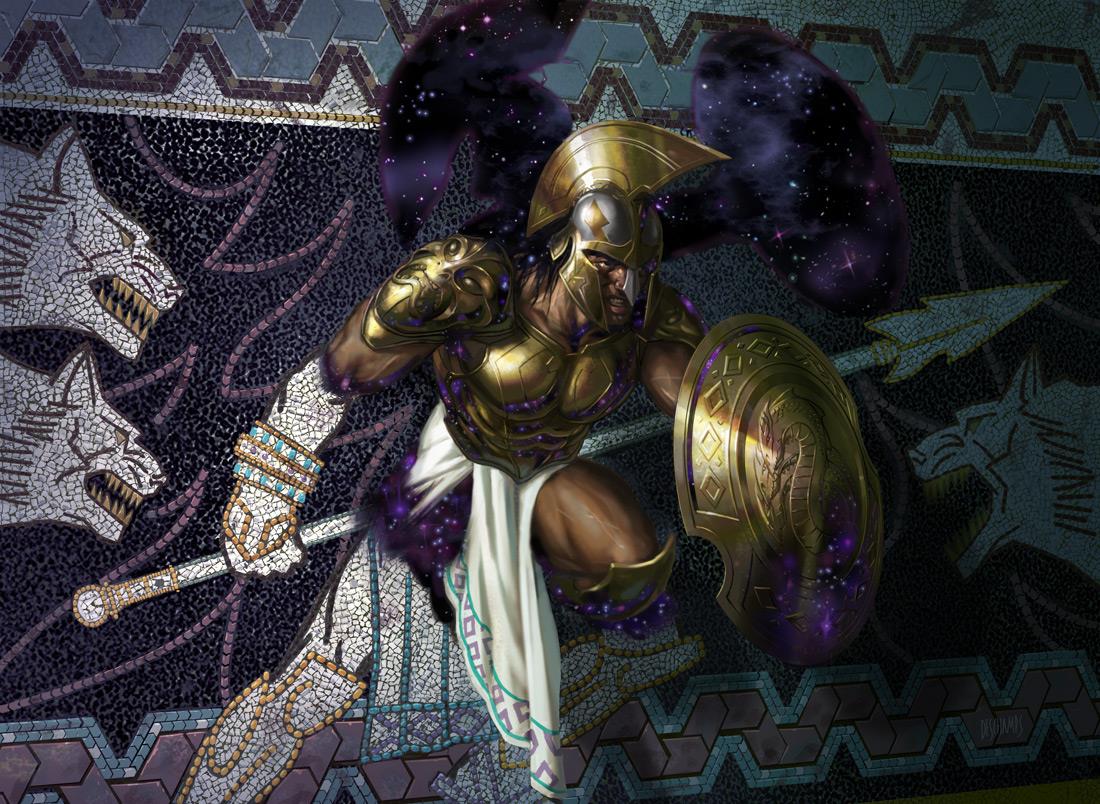


TM and copyright Wizards of the Coast
From www.artofmtg.com
Armor Options
The table below uses a generic armor classification to cover a wider variety of armors, including some historical examples.
Armor and Rest
Sleep in armor is less restful, so you can spend and recover half as many Hit Dice when taking a long rest with armor on.
Strength and Armor
As alternative to Strength thresholds, you are Lightly Encumbered if your armor's base AC modifier (base AC - 10) is greater than your Strength modifier, and Encumbered if it's greater that your Strength modifier + proficiency bonus.
Generic & Historical Armor
| Armor | Cost | Armor Class (AC) | Strength | Stealth | Weight |
|---|---|---|---|---|---|
| Unarmored | |||||
| Clothing1 | 1 gp | 10 + Dex modifier | - | - | 2 lb. / 0 slots |
| Light (light body, very light limbs) | |||||
| Toughened2 | 10 gp | 11 + Dex modifier (max 5) | - | - | 7 lb. / 1 slot |
| Reinforced3 | 45 gp | 12 + Dex modifier (max 5) | - | - | 12 lb. / 2 slots |
| Medium (heavy body; light limbs & head) | |||||
| Hide4 | 10 gp | 12 + Dex modifier (max 2) | - | - | 12 lb. / 2 slots |
| Chain shirt5 | 50 gp | 13 + Dex modifier (max 2) | - | - | 17 lb. / 3 slots |
| Breastplate6 | 350 gp | 14 + Dex modifier (max 2) | - | - | 22 lb. / 4 slots |
| Half plate7 | 750 gp | 15 + Dex modifier (max 2) | - | Disadvantage | 27 lb. / 5 slots |
| Heavy (heavy body, limbs & head) | |||||
| (Full) Metal-reinforced8 | 30 gp | 14 | - | Disadvantage | 22 lb. / 4 slots |
| (Full) Mail9 | 75 gp | 15 | Str 13 | Disadvantage | 27 lb. / 5 slots |
| (Full) Augmented mail10 | 200 gp | 16 | Str 13 | Disadvantage | 32 lb. / 6 slots |
| Three-Quarter plate11 | 500 gp | 17 | Str 15 | Disadvantage | 37 lb. / 7 slots |
| Full plate12 | 1,500 gp | 18 | Str 15 | Disadvantage | 42 lb. / 8 slots |
1Cloth, Robes, Softened Skins
2Layered Cloth, Suede, Light Leather, Light Hides
3Leather (Buff Coat, Jerkin), Quilted (Doublet, Gambeson, Padded Jack), +/- sparse metal reinforcement
4Heavy Hides, with any Toughened or Reinforced limb protection
5Chain Shirt/Hauberk, with any Toughened or Reinforced lining and limb protection
6Plated Body Armor (Splint, Lamellar, Scale/Lorica Squamata, Piecemeal, Brigandine, Coat-of-Plates, Banded/Laminar/Lorica Segmentate, Breastplate/Cuirass), with any Toughened or Reinforced lining and limb protection
7Plated Body Armor (usually Breastplate/Cuirass), with individually-fitted flexible metal armor on limbs (Chain, Scale, Splint)
8Metal-reinforced body, limb & head armor (e.g. Leather, Quilted with sewn-on Ring or other metal)
9Chain body, limb & head armor, with any Toughened or Reinforced lining
10Full mail reinforced with piecemeal plate (Splint, Lamellar, Scale, Piecemeal, Brigandine, Coat-of-Plates, Banded/Laminar)
11Full piecemeal plate (Splint, Lamellar, Scale/Lorica Squamata, Piecemeal, Brigandine, Coat-of-Plates, Banded/Laminar/ Lorica Segmentate) or incomplete/field plate (Breastplate/Cuirass & plate arms with piecemeal mail/plated legs)
12Full, individually-fitted, plate armor. Can wear for 1h (then short rest or reduce for Half or Three-Quarter plate for 1h)
Inventory Slots
Inventory slots are a simplified and streamlined approach to encumbrance that many players will be very familiar with from other games.
In the core rules, you can carry a total weight (in lb) of up to 5x your Strength score before becoming Encumbered. So 5 lb (2.5 kg) for every point of Strength. Most items are around 5 lb anyway, so you can instead simply use a number of 5 lb Inventory Slots equal to your Strength score.
Just use one line on your character sheet for each slot. You can double them up while Encumbered. Or triple them while Heavily Encumbered.
- Worn clothes and armor don't count (shields do). Worn armor has a separate Strength requirement or Encumbrance effect (see Armor Options above).
- Light items (coins, rings, potions) don't use slots unless you have an excessive number of them.
- Heavy items (personal tent, weapons with the heavy property) use 2 slots.
- And very heavy items use more (e.g. a set of spare armor requires a number of slots equal to its base AC modifier, i.e. base AC - 10)
So a rogue with a Strength score of 10, has 10 inventory slots. Their short sword and dagger don't count, neither does the hardened leather armor they're wearing, nor their thieves' tools, nor the 100 gp and 4 gems in their purse. But their lantern (with 10 days of oil), long bow, quiver (with 20 arrows), rope (20 ft), crowbar, disguise kit, food (5 days), water (5 days), bedroll, and tarp fill the 10 slots.
Inventory Slots
| Slots | Weight | Items |
|---|---|---|
| 0 | <3 lb | Weapons with the Light property (up to 2), ranged weapons that deal up to d6 damage (up to 2), money (<500 coins), potions (<10), rings, spell components, small instrument, thieves' tools, etc |
| 1 | ~5 lb | Most items, including weapons (except Light or Heavy), shields, quiver (20 arrows/bolts), spell book, basic food (5d), water (5d), lantern (10d oil), torches (10), rope (20 ft), change of clothes, crowbar, iron spikes (10), bedroll, tarp, healing kit, artisan's tools, etc |
| 2 | ~10 lb | Weapons with the Heavy property, tent (per person), etc |
Lightly Encumbered. An optional first stage of encumbrance. You are Lightly Encumbered when you use more Inventory Slots than half your Strength score. You gain 1 temporary Exhaustion level while Lightly Encumbered.
Encumbered. You are Encumbered when you use more Inventory Slots than your Strength score. You gain 2 temporary Exhaustion levels while Encumbered. Once you accumulate 1 hour of being Encumbered, you must take a short or long rest before doing so again.
Heavily Encumbered. You are Heavily Encumbered when you use more Inventory Slots than double your Strength score. You gain 3 temporary Exhaustion levels while Heavily Encumbered. Once you accumulate 1 minute of being Heavily Encumbered, you must take a short or long rest before doing so again.
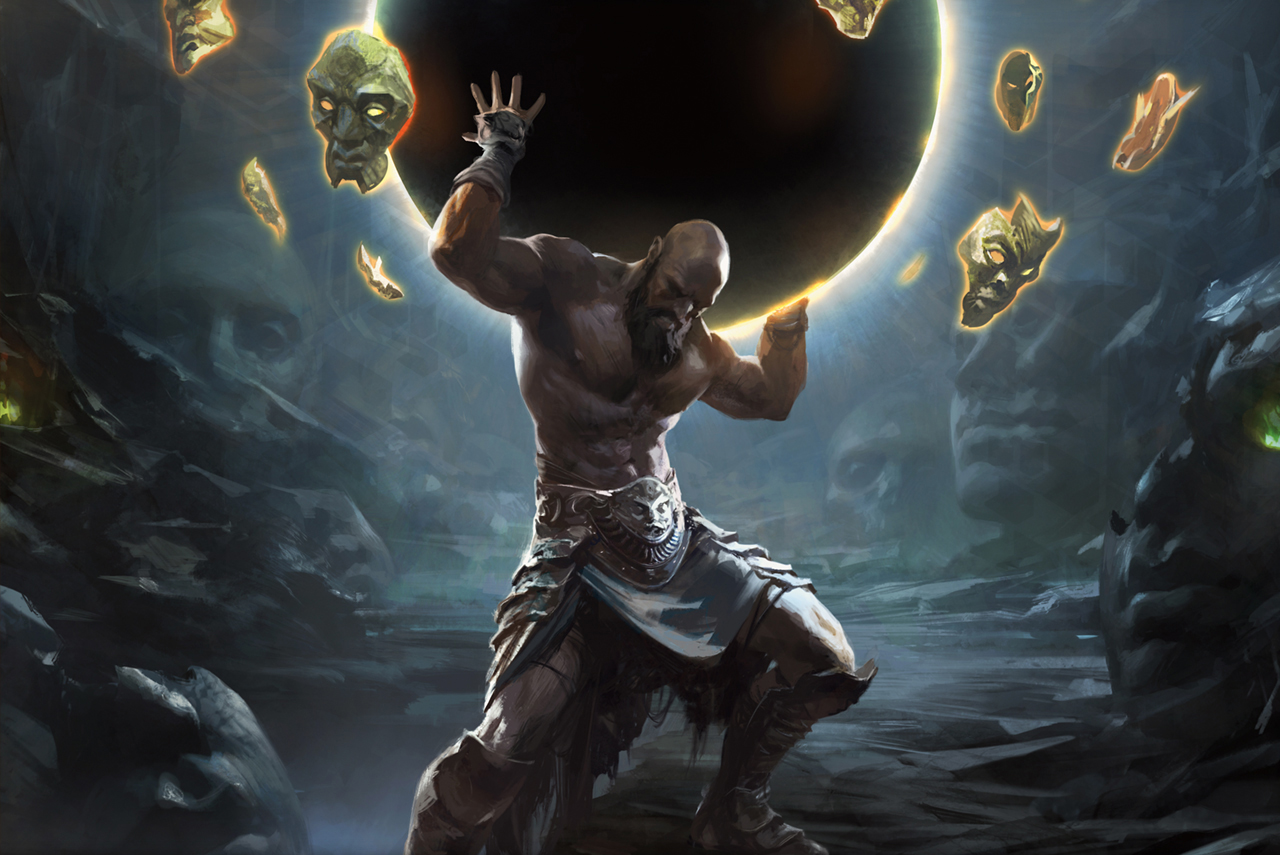

TM and copyright Wizards of the Coast
From www.artofmtg.com
Crafting Magic Items
The optional rules here build on the guidance under "Creating a Magic Item" in the Dungeon Master's Guide† (Wizards of the Coast), using an extension of the Developing Spells system (page 17). There are three main classes of magic item crafting: a magical bonus, an imbued spell and a bespoke effect. An item can be imbued with one of each.
Magical Bonus
This involves imbuing an item with magic energy, resulting in a bonus on rolls using that item - most commonly a weapon. Use the same required player level, time, cost and development checks as for developing a spell (page 17) of equivalent difficulty, as in the table below.
Equivalent Spell Level Difficulty
| Bonus | Equivalent difficulty |
|---|---|
| +1 | 3rd level spell |
| +2 | 6th level spell |
| +3 | 9th level spell |
Imbued Spell
This involves imbuing the item with the ability to cast a spell. You can only imbue a spell that you yourself can cast. The required player level, time, cost and development checks are equivalent to developing a spell of double that level. An imbued spell can be cast once every day (resetting at dawn) and has all the same properties, including casting time, as the original spell.
Equivalent Spell Level Difficulty
| Imbued spell level | Equivalent difficulty |
|---|---|
| Cantrip | See text |
| 1st level | 2nd level |
| 2nd level | 4th level |
| 3rd level | 6th level |
| 4th level | 8th level |
Cantrips
Cantrips are a special case. The required player level, time, cost and development checks depend on the number of times the cantrip can be cast per day (once is equivalent to a 1st level spell development, twice to a 2nd level, up to 8 which is equivalent to an 8th level spell development).
For cantrips that scale with player level, the level is that of the item wielder not the crafter.
Enhanced Spells
A spell may be enhanced with a metamagic version when it's imbued; treat this as increasing the spell level by one (and so increasing the difficulty level by 2). A spell may also be imbued to be cast more than once a day: increase the
equivalent difficulty level by 2 for each extra casting. Finally, a spell may be imbued at an upcast level; simply treat it as that higher level.
Charges
Instead of one or two spell castings that reset each day, an item may hold a number of charges, as is the case for many wands. Imbuing the spell follows the same rules and gives 1 charge. Additional charges (up to a maximum of 10) can be added (or restored) any time afterwards, either by the original crafter or more commonly by a suitable level arcane tradesperson in a major town. Each charge takes a number of days equal to the spell's level (minimum 1) and costs either 100 gp per day per level (half this cost is materials, half is profit) or 1/10 of the total value of the item.
Bespoke Effects
Bespoke effects might include breathing underwater, resistance to a damage type, an ability score increase, or a feat or class ability. Consider which spell, racial ability, class ability, feat, etc the effect is most like. This will determine the difficulty of the crafting.
A feat, racial ability or 2 point ability score increase is equivalent to a 5th level spell development, a half-version of the effect is equivalent to a 3rd level spell development. For a spell, use the spell rules above. For a class ability, the equivalent difficulty level is the level the class ability is gained.
The crafter must also have access to someone or something that has the desired ability, to model the crafting.
For all these effects, if the source effect is always on, then so is the magical version. If the source effect is used a limited number of times or day, then the magical version can be used only once per day (to imbue an additional use, add 2 levels to the equivalent spell development level).
TM and copyright Wizards of the Coast
From www.artofmtg.com
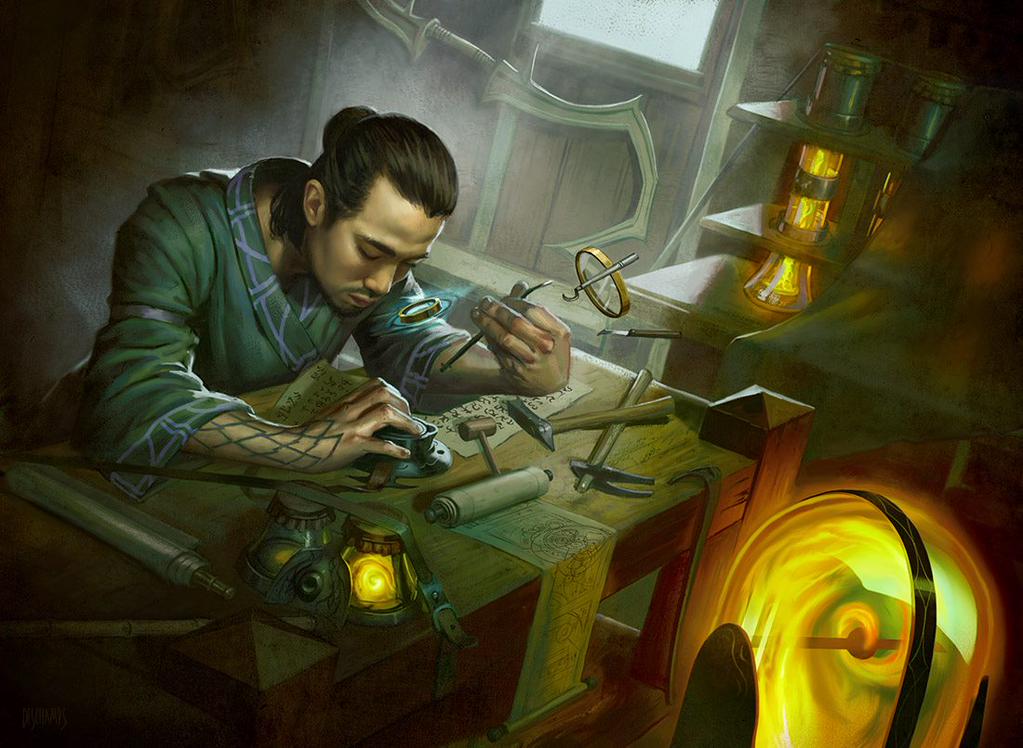


Feats
Feats that relate to combat or spellcasting can be adapted to make additional use of the options described in this Tome. These adapted feats, as well as twelve new feats, are described below. There are also additional variant options for gaining or replacing feats, as well as a re-working of two-weapon fighting that incorporates defensive fighting.
Adapted Feats
The feats in this section are adapted from the Player's Handbook† (Wizards of the Coast). Original mechanics are in plain text and Variance adaptations highlighted in bold.
"Alert"†
- You can’t be surprised while conscious.
- You have a +5 bonus to initiative.
- Other creatures don’t gain advantage on attack rolls against you as a result of being hidden from you, or teleporting to attack you.
- When you use the Ready action to prepare an Attack action and have the Extra Attack feature, you may also make those extra attacks as part of the attack. Any attack ability that usually applies once per turn may only apply once per round.
"Defensive Duelist"†
Prerequisite: Dexterity 13 or higher
If you're wielding a finesse weapon that you're proficient with when another creature attacks and hits you (whether melee, ranged or spell attack), you may use your reaction to make them roll an additional d20 and take the lower roll, potentially causing the attack to miss you.
"Great Weapon Master"†
- Whenever your attack reduces a creature to 0 hp, any excess damage from the attack may carry over to another creature within reach with the same AC or less. If the remaining damage reduces that creature to 0 hp, you may repeat this process, carrying over the remaining damage until there are no valid targets, or until the damage carried over fails to reduce a creature to 0 hp.
- On your turn, when you score a critical hit with a melee weapon or reduce a creature to 0 hit points with one, you may make a melee weapon attack as a bonus action.
- Before you make a melee attack with a heavy weapon with which you are proficient, you may take a penalty to the attack roll, up to your proficiency bonus. If that attack hits, you add double that amount to the attack's damage.
"Mage Slayer"†
- When a creature within reach of you begins casting a spell, you may use your reaction to make a melee weapon attack against that creature, potentially disrupting the spell.
- If you are not in melee (i.e. no opponents within reach of you) and a creature further than 5 feet from you begins casting a spell, you can use your reaction to make a ranged attack against that creature, potentially disrupting the spell.
- When you damage a creature that is concentrating on a spell, that creature has disadvantage on the saving throw it makes to maintain its concentration. This includes saving throws against having a spell disrupted.
- You have advantage on saving throws against spells cast by creatures within 5 feet of you.
"Lucky"†
You have 1 luck point. Whenever you make a d20 roll, you may spend 1 luck point to roll an additional d20. You may use this ability before or after the original roll, but before the outcome is revealed. You choose which of the d20s is used.
You may also spend 1 luck point when an attack roll is made against you. Roll a d20, and choose whether the attacker's roll uses their d20 roll or yours.
If multiple creatures use a luck point on the same roll, they cancel out, so there are no additional dice.
If you roll a natural 1 or 20 on the roll made when you spend a luck point, then you regain the luck point.
Otherwise, you regain the expended luck point when you finish a long rest.
"Sharpshooter"†
- Attacking at long range doesn't impose disadvantage on your ranged weapon attack rolls.
- Your ranged weapon attacks ignore half cover and treat three-quarters cover as half cover.
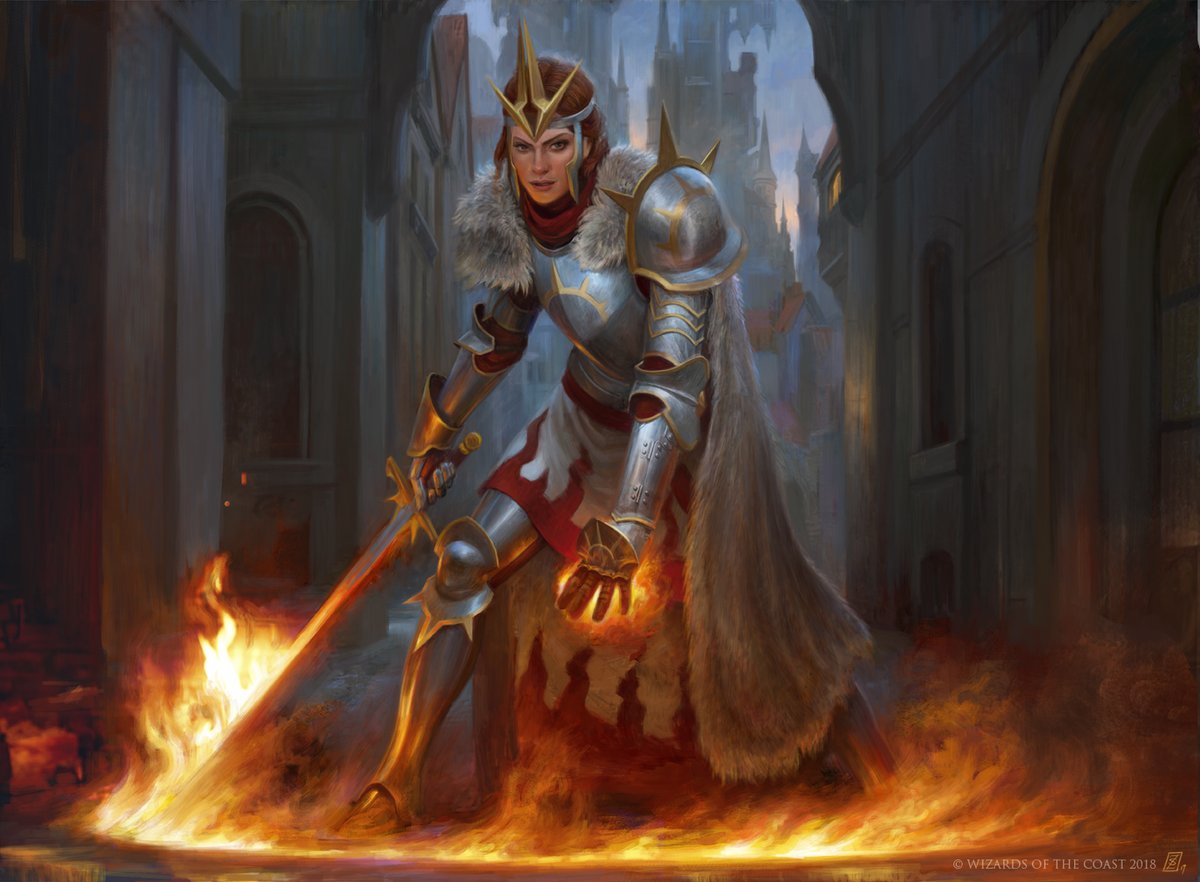


TM and copyright Wizards of the Coast
From www.artofmtg.com
- When you use the Ready action to prepare an Attack action for when creatures move in your line of sight and you have the Extra Attack feature, you may make those Extra Attacks too and trigger each attack separately. Any attack ability that usually applies once per turn may only apply once per round.
- Before you make an attack with a ranged weapon with which you are proficient, you may take a penalty to the attack roll, up to your proficiency bonus. If that attack hits, you add double that amount to the attack's damage.
"Spell Sniper"†
Prerequisite: The ability to cast at least one spell
- The range is doubled for any spell you cast that requires a spell attack roll.
- Your ranged spell attacks ignore half cover and treat three-quarters cover as half cover.
- When you use the Ready action to prepare a ranged spell attack for when creatures move in your line of sight, you may also use your bonus action to Ready a second ranged spell attack, so long as it has a casting time of a bonus action and one of the spells is a cantrip.
- You learn one cantrip that requires an attack roll. The cantrip must be from the bard, cleric, druid, sorcerer, warlock, or wizard spell list. Your spellcasting ability for the cantrip depends on the spell list it came from: Charisma for bard, sorcerer, or warlock; Wisdom for cleric or druid; or Intelligence for wizard.
"War Caster"†
You have practiced casting spells in the midst of combat, learning techniques that grant you the following benefits:
- You have advantage on Constitution saving throws that you make to maintain your concentration on a spell when you take damage. This includes saving throws against having a spell disrupted.
- You don't provoke an opportunity attack when casting a spell with a casting time of 1 action, even if its range is more than 15 ft.
- You can cast spells that have somatic components even if you have weapons or a shield in one or both hands.
- When a hostile creature's movement or actions provoke an opportunity attack from you, you may use your reaction to cast a spell at the creature, instead ofn making an opportunity attack. The spell must have a casting time of 1 action (or 1 bonus action) and must target only that creature.
Weapon Training "Weapon Master"†
Renaming the "Weapon Master"† feat as Weapon Training
- Increase your Strength or Dexterity score by 1, to a maximum of 20.
- You gain proficiency with 4 weapons of your choice.
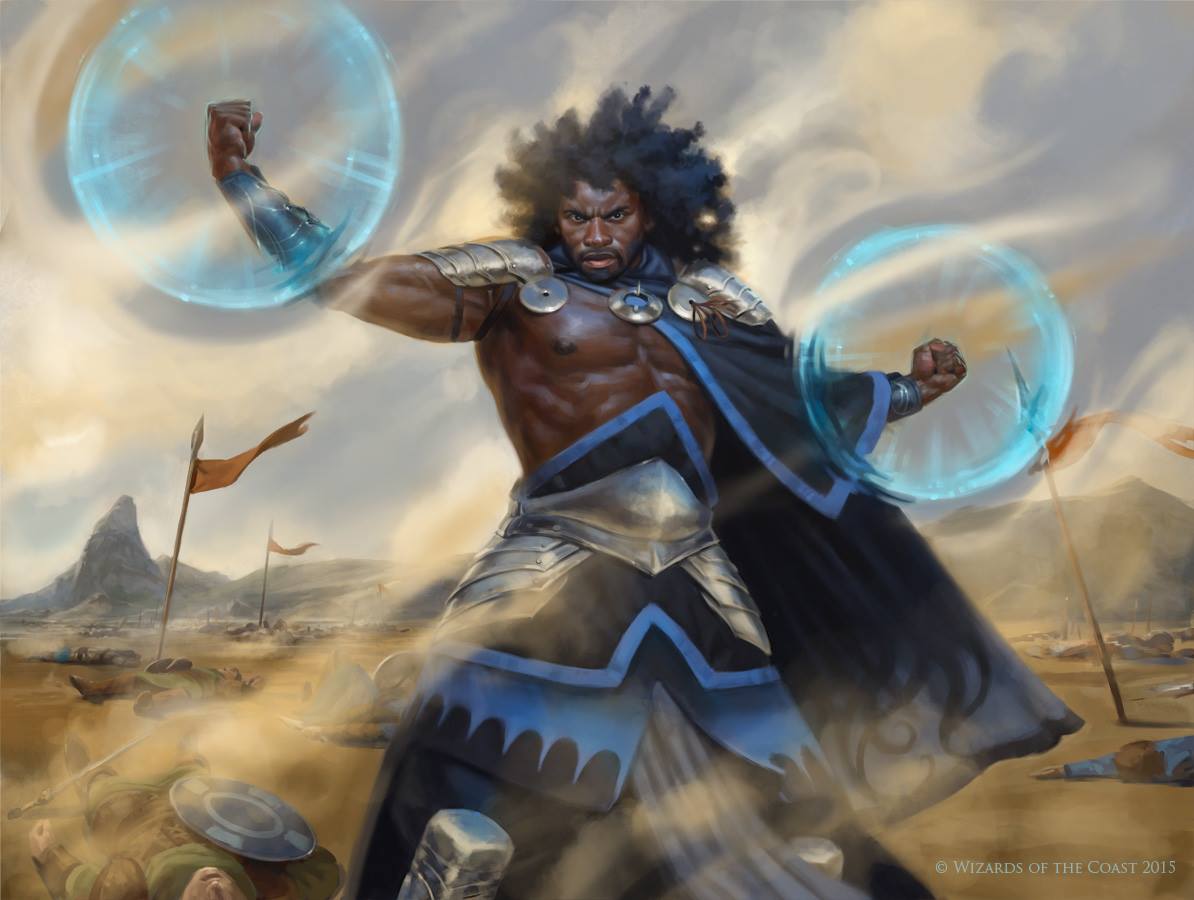


TM and copyright Wizards of the Coast
From www.artofmtg.com
New Feats
Aim Under Pressure
Thanks to extensive practice with making ranged attacks under close pressure, you gain the following benefits:
- Being within reach of a hostile creature doesn’t impose disadvantage on your ranged attack or ranged spell attack rolls.
- You don't provoke an opportunity attack when making a ranged attack or ranged spell attack.
- Having the frightened or poisoned conditions doesn’t impose disadvantage on your ranged attack or ranged spell attack rolls, or on your casting rolls.
Dynamic Duelist
When you make a successful defense roll opposing a melee attack, you can use your reaction to make a melee attack back at that creature, using that same roll. If you made your defense roll as a reaction (e.g. Reactive fighting style), you make this attack as part of same reaction.
Mental Expertise
Through extensive training, you are an expert in focusing your mind. You gain the following benefits:
- When you are subjected to an effect that allows you to make an Intelligence, Wisdom, or Charisma saving throw, you may use your reaction to add your proficiency bonus to your roll for that save. If you already have proficiency in that roll, you don't add a second bonus but instead gain advantage on the roll. You must use this reaction before you make the saving throw roll.
- When you are subjected to any effect aiming to read or alter your mind or senses, including any effect that allows you to make an Intelligence, Wisdom, or Charisma saving throw, you can make a DC 10 Arcana check (your choice of Intelligence, Wisdom, or Charisma) to identify the effect and, if successful, a repeat Arcana check (your choice of Intelligence, Wisdom, or Charisma) to identify the source. You don't need to use your reaction to do this.
- When you make a casting roll, you may use your reaction or bonus action to spend a Hit Die and add its roll to your casting roll (the Hit Die size is always d6). You must use this ability before the saving throw roll is rolled.
Mental Resilience
Accustomed to pushing through mental adversity, you gain the following benefits:
- When you are subjected to an effect that allows you to make an Intelligence, Wisdom, or Charisma saving throw, you may use your reaction to spend a Hit Die and add it to your roll for that save. You may use this reaction after you see the saving throw roll, potentially making a failed saving throw into a success (or changing the degree of success).
- When you are subject to an ongoing condition as a result of a failed Intelligence, Wisdom, or Charisma saving throw, you may take a level of exhaustion and end that condition as if you had succeeded in the saving throw.
Physical Resilience
Accustomed to pushing through physical adversity, you gain the following benefits:
- When you are subjected to an effect that allows you to make a Strength, Dexterity, or Constitution saving throw, you may use your reaction to spend a Hit Die and add it to your roll for that save. You may use this reaction after you see the saving throw roll, potentially making a failed saving throw into a success (or changing the degree of success).
- When you are subject to an ongoing condition as a result of a failed Strength, Dexterity, or Constitution saving throw, you may take a level of exhaustion and end that condition as if you had succeeded in the saving throw.
Shield Expertise
Prerequisite: Shield proficiency
Through extensive training, you have developed expertise in the defensive use of a shield. You gain the following benefits when you have a shield donned:
- You can use your defense rolls even when attacked with a ranged attack or ranged spell attack.
- Also, when another creature attacks you (whether melee, ranged or spell attack), you may use your reaction to give them disadvantage on their roll.
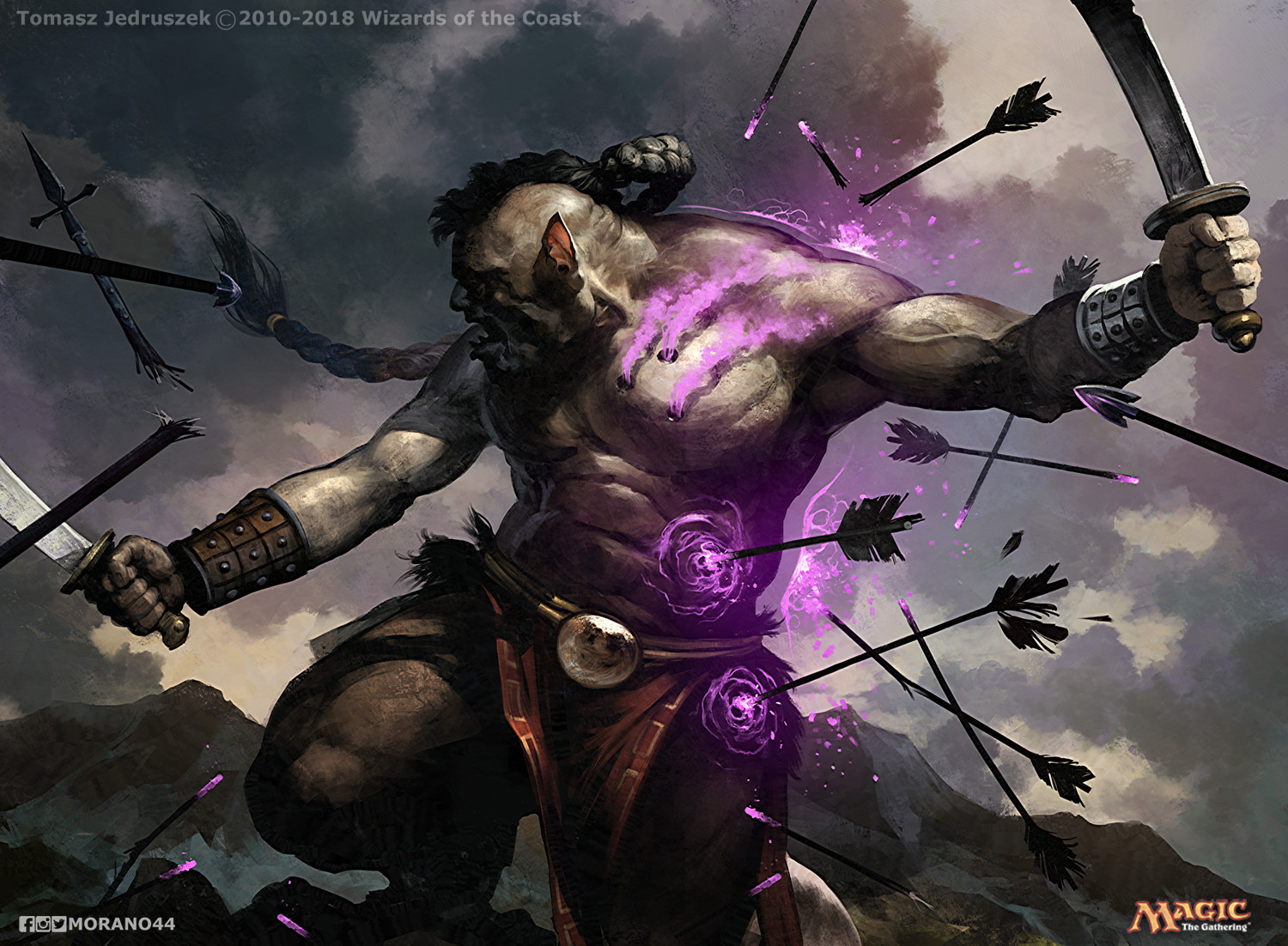

TM and copyright Wizards of the Coast
From www.artofmtg.com
- When you are subjected to an effect that allows you to make a Strength, Dexterity, or Constitution saving throw to avoid or reduce an effect when it first occurs, you may use your reaction to interpose or brace against your shield and add your proficiency bonus to your roll for that save. If you already have proficiency in that roll, you don't add a second bonus but instead gain advantage on the roll. You must use this reaction before you make the saving throw roll.
Spontaneous Caster (Origin: Atsur)
Prerequisite: The ability to cast at least one spell
Once per long rest, you can try to cast a spell that you don’t know. The spell must be from a spell level and list that you have access to, and must be 5th level or lower. Expend a spell slot of that level or higher and when the casting duration is complete, make a casting roll (DC of 10 plus the spell’s level; adding your spell attack bonus to the roll).
If you succeed, you cast the spell normally (you may not use metamagic options with this spell). If you fail, the spell is not cast and you instead cast a random cantrip, with a random target, from your class spell list. Alternatively, you may wish to use a "wild magic" table for failed attempts.
Versatile Caster
Prerequisite: The ability to cast at least one spell
You have an exceptionally breadth of spellcasting knowledge:
- You know and can prepare 1 extra spell. The spell must be from a level and spell list that you have access to, and must be 5th level or lower. You may change your choice of spell after you finish a long rest.
- You have advantage on Arcana checks related to spellcasting, including identification of a spell as it's being cast.
Vigilant
Prerequisite: Extra Attack class feature (or Thirsting Blade invocation)
Accustomed to the organized chaos of melee combat, you have developed a keen sense of combat awareness and can take advantage of opportunities that others may miss. Once during a round:
- You may take an additional reaction.
- Or you may gain an additional defense roll.
- Or if at the start of your turn you've not been attacked or targeted since your last turn, you may make an additional melee attack (against a creature in reach at that time).
You can use this feature a number of times equal to your proficiency bonus. You regain any expended uses when you finish a long rest.
Warlord / Martial Leadership
Prerequisite: Extra Attack class feature (or Thirsting Blade invocation)
A veteran of martial combat, your leadership skills can provide support and inspiration to those around you. To do so, you use a bonus action on your turn to choose one creature other than yourself within 60 feet of that you can communicate with. That creature gains an additional Martial Inspiration die, a d6.
Once within the next 10 minutes, the creature can use the die as an extra d6 Heroic Effort roll, without expending a Hit Die (page 10). Once the Martial Inspiration die is rolled, it is lost. A creature can have only one Martial Inspiration die at a time.
You can use this feature a number of times equal to your proficiency bonus. You regain any expended uses when you finish a long rest.
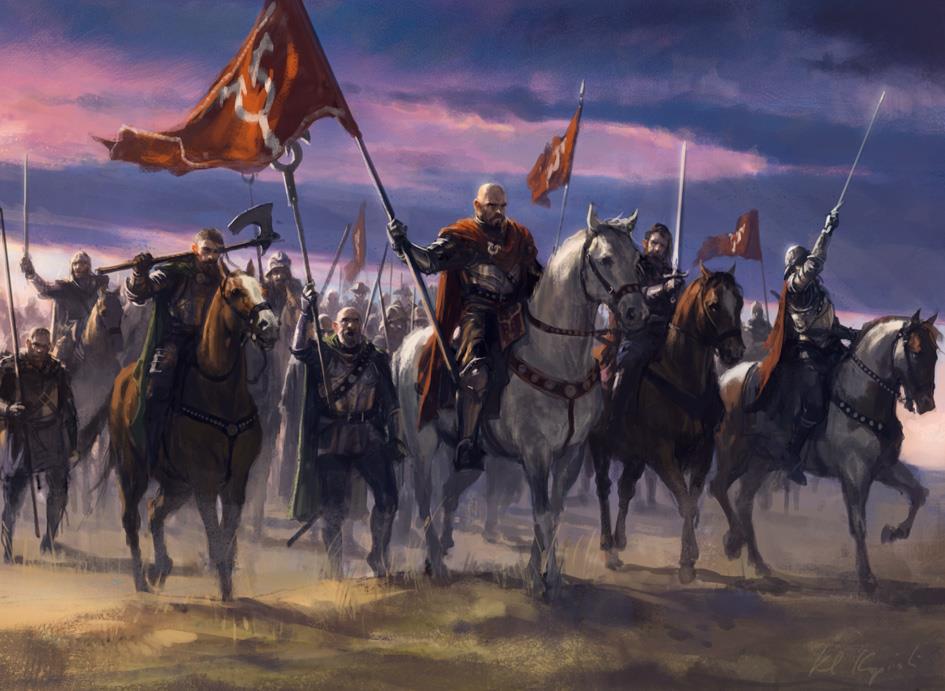

TM and copyright Wizards of the Coast
From www.artofmtg.com
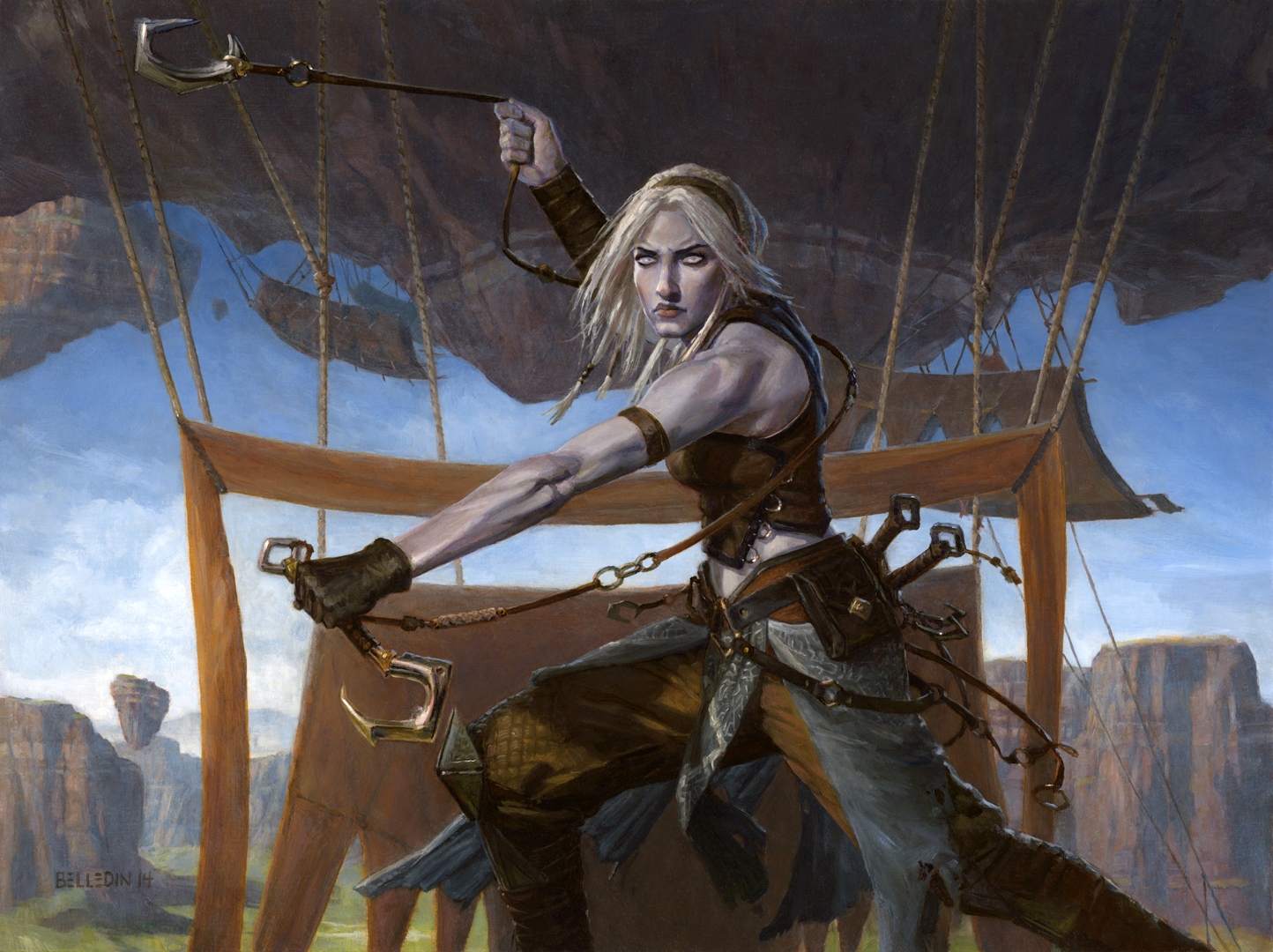

TM and copyright Wizards of the Coast
From www.artofmtg.com
Weapon Expertise
Through extensive training, you have developed expertise in a specific weapon. Choose a weapon that you have proficiency with or choose Unarmed Strikes. You may change your choice when you gain a level in a martial class. You gain the following benefits while you are wielding that weapon (or unarmed if unarmed expertise):
- When you roll to attack with that weapon (or the Unarmed Strike), you can use your reaction to gain advantage on the attack roll.
- When you successfully hit with that weapon (or the Unarmed Strike), you can use your reaction to add double your proficiency bonus to the damage.
- When you make a defense roll with that weapon, you can use your reaction to gain advantage on the defense roll.
Weapon Mastery
You have developed mastery of a specific weapon. Choose a weapon that you have proficiency with or choose Unarmed Strikes. You may change your choice when you gain a level in a martial class. You gain the following benefits while you are wielding that weapon (or unarmed if unarmed expertise):
- You gain a +1 to your attack bonus, AC, and damage.
- You have proficiency in Performance and Intimidation checks with that weapon (or unarmed if unarmed expertise) and may use Strength or Dexterity instead of Charisma for the check.
Additional Feat Options
Gaining Feats
At certain levels, your class gives you the Ability Score Improvement feature. With the standard feats option, you can forgo taking that feature to take a feat of your choice instead. However, with an expanding list of interesting feat options, it is very tempting to always choose the feat over the Ability Score Improvement feature, leading to minimal ability score progression over the game.
You may instead wish to use a variant of the Ability Score Improvement feature. At each level where your class gives you the Ability Score Improvement feature, you increase just one ability score of your choice by 1 but also take a feat of your choice. To balance this, you may wish to omit the initial ability score bonuses from race.
Feat Versatility
As you progress through your levels, your interests, focuses and specializations may shift and evolve. To reflect this, when your class gives you the Ability Score Improvement feature, you may replace a feat you have with another feat of your choice.
Wielding Two Weapons
Historically, a small second weapon was often used alongside a full-weighted primary weapon for defense (effectively a similar role to a buckler) or to use when fighting became close-pressed. Paired light weapons were common in some fighting styles / cultures and there is historical record of highly specialized individuals using paired full-weighted one-handed weapons. Below is an optional variant to the standard dual wielding rules, including a more defensive role where the size of the second weapon is of less importance and is instead used to gain 1 or more defense dice.
Two-Weapon Fighting
When you take the Attack action and attack with a light melee weapon that you're holding in one hand, you can use a bonus action to make an attack with a different light melee weapon that you're holding in the other hand (you don't add your ability modifier to the damage of the bonus attack, unless that modifier is negative).
If you choose not to make this bonus action attack with your second weapon, you gain +1 to AC and defense rolls until the start of your next turn.
If either weapon has the thrown property, you can throw the weapon, instead of making a melee attack with it.
Two-Weapon Fighting Style
You can use two-weapon fighting even when one of the one-handed melee weapons you are wielding isn’t light.
If both weapons are light, you can add your ability modifier to the damage of the second weapon.
"Dual Wielder"† Feat
So long as you are proficient with both of the weapons that you're using, you gain the following benefits:
- You can use two-weapon fighting, even when the one-handed melee weapons you are wielding aren’t light. If you have the Two-Weapon Fighting Style, you may add your ability modifier to the damage of both weapons.
- You can draw or stow two one-handed weapons when you would normally be able to draw or stow only one.
- When you use two-weapon fighting, the attack with your second weapon (or the defense die you may chose to gain instead) no longer requires your bonus action. You may choose to forgo this attack to gain an additional defense roll instead; if you do, you also gain +1 to AC and defense rolls until the start of your next turn.
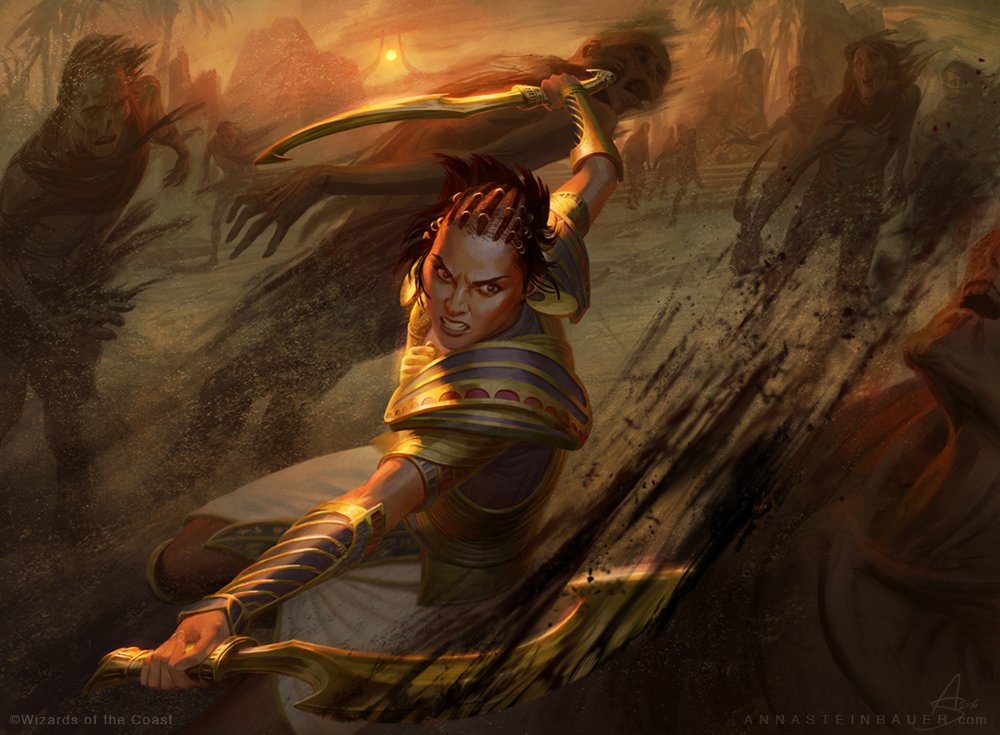

TM and copyright Wizards of the Coast
From www.artofmtg.com
Part 3
Experimental Options
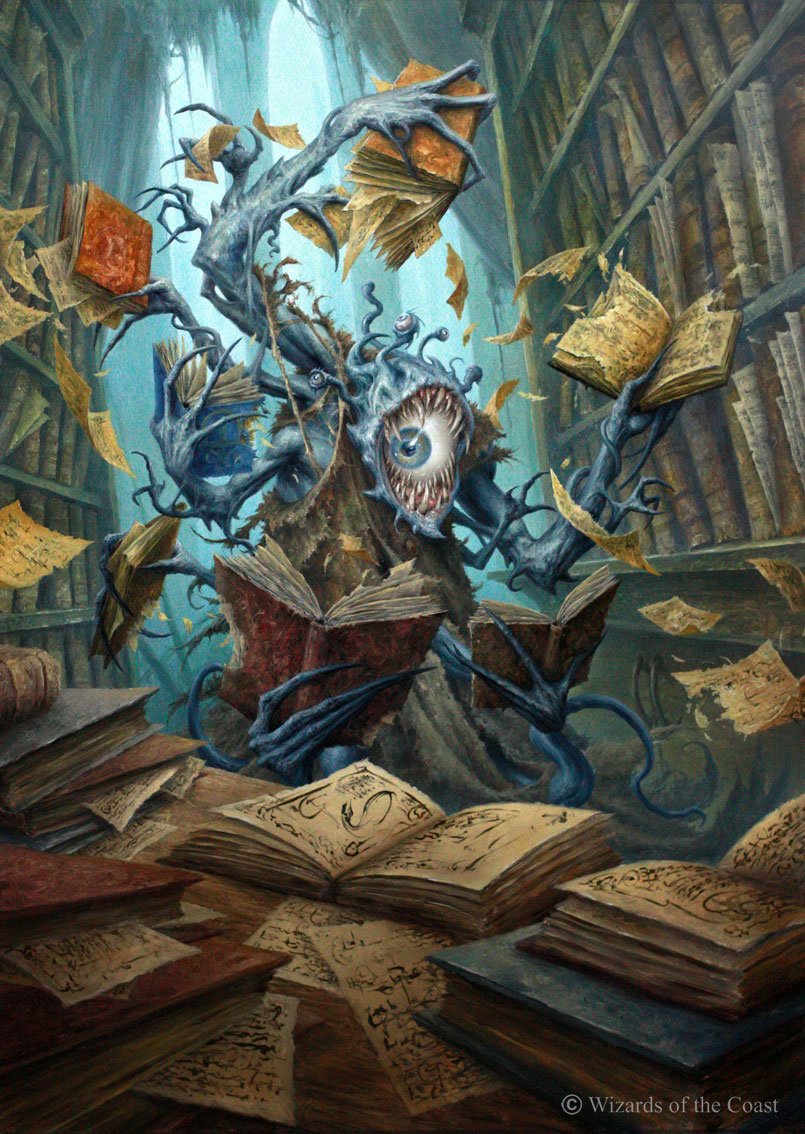

TM and copyright Wizards of the Coast
From www.artofmtg.com
Appendix A: Variant Sorcerer
The appendices in this third part of the handbook describe some more experimental options - the "unearthed arcana" of this Tome.
The underlying mechanical detail is a bit more exposed and the language a bit less polished. They have been included for those who like to try something a bit more experimental, with rough edges that may still evolve significantly. They are peripheral options, so have been separated out into these experimental appendices.
This first appendix introduces two new variants on spellcasting, designed to reflect the more innate nature of a sorcerer's magic, and the physical strain associated with that. Common to both is a different approach to spellcasting ability and a move away from spell slots to a system more grounded in the sorcerer's own health resources and constitution. However the two variants use very different approaches to the mechanics of such a magic system.
Spellcasting
You have an innate connection to raw arcane power that you can channel from within, or from the world around you. You tap that power to craft your magic, limited less by supply, and more by the strain of opening and controlling this font of arcane energy that fuels your spells.
Spellcasting Ability
While Charisma works well for bards as a spellcasting ability that's tied to social interaction, Intelligence appears a better fit for a warlock, and Wisdom for a paladin.
With these variant sorcerers, Constitution is your primary ability for control and supply of your magic, since your access to magic relies on your ability to cope with the raw energy that you tap. You use your Constitution when making casting rolls (for the Innate variant), or depend on it to hold on to the power you draw to fuel a spell (for the Channeler variant). Sometimes maintaining control of that arcane energy comes at a physical cost, taking a toll on your HD or hp.
However, you don't necessarily use your Constitution as your spellcasting ability. This depends on the nature of the spell you are casting. Sorcerers rely on their natural talents and have more affinity for spells that match those talents. Whenever a spell refers to your spellcasting ability, you use the ability that matches the spell save ability. For a spell attack, you choose any ability that you can use for a non-spell attack (usually Strength or Dexterity).
your modifier for the save ability
Spell attack modifier = your proficiency bonus + the ability modifier you use for non-spell attacks
Variant Casting (Replaces Spell Slots)
The variant sorcerers presented here don't use spell slots. Their use of spells is more fluid, although it's still a resource that becomes increasingly limited until restored with rest. The system used differs significantly between the two variants and is their defining feature, as described below.
Innate Variant
For the Innate variant sorcerer, your casting rolls (page 11) determine the number of spells you cast in a day. You use Constitution as your spellcasting ability score. If your casting roll succeeds, the spell is cast. If it fails, the spell fails and you can't attempt any further spells until you finish a short rest. On a heavy or critical failure, you can't attempt any further spells until you finish a long rest. You may use these options with or without other Degree of Success effects (page 12).
Each time you cast a spell, you get a cumulative -1 modifier to your casting roll. This resets when you finish a long rest. So if you've already cast 3 spells that day, you make your next casting roll with a -3 penalty. With this system, spells of your current level rapidly risk a failed roll and no further casting. A 5th level sorcerer may have a 75% chance of casting Fireball but is unlikely to succeed more than twice in a day, even if they cast no other spells. Low level spells are much more reliable, until the -1 modifiers add up.
You can overcome bad rolls by drawing on your own health energy. You may spend any number of Hit Dice to increase the roll (Hit Dice always count as d6s, even if you have larger Hit Dice available), or you can take a level of exhaustion to reroll.
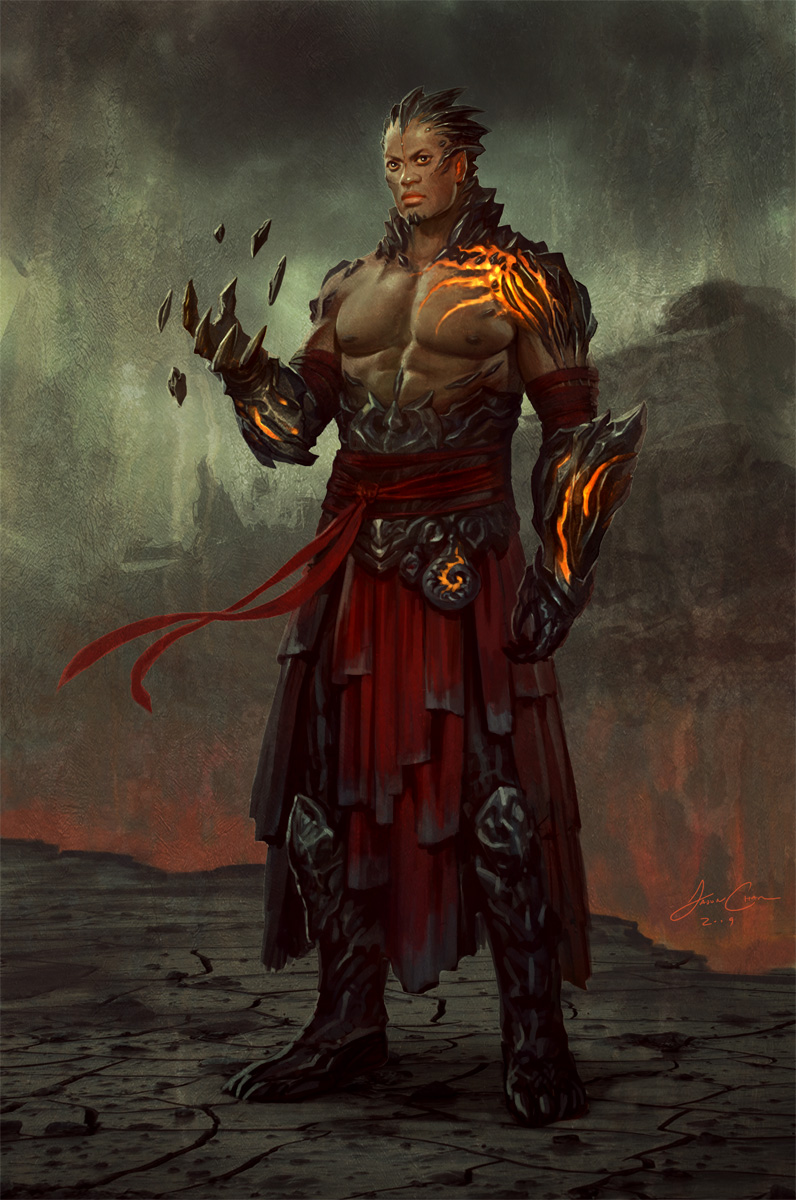


TM and copyright Wizards of the Coast
From www.artofmtg.com
Channeler Variant
For the Channeler variant sorcerer, the Spell Points system (Dungeon Master's Guide†, Wizards of the Coast) determines the number of spells you cast in a day. However, you don't have immediate access to the arcane energy, or mana, that fuels those spell points. Instead you can hold a small mana reservoir but need to draw more energy to cast larger spells. This mana comes from a Source to which you have a deep innate connection, whether elemental, natural or supernatural.
Drawing Mana. From 1st level, you are able to tap your Mana Source to channel arcane energy for your spells.
Tapping Mana. As a bonus action on your turn, you may tap mana from your Source, gaining mana up to the highest level of sorcerer spell you know. So a 5th level sorcerer who has access to 3rd level spells may tap up to 3 mana.
Gathering Mana. When you take the Cast a Spell action, you may Gather mana instead. This gains you mana up to the highest level of sorcerer spell you know plus your proficiency bonus. So the same 5th level sorcerer may gather up to 3 + 3 = 6 mana.
Heroic Effort. At any time, you may draw on your own health energy by spending a Hit Die to gain mana equal to that roll.
Mana Pool
The maximum mana you can channel before completing a long rest is determined by the pool of spell points available for your sorcerer level, where each mana is a spell point and the maximum pool increases from 4 at 1st level to 133 at 20th level.
Mana Reservoir
You can safely hold mana equal to the highest level of sorcerer spell you know, without needing control. This is known as your mana reservoir.
Controlling Mana. When you end your turn holding more mana than your reservoir, you may choose to release the excess (still counts to your daily maximum), or to try to keep hold of it by making a Constitution saving throw. The DC equals 10 plus the excess mana and a natural 1 is always a failure. If you fail this check, you lose all the mana you were holding and are unable to channel more until you finish a short rest.
Mana Burn. When you fail a Constitution saving throw to control excess mana, you may spend hit points or Hit Dice to add to that roll, potentially making the failed saving throw into a success. Or you may take a level of exhaustion to reroll.
Mana Stores. Some rare magic items may function as mana stores, increasing your mana reservoir.
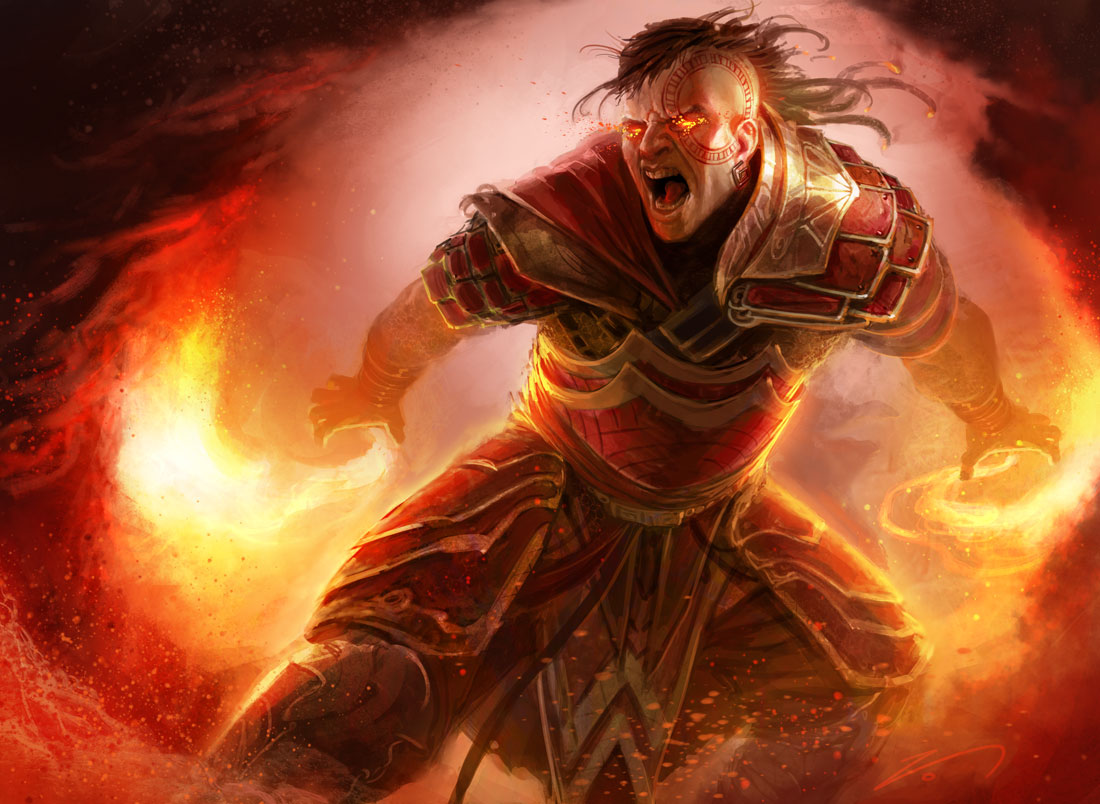

TM and copyright Wizards of the Coast
From www.artofmtg.com
Casting Spells
You spend mana to cast spells, again using the Spell Points system (Dungeon Master's Guide), where each mana is a spell point and costs increase from 2 spell points for a 1st level spell to 13 spell points for a 9th level one.
Life Energy Alternative
You can adapt the Channeler sorcerer to use a life energy Source. Life energy may be channeled sustainably (preservation magic) or drained unsustainably (defiling magic). For this adaptation, Tapping Mana is sustainable but Gathering Mana becomes an alternative bonus action with a life energy cost (hp lost for each mana gained). This may be voluntary, with hp split evenly between yourself and any number of willing allies. Or it may be involuntary, with hp split evenly amongst all creatures within 30 ft who fail a Constitution save with DC equal to 10 + your proficiency bonus + your Constitution modifier (if all creatures save, no mana is drawn).
Other Class Features
All other features for these sorcerer variants are shared with the standard sorcerer, except Flexible Casting.
Tapping Reserves
Since you don't use spell slots, Flexible Casting can't be used to generate sorcery points. This is replaced with Tapping Reserves. As a bonus action on your turn, you can spend a Hit Die to gain 1d6 sorcery points.
Appendix B: Blinkstep Rogue
Although this Tome is focused more on general rules than it is on classes etc, the variant sorcerer options explore new spellcasting mechanics and this rogue subclass explores a melee teleporter (page 18), fulfilling the archetype of the rogue who uses their magic to get in and out of impossible situations.
The Blinkstep Rogue
Some rogues augment their stealth and agility with magic, using tricks of movement and illusion. These might include street hustlers and burglars, but also mischief-makers, covert operators and, of course, adventurers.
Spellcasting
At 3rd level, you acquire the ability to cast spells.
Cantrips. You know three cantrips of your choice from the wizard spell list, two of which must be transmutation or illusion spells. You learn another at 10th level.
Spell Slots. The Blinkstep Rogue Spellcasting table shows how many spell slots you have. To cast a spell, you must expend a slot of the spell's level or higher. You regain all expended spell slots when you finish a long rest.
Spells Known of 1st Level and Higher. You know three 1st-level spells of your choice from the wizard spell list, two of which must be transmutation and illusion spells.
The Spells Known column of the Blinkstep Rogue Spellcasting table shows when you learn more wizard spells. Each must be a transmutation or illusion spell, at a level for which you have spell slots. The spells you learn at 8th, 14th & 20th level can come from any school of magic.
Whenever you gain a level in this class, you can replace one of the wizard spells you know with another spell from the wizard spell list, at a level for which you have spell slots. the new spell must be a transmutation or illusion spell, unless it's replacing the spell from any school of magic that you gained at 3rd, 8th, 14th, or 20th level.
You learn additional spells with some of your Roguish Archetype features. You may cast these a set number of times without expending spell slots or spell components and without requiring a casting roll (page 11), but may also cast them with a spell slot if available.
Spellcasting Ability. Intelligence is the spellcasting ability for your wizard spells:
your Intelligence modifier
Spell attack modifier = your proficiency bonus +
your Intelligence modifier
Unearthly Step
Starting at 3rd level, you can cast Misty Step with this feature a number of times equal to your proficiency bonus. You regain expended uses when you finish a long rest.
At 9th Level, when an attacker that you can see deals damage to you, you can use your reaction to move up to 15’ away and and the damage dealt is halved.
At 13th level, you can cast Misty Step at will, as if it were a cantrip for you.
Rogue Magic
Starting from 3rd level, in addition to your Blinkstep Rogue spells and Unearthly Step, you learn a Rogue Magic spell. You may cast this spell once with this feature and regain the ability to do so when you finish a long rest. Doing so doesn't require spell components and doesn't expend a spell slot. At 9th level and 13th level, you learn an additional Rogue Magic spell that you may cast instead.
At 3rd level, choose one Rogue Magic spell from the following list: blur, invisibility, or pass without trace.
At 9th level, choose another Rogue Magic spell, either: blink, gaseous form, or haste.
At 13th level, choose a third Rogue Magic spell, either: dimension door, etherealness, or greater invisibility.
Blinkstep
At 17th level, you gain the ability to teleport at will. You may use any of your movement to teleport that distance instead, including breaking up teleportation before and after your actions or between attacks. Movement while teleporting does not provoke opportunity attacks and you may move through objects and creatures, so long as you can see the location that you are teleporting to.
You may also use your reaction to move up to 15’ at any time. Any damage being dealt to you at the time is halved.
Blinkstep Rogue Spellcasting
| Rogue Level | Cantrips Known | Spells Known | 1st | 2nd | 3rd | 4th |
|---|---|---|---|---|---|---|
| 3rd | 3 | 3 | 2 | - | - | - |
| 4th | 3 | 4 | 3 | - | - | - |
| 5th | 3 | 4 | 3 | - | - | - |
| 6th | 3 | 4 | 3 | - | - | - |
| 7th | 3 | 5 | 4 | 2 | - | - |
| 8th | 3 | 6 | 4 | 2 | - | - |
| 9th | 3 | 6 | 4 | 2 | - | - |
| 10th | 4 | 7 | 4 | 3 | - | - |
| 11th | 4 | 8 | 4 | 3 | - | - |
| 12th | 4 | 8 | 4 | 3 | - | - |
| 13th | 4 | 9 | 4 | 3 | 2 | - |
| 14th | 4 | 10 | 4 | 3 | 2 | - |
| 15th | 4 | 10 | 4 | 3 | 2 | - |
| 16th | 4 | 11 | 4 | 3 | 3 | - |
| 17th | 4 | 11 | 4 | 3 | 3 | - |
| 18th | 4 | 11 | 4 | 3 | 3 | - |
| 19th | 4 | 12 | 4 | 3 | 3 | 1 |
| 20th | 4 | 13 | 4 | 3 | 3 | 1 |
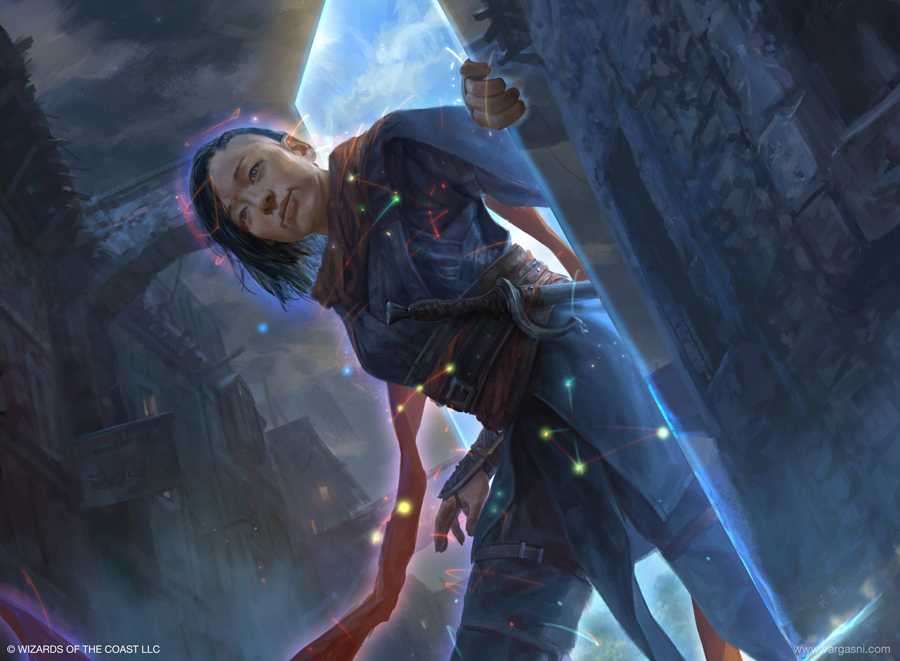


TM and copyright Wizards of the Coast
From www.artofmtg.com
Appendix C: Bounded Accuracy
Degree of success works best when all degrees can occur but the most extreme ones are uncommon. Bounded accuracy (a design principle aiming to keep the maximum range of results relatively narrow) helps with this. However, bounded accuracy in fifth edition has widened over time as new sources of bonuses have led to potentially large cumulative effects. The bounded accuracy options described here aim to address that, using a similar approach to Paizo's Pathfinder‡ system.
Modifiers Don't Stack
With this change, any positive modifiers beyond your proficiency bonus and an ability score modifier generally don't stack with each other. Instead, only the largest single bonus from your equipment (e.g. magical bonuses or Added Weapon Properties) and the largest single bonus from any effects or features (e.g. spells, Bardic Inspiration, Heroic Effort, etc) are applied. So magical bonuses from multiple items don't stack and neither do situational bonuses from multiple "buffing" spells.
For bonuses that involve dice, roll the dice and use the highest roll from amongst them. Compare this with any fixed bonuses, if there are any, to choose the largest single bonus.
Ability Checks & Saves
Items. Bonuses such as from the Cloak of Protection, Ioun Stone - Protection or Ring of Protection, effects) don't stack with each other.
Effects. These are often from spells or abilities; only use the highest bonus (e.g. Bardic Inspiration, Bless, Guidance, Heroic Effort, Resistance, aura effects, etc).
Attack Bonus
Your Attack Bonus continues to include your proficiency bonus and the ability modifier you use for that attack.
Items. Only add the highest equipment/item bonus (e.g. a +1 weapon, or an Added Weapon Property for attack or defense rolls)
Effects. Likewise, only add the highest effect/feature bonus (e.g. from the Archery fighting style, Bardic Inspiration, Bless, Focused Aim, Foe Slayer, Sacred Weapon, Weapon Expertise, etc.)
Spell Attack Bonus & Save DC
Your Spell Attack Bonus also continues to include your proficiency bonus and your spell ability modifier. As does your Spell Save DC or Casting roll. Modifiers to these are uncommon (most often from a magic item or from Heroic Effort), but again only use the highest item bonus and highest effect bonus.
Armor Class
The +2 bonus from a shield, the +2 or +5 from cover, or the potential +1 bonus from two-weapon fighting don't stack with each other but do stack with other bonuses.
TM and copyright Wizards of the Coast
From www.artofmtg.com
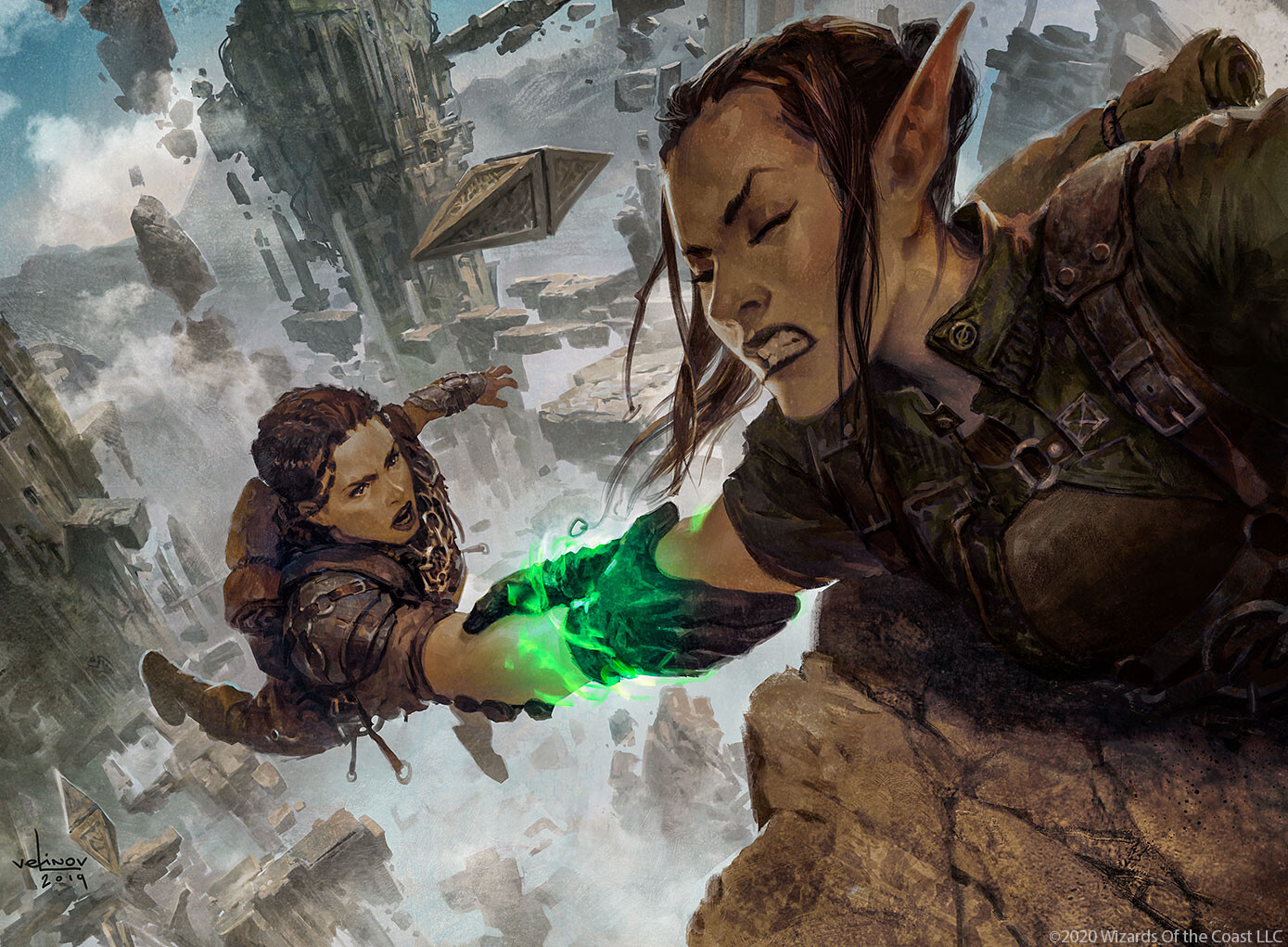


Items. Armour and equipment bonuses, such as natural armor, Unarmoured Defense, and magical bonuses from armor, shields, or other items (e.g. Cloak of Protection, Ioun Stone - Protection, Ring of Protection, Defender weapons, etc) don't stack with each other.
Effects. Bonuses from the Defense fighting style, Haste, Heroic Effort, Multiattack Defense, Shield, Shield of Faith, etc, also don't stack with each other.
So if a fighter with the Defense fighting style, +1 plate armor, a +1 shield and wielding a sword (defensive property), has Haste and Shield of Faith cast on them, their AC is 23: 18 (plate AC) +2 (wielding shield) +1 from items (from one of their magical items, or the sword) + 2 from effects (Haste or Shield of Faith replaces the fighting style bonus).
Expertise
At higher levels, Expertise adding a second proficiency bonus can begin to stretch Degree of Success. If you are using the Stacking Advantage and Disadvantage option, then Expertise can instead confer one level of advantage. The Mental Expertise, Shield Expertise and Weapon Expertise feats also use this.
- If you're using the "Proficiency Dice" option (Dungeon Master's Guide†, Wizards of the Coast), Expertise with Proficiency Dice is instead advantage on the Proficiency Die roll.
Epic Level Play
At levels above 20 (or with magic items such as some of the Manuals), the ceiling on Ability Scores might be raised. it's best to limit this to a maximum of a 24 and in a single stat (with the exception of barbarians with the Primal Champion feature, who have both Strength and Constitution).
‡ Paizo Inc.
Appendix D: Arcane Melee
This new and very experimental appendix describes a feat system for two broad groups of cantrips that can be used in melee combat to enable the archetype of a warrior channeling magic energy through their attacks, or a magic user controlling a weapon of pure energy. This pre-dates the fifth edition 2024 playtests but will adapt to them after the 2024 release.
Arcane Warrior
You have developed a strong connection with an arcane source that channels through you to manifest as a weapon of pure energy. You may choose its appearance. You gain the following benefits:
- Increase your Wisdom, Intelligence or Charisma score by 1, to a maximum of 20. This is your spellcasting ability for the Arcane Weapon cantrip.
- You learn the Arcane Weapon cantrip and choose one damage type from acid, cold, fire, lightening, or poison. At 8th level, you choose another damage type also including force, necrotic, radiant, psychic, or thunder.
- You gain access to the Strike arcane maneuver and a number of additional arcane maneuvers equal to your Proficiency Bonus; you may change your choice whenever you gain a level.
Arcane Attack
cantrip evocation
- Casting Time: 1 action
- Range: Self (5-foot radius)
- Components: V, M (a melee weapon)
- Duration: Instantaneous
You don't need a free hand to cast this cantrip. Choose an Arcane Attack damage type and maneuver that you know. As part of your attack action, you channel arcane power through
your weapon, unleashing it with your first attack roll. The attack benefits from your chosen arcane maneuver and has an appearance suitable to the damage type and maneuver (e.g. an Acid Punch may manifest as a dripping green fist that blasts out the end of your battelaxe).
The same d20 roll that's used for your attack roll is used for the cantrip's casting roll.
Battle Mage Initiate
You have developed an affinity for leaping into the fray to wild your in melee. This grants you the following benefits:
- You learn the Arcane Strike cantrip and gain access to one damage type from acid, cold, fire, lightening, or poison.
- You gain access to the Strike arcane maneuver and a number of additional arcane maneuvers equal to your Proficiency Bonus; you may change your choice whenever you gain a level.
- You know Mage Armor and can cast it once per day without expending a spell slot. When you cast Mage Armor on yourself, your AC becomes 13 + your Dexterity modifier, or 13 + your Proficiency Bonus, whichever is higher.
Battle Mage
Prerequisite: Battle Mage Initiate
You have further honed your skills in arcane melee. This grants you the following benefits:
- You gain access to another damage type to use with the Arcane Strike cantrip, either force, necrotic, radiant, psychic, or thunder.
- You gain access to an additional number of arcane maneuvers equal to your Proficiency Bonus; you may change your choice whenever you gain a level.
- When you make a successfully attack with the Arcane Strike cantrip, you may then use your bonus action to cast a spell that normally has a casting time of 1 action. You may do this a number of times equal to your Proficiency Bonus and regain expended uses after you complete a long rest.
Arcane Weapon
cantrip evocation
- Casting Time: 1 action
- Range: Self (5-foot radius)
- Components: S, V
- Duration: Instantaneous
Choose an Arcane Weapon damage type and maneuver that you know. You create an arcane force, with appearance suitable to the damage type and maneuver, that you may wield in a spell melee attack against one creature within 5 feet of you (e.g. a Lightening Slam may manifest as a blue hammer, crackling with electricity, that extends from you arm to strike your opponent). The attack benefits from your chosen arcane maneuver and a successful hit deals 1d8 of your chosen damage type. The damage dice increase to 2d8 at 5th level, 3d8 at 11th level, and 4d8 at 17th level.
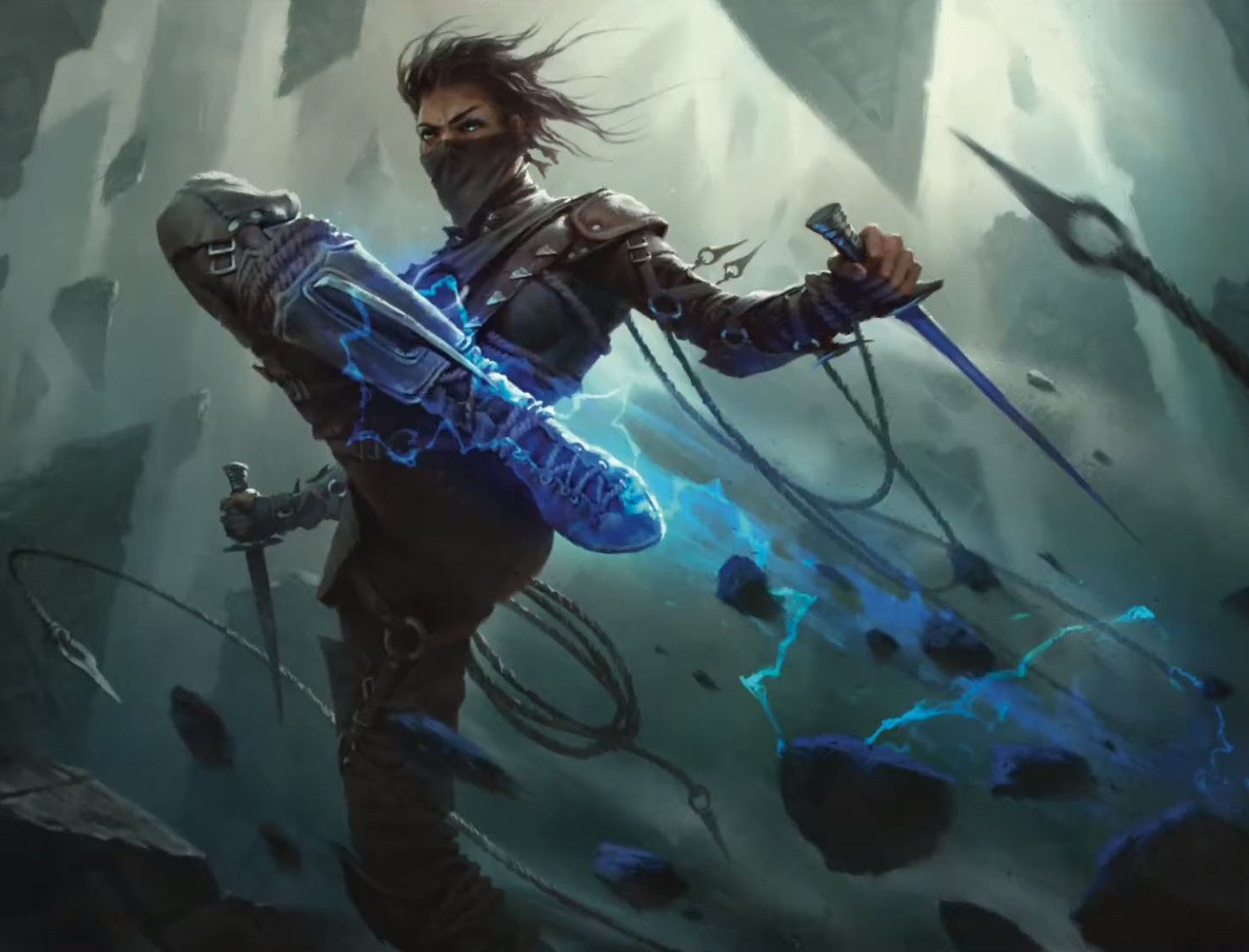


TM and copyright Wizards of the Coast
From www.artofmtg.com
Arcane Maneuvers
| Maneuver | Effect |
|---|---|
| Aim | Add d4 to your roll for this attack |
| Agony | Add your spellcasting bonus to any damage from this attack |
| Bind | On a successful hit, your target makes a Strength save. If they succeed, their movement is halved until the end of their next turn. If they success it is reduced to 0 until the end of their next turn |
| Blinding | On a successful hit, your target makes a Wisdom save. If they fail, you are invisible to them until the end of their next turn |
| Blink | On a successful hit, you may use your bonus action to teleport up to 15’ |
| Blade | You may use your bonus action to make an additional spell melee attack dealing 1d6 + your spellcasting modifier |
| Blast | If you miss, you still deal half damage |
| Connection | On a successful hit, you learn one useful fact abut your target (ability, weakness, reinforcements, plot, etc); on a miss you can communicate a short message (you don't need to share a language to be understood) |
| Detection | As your weapon passes through the air, it reveals the presence of magic as if Detect Magic was cast |
| Distraction | On a successful hit, your target makes a Wisdom save. If they fail, their next attack has disadvantage, until the start of your next turn. |
| Drain | On a successful hit, you gain temporary HP for 1 minute equal to half the damage dealt |
| Focus | On a successful hit, your target makes a Constitution save. If they fail, they take 50% additional damage |
| Guard | On a successful hit, the first time you're attacked before the start of your next turn, the attacker is dealt damage equal to your spellcasting modifier + you Proficiency Bonus |
| Mark | Until the start of your next turn, the next attack against your target has advantage |
| Punch | On a successful hit, your target is moved up to 10 ft away from you |
| Reach | Your attack has a reach of 10 ft and on a successful hit you may make an opportunity attack against any creature that moves within 10 ft of you |
| Shield | You gain +2 to your AC on the first attack against you until the start of your next turn |
| Sight | On a successful hit, you reveal the True Form of your target until the start of your next turn |
| Slam | On a successful hit, your target makes a Strength save. If they fail, they fall prone |
| Smite | On a successful hit, you may expend a spell slot to add 1d8 damage per level of spell slot |
| Spark | On a successful hit, your target, or different target within 30 ft, makes a Dexterity save. If they fail, they take (an additional) half the damage dealt by your original attack |
| Spike | Your attack ignores temporary HP and, on a successful hit, your target cannot regain HP until after end of next turn |
| Spray | On a successful hit, you deal damge equal to your spellcasting bonus to any targets within 10 ft of your target |
| Strike | Add your Proficiency Bonus to any damage from this attack |
| Switch | On a successful hit, you switch position with your target |
| Ward | Until the start of your next turn, if the next attack against you succeeds, you take half damage from it |
| Whip | Your attack has a reach of 15 ft and on a successful hit you may move your target up to 10 ft towards you |
| Prismatic Strike | Chose any damage type. The damage dealt by this attack is of that damage type |
Appendix E: Character Creation & Progression
Some of the options here increase flexibility in character creation and progression to allow greater customization of your character. Others are experimental options aiming to improve balance or simplify mechanics. These options add to those of recent fifth edition sourcebooks.
Customizing Ability Scores
Allowing customization of ability scores across a wider range can better represent a player's strengths and weaknesses, although there may be a temptation to over-optimize. If you want to enable a wider range, without trusting to a dice roll, you can use a system that aims to match the distribution of scores to what you might expect from balanced rolling. Two such systems are shown below. For either, you may wish to restrict just how wide a range is available (e.g. 6 to 16).
Paired Scores
Here you may choose any advantageous score, so long as you match it with a disadvantageous score that is at least as rare. The standard "best-3-of-4d6" roll has a skewed distribution, so the average (mean) roll is just over 12 (rather than the central 10.5 of a straight 3d6 roll) and 12 is also the middle (median) roll. Matched probabilities are listed in the table below. Your character starts with 12 in all six ability scores and you may replace a 12 with any higher number, so long as you replace a different 12 with the matched lower number.
Best-3-of-4d6 Distribution
| Selected Score | Probability of rolling this, or higher | Matched Score | Probability of rolling this, or lower |
|---|---|---|---|
| 18 | 1.6% | 5 | 1.2% |
| 17 | 5.8% | 7 | 5.7% |
| 16 | 13.0% | 8 | 10.5% |
| 15 | 23.1% | 9 | 17.5% |
| 14 | 35.5% | 10 | 26.9% |
| 13 | 48.8% | 11 | 38.3% |
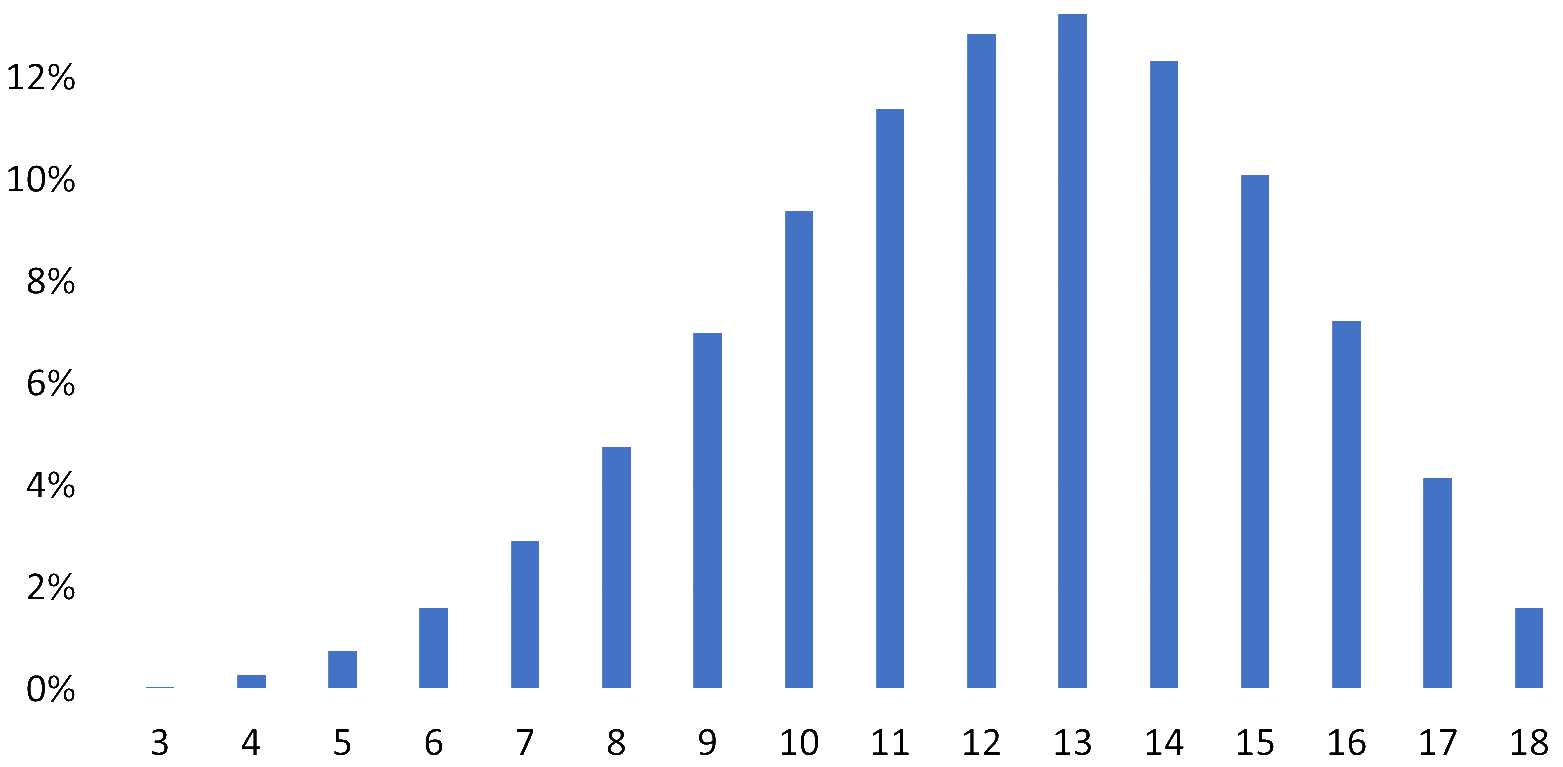
3d6 Distribution
Since the additional flexibility allows additional optimization, you may find a "best-3-of-4d6" distribution too generous. Here is the equivalent table for a straight 3d6 distribution.
| Selected Score | Probability of rolling this, or higher | Matched Score | Probability of rolling this, or lower |
|---|---|---|---|
| 18 | 0.5% | 3 | 0.5% |
| 17 | 1.9% | 4 | 1.9% |
| 16 | 4.6% | 5 | 4.6% |
| 15 | 9.3% | 6 | 9.3% |
| 14 | 16.2% | 7 | 16.2% |
| 13 | 25.9% | 8 | 25.9% |
| 12 | 37.5% | 9 | 37.5% |
| 11 | 50% | 10 | 50% |
Points System
If you want even more flexibility, you can use a points system across the six ability scores, rather than having to use matched pairs. The points system described here bases the difference from one score to the next on the difference in probably of rolling that high (or low) if 4d6 were used.
The cost for any given ability score value is listed in the table below, with a 12 as no cost. You may choose any six ability score values such that the total cost is 0 or less.
Best-3-of-4d6 Distribution
| Score | Cost |
|---|---|
| 3 | -28 |
| 4 | -21 |
| 5 | -16 |
| 6 | -12 |
| 7 | -9 |
| 8 | -7 |
| 9 | -5 |
| 10 | -3 |
| Score | Cost |
|---|---|
| 11 | -1 |
| 12 | 0 |
| 13 | +1 |
| 14 | +2 |
| 15 | +4 |
| 16 | +7 |
| 17 | +10 |
| 18 | +16 |
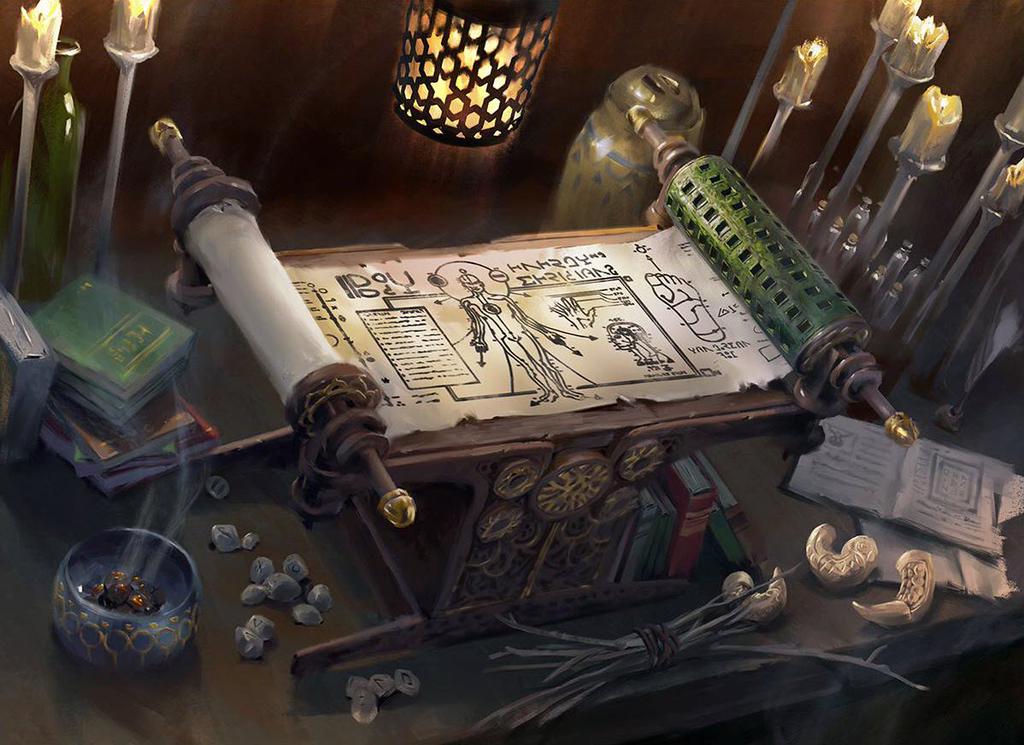


TM and copyright Wizards of the Coast
(The underlying model uses a log transformation of the proportional difference in probability of achieving at least that value (either per step or from median). Log(1.26) scales the minimum change (12 to 13) to 1. Rounded points were then subjectively rationalized between the cumulative points per step and exact points from the median.)
3d6 Distribution
| Score | Cost |
|---|---|
| 3 | -42 |
| 4 | -30 |
| 5 | -22 |
| 6 | -16 |
| 7 | -11 |
| 8 | -7 |
| 9 | -4 |
| 10 | -1 |
| Score | Cost |
|---|---|
| 11 | +1 |
| 12 | +4 |
| 13 | +7 |
| 14 | +11 |
| 15 | +16 |
| 16 | +22 |
| 17 | +30 |
| 18 | +42 |
(Here, log(1.12) scales the minimum change (10 to 11) to 2, which is needed to allow the central value of 10.5 to be "0".)
Saving Throw Proficiencies
With this option, players may choose their own saving throw proficiencies, to reflect that their character's focus in training may differ from others within the same class (whether due to their archetype or their individual character).
Choose one of Dexterity, Constitution, or Wisdom, and one of Strength, Intelligence, or Charisma. Since this reflects your training focus, you may only choose ability scores that are 13 or higher.
As an additional option to allow that focus to change over time, you may change one selection whenever you have the Ability Score Improvement feature from gaining a level.
For campaigns with a more epic feel, or to improve balance, especially at higher levels, you may wish to use half-proficiency for all other saves.
Four Ability Scores
This very unorthodox experimental option reduces the six ability scores to just four, but is not quite as radical as it initially sounds.
Constitution is removed and its use replaced by Strength (except concentration checks, which use your spell modifier).
Charisma is also removed and its skills are distributed amongst the four remaining stats:
- Deception moves to Intelligence,
- Intimidation to Strength,
- Performance to Dexterity,
- and Persuasion to Wisdom.
For spellcasters that previously used Charisma:
- Warlocks use Intelligence,
- Paladins use Wisdom,
- while Bards and Sorcerers may choose either.
Charisma and Intelligence saves both now use Wisdom and you gain just one save proficiency from your class, either Strength (including Constitution), Dexterity or Wisdom
(including Intelligence & Charisma). The same could apply for monsters but it's easier to use existing stat blocks.
Overall, this change aims to improve balance between the scores and involve more classes in relevant social challenges.
Intelligence Proficiencies
With this common variant, added here for convenience, you start with an additional number of tool or language proficiencies equal to your Intelligence modifier.
Training & Versatility
As you progress through your levels, your interests, focuses and specializations progress and may shift and evolve. To reflect this, during downtime after you gain a level, you may gain a half-proficiency in a skill (half proficiency bonus), language (limited communication) or tool (half proficiency bonus; also advantage if at least half-proficient in the relevant skill) of your choice. If you already have half-proficiency, you gain full proficiency.
Subclass Flexibility
You may change subclass whenever you gain the subclass feature. You gain the first subclass feature(s) of the new subclass. If you return to a subclass, you continue from the last feature you received.
Multiclassing Commitment
Consider requiring a minimum number of levels (somewhere between 2 and 5) in a class for these to be kept if a character then gains levels in another class.
Simplified XP
A simplified method for awarding XP, derived from a post by Acromir. Any time the party overcomes a challenge, whether combat, exploration, social, or even crafting, simply decide on the difficulty: Easy, Medium, Hard, or Deadly and award each player the XP listed against the party's average level on the "XP Threshold by Character Level" table in the Dungeon Master's Guide† (Wizards of the Coast).
If different PCs contributed significantly more or less, or had more or less challenge / risk, you can award individually.



TM and copyright Wizards of the Coast
Part 4
Archive
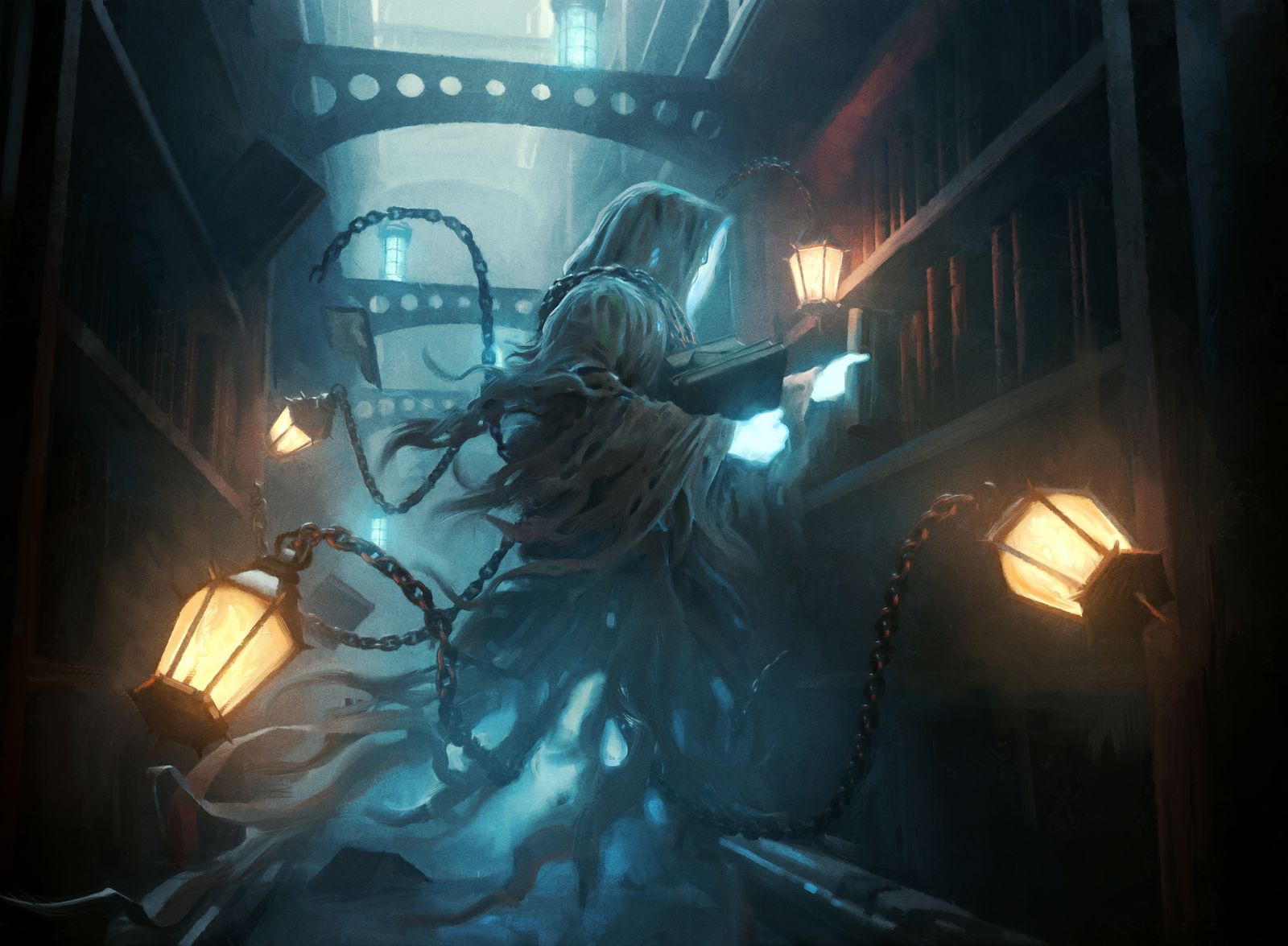

TM and copyright Wizards of the Coast
From www.artofmtg.com
The Archive
As this Tome evolves, some of the original options are being retired to this archive. They remain popular in the feedback and the modular nature of the Tome means that you can always still use them in place of the newer options. However they're being separated out into this archive to simplify the organization of the main Tome around their newer replacements.
Variant Defense - Defense Dice
This was the defense option in the previous edition of the Tome, before the Defence bonus action replaced it.
Instead of using a bonus action or gaining defense rolls, you gain a supply of defense dice that you can spend to add to your AC when attacked (additional dice may be used for other attacks or to re-roll, keeping the highest roll). The number and size of defense dice increase with level and class abilities, and their use and availability depend on actions in combat.
You gain a number of defense dice equal to the number of attacks you can make with the Attack action; these are d4s at 1st level, increasing to d6s from 8th level. You gain these dice at the beginning of combat (expiring if not used by the start of your next turn) and regain them when you take a melee action (melee attack, Help or Disengage, or Ready action for any of those or for movement). You don't gain defense dice from non-melee actions (ranged attack, Dash, Hide, Search, Spell, Use an Object, or Ready action for any of those).
Since your pool of defense rolls reflect the actions you took, certain actions already limit your ability to defend yourself and there is less need to also include those actions in Leaving Yourself Open (page 14), so just use the movement triggers there.
Finally, a -2 correction factor to players' AC maintains balance with monsters and the core rules.
If you choose to use this variant, you may wish to use a previous edition of the Tome (e.g. v5.2), which is organized around this as a core feature.
Combat Stance
You also gain a defense die when you Fend or Disengage as a bonus action (e.g. with Cunning Action), and you may forgo any number of melee attacks from your Attack action (and/or bonus action if your bonus action grants you a melee attack) to gain an additional defense die for each. Conversely, you may spend a defense die to add to one of your melee damage rolls, or spend two defense dice to add a die to one of your melee attack rolls.
Dodge
In this variant, Dodge does not impose disadvantage on attack rolls made against you, but instead gives you double your usual number of defense dice, which you may also use against ranged attacks, but you still make Dexterity Saving Throws with advantage.
Evasive Fighting Style
With the Evasive fighting style, you may use defense dice against ranged attacks and may use your reaction to gain a defense die (or reroll a defense die).
Variant Defense - Proficiency
This variant was the original defense option in early editions of the Tome, before the Defense Dice option replaced it. Instead of using a supply of defensive dice, a constant defensive bonus (your proficiency bonus) is added to your AC. A slightly bigger correction factor is needed for this (-4 as opposed to the -2 with defense dice).
So a level 6 fighter (proficiency bonus of +3), with a Dexterity of 14 (ability modifier of +2), and wearing breastplate armor (base AC 14), has a AC of 14 +2 +3 -4 = 15.
At lower levels, this will slightly increase the chance of being hit (and the chance of higher damage from Degree of Success). While at higher levels, the chance will slightly decrease. These effects balance well with the Gritty Progression option (page 8), so the options are best used together.
If you choose to use this variant, you may wish to use a previous edition of the Tome (e.g. v2.0), which is organized around this as a core feature.
Proficiency Dice
A hybrid variant of the Defense and Defense Dice options is to use a proficiency die ("Proficiency Dice" option, Dungeon Master's Guide†, Wizards of the Coast) for the defense proficiency bonus. Players roll this proficiency die when defending, instead of applying the fixed proficiency bonus to their AC (the fixed -4 correction factor is still used).
As with Defense Dice, you may wish to restrict this to defenders who had taken a melee action on their turn.
Rolling your chance to influence an attack (and, with Degree of Success, its damage) allows players to feel more
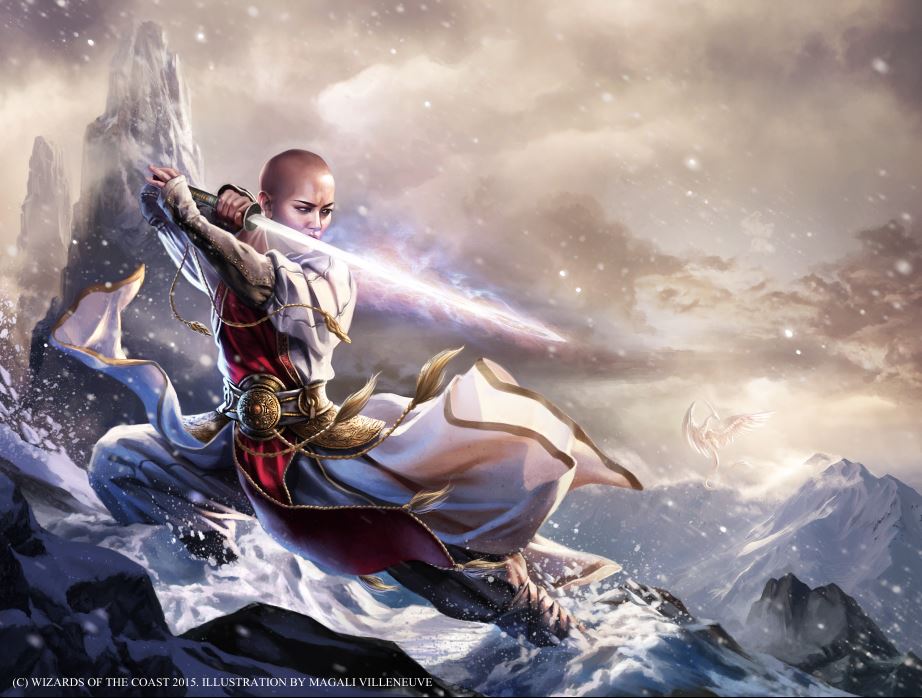


TM and copyright Wizards of the Coast
involved outside of their own turn and drove the popularity of this variant, as well as the development of the subsequent Defense options.
To improve bounded accuracy, it's better if expertise means you roll your proficiency die with advantage (rather than adding a second die roll to the total). Accordingly, making a d20 roll with advantage or disadvantage does not affect the proficiency die used with the roll (or in defense against it).
Combat Stance
For these proficiency defense variants, the combat stance options use proficiency bonus instead of defense dice:
Defensive Stance
When taking the Attack action with a melee weapon, for every 2 proficiency bonus points sacrificed from attack bonus, add 1 to your AC, until your next turn.
Aggressive Stance
Or, visa versa, when taking the Attack action with a melee weapon, for every 2 proficiency bonus points sacrificed from AC (Defense option), add 1 to your attack bonus for melee attacks, until your next turn.
Alternative When Using Proficiency Dice
When you take the Attack action with a melee weapon, you may omit your proficiency bonus/dice for all attacks until the start of your next turn, to have advantage on defense proficiency die rolls during that time. Or, visa versa, the first time you're attacked outside your turn, you may omit your defense proficiency dice until the end of your next turn to have advantage on melee attack proficiency die rolls.
Limited Defense
If an individual can’t defend to their full ability, you may wish their defensive proficiency bonus to reflect this:
- Defender unable to use weapon / shield (e.g. arms bound): Adjust AC by removing bonuses from the shield (and/or weapon) and their proficiency bonus (Defense option).
- Defender unable to move freely (e.g. legs bound): Attacker rolls with advantage as per standard rules. Also remove any (positive) Dexterity bonus from defender's AC.
- Defender unable to move body / react (e.g. restrained or stunned): Both of the above apply.
- Defender fully immobilized (e.g. paralyzed or unconscious): All of the above apply plus any attack at a range of 5 ft or less is automatically a critical hit.
- A defender who actively ignores a melee attacker is treated as restrained for that attack.
Monsters
These defense variants are best used only for players and perhaps some NPCs. But if you do want to use them with monsters, use the same -4 correction factor, leading to the AC adjustment in the table below. Although proficiency dice can also be used for monsters, it is easier and faster for the DM to use the fixed proficiency bonuses for monsters.
Monster Defense by Challenge Rating
| CR | Proficiency Bonus | AC Adjustment |
|---|---|---|
| 0-4 | +2 | -2 |
| 5-8 | +3 | -1 |
| 9-12 | +4 | no change |
| 13-16 | +5 | +1 |
| 17-20 | +6 | +2 |
| 21-24 | +7 | +3 |
| 25-28 | +8 | +4 |
| 29-30 | +9 | +5 |
Alternative Degree of Success Tables for Combat
| Roll | Standard | Consistent | Simplified | Reduced | DR* | Armor Halves |
|---|---|---|---|---|---|---|
| Critical Fail (10-) | Fumble | Fumble | Fumble | Fumble | Fumble | Fumble |
| Heavy Failure (5-) | (Miss) | Miss | (Miss) | (Miss) | (Miss) | (Miss) |
| Failure (1-) | Miss | Weak Strike - quarter damage | Miss | Miss | Miss | Miss |
| Marginal (0) | Glancing Blow - half damage | Glancing Blow - half damage | Weak Strike - quarter damage | Weak Strike - quarter damage | Glancing Blow - half damage minus DR* | Glancing Blow - half damage |
| Success (1+) | Hit - usual damage | Hit - usual damage | Glancing Blow - half damage | Glancing Blow - half damage | Hit - usual damage minus DR* | Hit - half damage if light armor or better |
| Strong Success (5+) | Strong Hit - damage rolled with advantage | Strong Hit - damage rolled with advantage | Hit - usual damage | Hit - usual damage | Hit - usual damage | Hit - half damage if medium armor or better |
| Critical Success (10+) | Critical Hit - maximum damage | Critical Hit - maximum damage | Critical Hit - maximum damage | Strong Hit - damage with advantage; use maximum if natural 20 | Critical Hit - maximum damage | Hit - half damage if heavy armor |
Being Outnumbered
It's harder to defend against an opponent if you also need to pay attention to other potential assailants.
The Help action and abilities like Pack Tactics can partially represent this, as can optional flanking rules. Defense rolls and defense dice provide an alternative to flanking: the number of rolls / dice are limited and represent how you divide your defensive focus). However, two other simple alternatives are suggested here if you're not using the defense rolls or defense dice options.
(For these options, a melee group is a group where each creature is within reach of at least one opponent in the group.)
Variant 1: Advantage
If during an attacker's turn, their side outnumbers the opponents by at least 2:1 in that melee group (so at least double as many attackers as opponents), then the attacker has advantage on attack rolls against those opponents.
Variant 2: Attack Bonus Modifier
This variant uses attack bonus modifiers rather than advantage. If during an attacker's turn, their side outnumbers the opponents in that melee group, then the attacker gains a +1 to their attack bonus against those opponents. If their side outnumbers the opponents by 2:1, they gain +2 instead. If 3:1, they gain +3, and so on up to a maximum of +5.
Gritty Spell Success Table
If your campaign setting has rarer, less reliable magic, then you may wish to use this original, grittier version of the spellcasting Degree of Success table:
| Roll | Spells with a Target | Other Spells |
|---|---|---|
| Critical Failure (10-) | Critical Misfire: switch target to you, or from you to a random target. You can’t cast further spells of that level or higher until you finish a short or long rest | Critical Surge: you, and others within 30 ft, take 1d6 force damage for each level of the spell. You can’t cast further spells of that level or higher until you finish a short or long rest |
| Heavy Failure (5-) | Misfire: switch to a random other target | Surge: take 1d4 force damage for each level of the spell |
| Failure (1-) | Fizzles | Fizzles |
| Marginal (0) | Very odd appearance. Disadvantage on spell attack roll. Advantage on saves against spell | Very odd appearance. Disadvantage on spell attack roll. Advantage on saves against spell |
| Success (1+) | Acceptable appearance | Acceptable appearance |
| Strong Success (5+) | Appears exactly as described | Appears exactly as described |
| Critical Success (10+) | Perfect. You may reroll any one roll within the spell, and choose which roll is used | Perfect. You may reroll any one roll within the spell, and choose which roll is used |
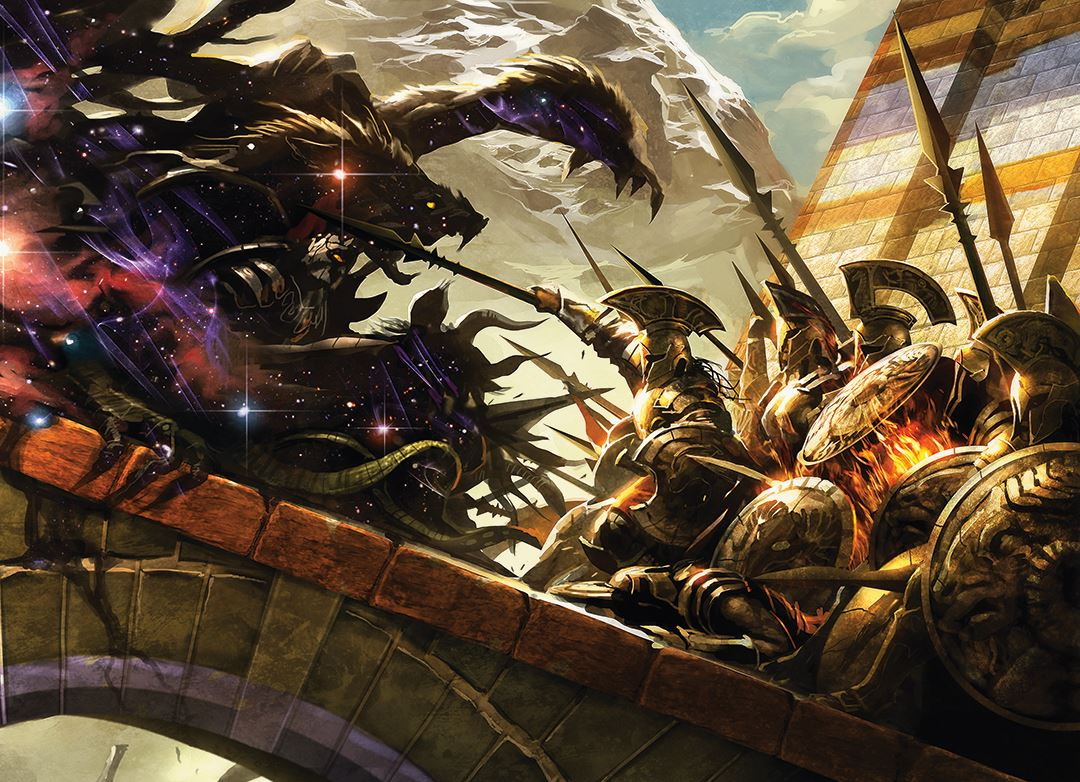

TM and copyright Wizards of the Coast
From www.artofmtg.com
Rolling Success & 3d20
Degree of Success uses steps of +/- 5 to split success and failure into a spectrum from critical success through to critical failure. Steps of +/- 5 are easy to work with in-game and if you want to test out the math to see the chance of each result, that's easy to calculate (tables below).
Two other systems were playtested that involved rolling the degree of success. Each was initially very popular with some groups but then fell out of use. This was partly due to the additional rolls required and partly because effects that apply modifiers after a roll are more easily calculated with a single dice.
For those still using either variant, or interested in the math and mechanics underlying them, here's an in-depth look at the performance characteristics of the various degree of success methods.
Variant 1: Rolling Success
"Rolling Success" was a variant that used a second roll instead of counting +/- 5. Simply roll again after a success: a second success is a strong success; and if the second roll is also higher than the first, then it's a critical success. Likewise roll again after a fail: a second fail is a heavy failure; and if the second roll is also lower, then it's a critical failure. An exact roll is marginal (no second roll needed).
| Main Roll | Second Roll | Outcome |
|---|---|---|
| Fail | Lower | Critical Failure |
| Fail | Fail | Heavy Failure |
| Fail | Succeed | Failure |
| Exact roll | - | Marginal |
| Succeed | Fail | Success |
| Succeed | Succeed | Strong Success |
| Succeed | Higher | Critical Success |
Advantage & Disadvantage
If rolling with advantage or disadvantage, or with any reroll effect, these only apply to the main roll. You then make a single Rolling Success roll to determine degree of success (unless already a marginal success). If the main roll was with advantage, then use the most helpful main dice roll when comparing for critical success or failure. If the main roll was with disadvantage, then use the least helpful main dice roll.
"Rolling Success" is readily interchangeable with the steps of +/- 5 option, fits the fifth edition aesthetic, and was popular with some playtest groups.
Variant 2: 3d20
"3d20" is a second variant where three d20s are rolled instead. The majority roll determines success or failure. Strong success if all three succeed and a critical success if any of those is a natural 20. Heavy failure if all three fail and a critical failure if any of those are a natural 1. A marginal result occurs when there is a simple success (two of three d20s succeed) but at least one roll is exact.
| Roll | Also | Outcome |
|---|---|---|
| (--+ | A natural 1 | Critical Failure) |
| --- | A natural 1 | Critical Failure |
| --- | Heavy Failure | |
| --+ | Fail | Failure |
| -++ | An exact roll | Marginal |
| -++ | Success | |
| +++ | Strong Success | |
| +++ | A natural 20 | Critical Success |
| (-++ | A natural 20 | Critical Success) |
Advantage & Disadvantage
If rolling with advantage or disadvantage, simply roll four d20s and remove the lowest (advantage) or highest (disadvantage) roll. For any reroll effect, you may choose to reroll all the dice, or to reroll just one dice of your choice.
Some playtest groups liked the more reliable outcome of a "two out of three" rolling system for skill checks but it was less popular for combat. If you do want that reliability for skill checks, a simpler approach is to replace the standard d20 roll with 2d10 or 3d6.
Comparing Probabilities
In the charts on the next page, Rolling Success and 3d20 are compared with the standard option (steps of +/- 5) across the full range of target values for a d20 roll (this range is wider than you're likely to encounter, since bounded accuracy keeps the target "to hit" value of most rolls somewhere around a 9 on a d20). The second chart shows the effect of also using a natural 1 or 20 as a critical failure or success for the steps of +/- 5 or Rolling Success systems, or for including criticals that occurs with a split result (- - + fail or - + + success) when using the 3d20 system.
The correlation between steps of +/- 5 and Rolling Success is very good, especially at less extreme target rolls.
Treating a natural 1 or 20 as a critical failure or success only has a small effect when using steps of +/- 5, ensuring that there is always at least a 5% chance of these but not otherwise affecting the odds. It has a larger effect for Rolling Success as it raises the chance of a critical failure or success by 5% at every target value, making these too frequent at common target values such as 9.
"3d20" has a less linear scaling than the other two methods and critical failure or success is too infrequent if limited to - - - and + + + rolls, so it's better to also include - - + and - + + rolls.
Conclusion
Steps of +/- 5, with the addition of a natural 1 or 20 as a critical failure or success, is recommended as the main variant. Rolling Success (best used without an additional effect from a natural 1 or 20) and 3d20 (with criticals as above), are workable alternatives but are no longer recommended.
If No Additional Effect From a Natural 1 or 20
| Target | 1+ | 2+ | 3+ | 4+ | 5+ | 6+ | 7+ | 8+ | 9+ | 10+ | 11+ | 12+ | 13+ | 14+ | 15+ | 16+ | 17+ | 18+ | 19+ | 20 |
|---|---|---|---|---|---|---|---|---|---|---|---|---|---|---|---|---|---|---|---|---|
| Steps +/- 5 | ||||||||||||||||||||
| Critical Hit % | 50 | 45 | 40 | 35 | 30 | 25 | 20 | 15 | 10 | 5 | 0 | 0 | 0 | 0 | 0 | 0 | 0 | 0 | 0 | 0 |
| Strong Hit % | 25 | 25 | 25 | 25 | 25 | 25 | 25 | 25 | 25 | 25 | 25 | 20 | 15 | 10 | 5 | 0 | 0 | 0 | 0 | 0 |
| Success Roll | ||||||||||||||||||||
| Critical Hit % | 43 | 38 | 34 | 30 | 26 | 23 | 19.5 | 16.5 | 14 | 11 | 9 | 7 | 5 | 4 | 2.5 | 1.5 | 0.75 | 0.25 | 0 | 0 |
| Strong Hit % | 52 | 47 | 42.5 | 38 | 34 | 30 | 26 | 22.5 | 19 | 16 | 13.5 | 11 | 9 | 7 | 5 | 3.5 | 2 | 1 | 0.5 | 0 |
| 3d20 | ||||||||||||||||||||
| Critical Hit % | 15 | 13 | 11.5 | 10 | 9 | 8 | 7 | 6 | 5 | 4 | 3.5 | 3 | 2 | 1.5 | 1 | 0.75 | 0.5 | 0.25 | 0.1 | 0.01 |
| Strong Hit % | 85 | 73 | 61 | 51 | 42 | 34 | 27.5 | 21.5 | 16.5 | 12.5 | 9 | 6.5 | 4 | 3 | 1.5 | 1 | 0.5 | 0.1 | 0.01 | 0 |
If A Natural 1 or 20 Is Always a Critical Failure or Success
| Target | 1+ | 2+ | 3+ | 4+ | 5+ | 6+ | 7+ | 8+ | 9+ | 10+ | 11+ | 12+ | 13+ | 14+ | 15+ | 16+ | 17+ | 18+ | 19+ | 20 |
|---|---|---|---|---|---|---|---|---|---|---|---|---|---|---|---|---|---|---|---|---|
| Steps of +/- 5 | ||||||||||||||||||||
| Critical Hit % | 50 | 45 | 40 | 35 | 30 | 25 | 20 | 15 | 10 | 5 | 5 | 5 | 5 | 5 | 5 | 5 | 5 | 5 | 5 | 5 |
| Strong Hit % | 25 | 25 | 25 | 25 | 25 | 25 | 25 | 25 | 25 | 25 | 20 | 15 | 10 | 5 | 0 | 0 | 0 | 0 | 0 | 0 |
| Success Roll | ||||||||||||||||||||
| Critical Hit % | 48 | 43 | 39 | 35 | 31 | 28 | 24.5 | 21.5 | 19 | 16 | 14 | 12 | 10 | 9 | 7.5 | 6.5 | 6 | 5 | 5 | 5 |
| Strong Hit % | 47 | 42.5 | 38 | 34 | 30 | 26 | 22.5 | 19 | 16 | 13.5 | 11 | 9 | 7 | 5 | 3.5 | 2 | 1 | 0.5 | 0 | 0 |
| 3d20 | ||||||||||||||||||||
| Critical Hit % | 15 | 14 | 14 | 14 | 14 | 13.5 | 13 | 13 | 12 | 11.5 | 11 | 10 | 9 | 8.5 | 7.5 | 6.5 | 5 | 4 | 3 | 1.5 |
| Strong Hit % | 85 | 73 | 61 | 51 | 42 | 34 | 27.5 | 21.5 | 16.5 | 12.5 | 9 | 6.5 | 4 | 3 | 1.5 | 1 | 0.5 | 0.1 | 0.01 | 0 |
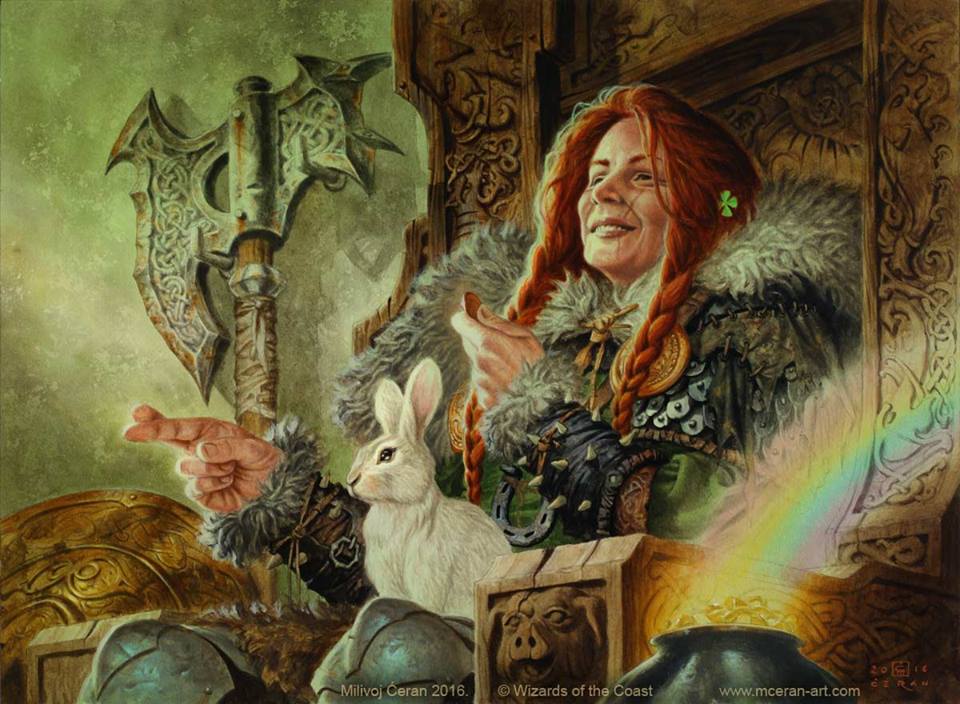

TM and copyright Wizards of the Coast
From www.artofmtg.com

Tinkering with
the Mechanics
of 5e
A cohesive set of modular rules options that expand on core game mechanics, adding compatible depth, while keeping the distinctive feel of fifth edition.
Each option can stand alone or as an integral part of the wider ruleset, simply pick-and-mix to suit your group's taste and style.
Includes variant mechanics for:
Degree of Success
• Ability Checks
• Saving Throws
• Advantage & Disadvantage
• Combat
• Defense & Tactics
• Damage & Healing
• Spellcasting
• Overexertion
• Equipment & Weapons
• Feats
• Character Creation
Unofficial variant rules craft homebrewed for use with fifth edition Dungeons & Dragons®
Design: GM Binder (inc layout & graphics)
Cover: Tome of the Guildpact by Randy Gallegos
Art: Wizards of the Coast Fan Content Policy
(TM & © Wizards of the Coast)